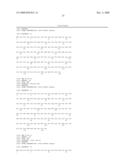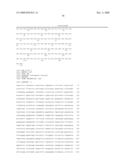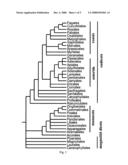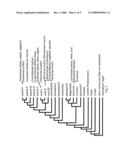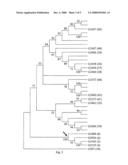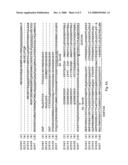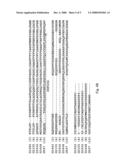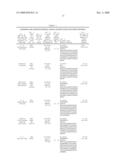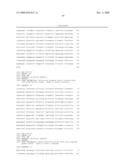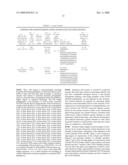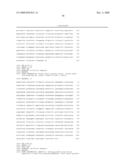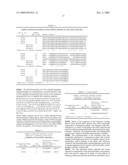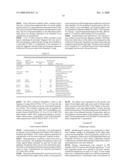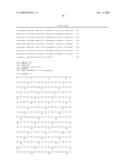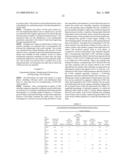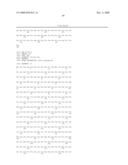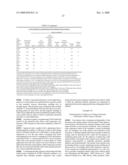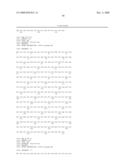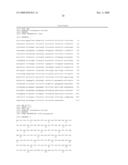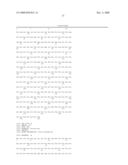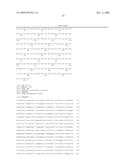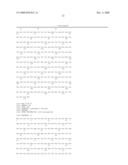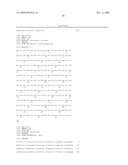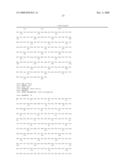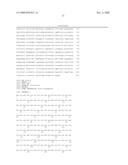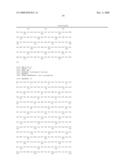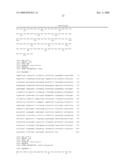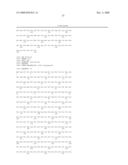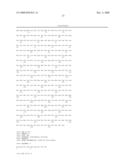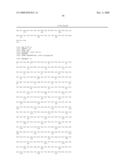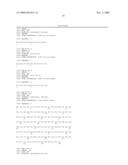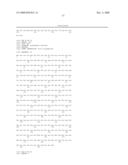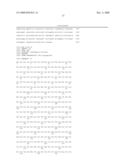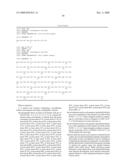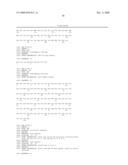Patent application title: Plants with improved yield and stress tolerance
Inventors:
Oliver J. Ratcliffe (Oakland, CA, US)
Roderick W. Kumimoto (Norman, OK, US)
Cai-Zhong Jiang (Fremont, CA, US)
Jeffrey M. Libby (Cupertino, CA, US)
Robert Creelman (Castro Valley, CA, US)
Peter P. Repetti (Emeryville, CA, US)
T. Lynne Reuber (San Mateo, CA, US)
Neal I. Gutterson (Oakland, CA, US)
Ganesh Kumar (Chesterfield, MO, US)
Balasulojini Karunanandaa (Creve Coeur, MO, US)
Balasulojini Karunanandaa (Creve Coeur, MO, US)
Karen Gabbert (St. Louis, MO, US)
Assignees:
Mendel Biotechnology, Inc.
IPC8 Class: AC12N1529FI
USPC Class:
800289
Class name: Multicellular living organisms and unmodified parts thereof and related processes method of introducing a polynucleotide molecule into or rearrangement of genetic material within a plant or plant part the polynucleotide confers resistance to heat or cold (e.g., chilling, etc.)
Publication date: 2008-12-04
Patent application number: 20080301841
Claims:
1. A nucleic acid construct comprising a recombinant nucleic acid sequence
encoding a polypeptide, wherein:the polypeptide shares an amino acid
identity with any of SEQ ID NO: 2, 4, 6, 8, 13, 14, 15 or 16, wherein the
percent amino acid identity is selected from the group consisting of at
least about 51%, at least about 51.9%, at least about 52%, at least about
53%, at least about 54%, at least about 55%, at least about 56%, at least
about 57%, at least about 58%, at least about 59%, at least about 60%, at
least about 61%, at least about 62%, at least about 63%, at least about
64%, at least about 65%, at least about 66%, at least about 67%, at least
about 68%, at least about 69%, at least about 69.6%, at least about 70%,
at least about 71%, at least about 72%, at least about 73%, at least
about 73.6%, at least about 74%, at least about 75%, at least about 76%,
at least about 77%, at least about 78%, at least about 79%, at least
about 80%, at least about 81%, at least about 82%, at least about 83%, at
least about 84%, at least about 85%, at least about 86%, at least about
87%, at least about 87.2%, at least about 88%, at least about 89%, at
least about 90%, at least about 91%, at least about 92%, at least about
93%, at least about 94%, at least about 95%, at least about 96%, at least
about 97%, at least about 97.6%, at least about 98%, at least about 99%,
and about 100%; orthe recombinant nucleic acid sequence specifically
hybridizes to the complement of the sequence set forth in SEQ ID NO: 1,
3, 5, or 7 under stringent conditions comprising two wash steps at least
as stringent as 6.times.SSC at 65.degree. C. of 10-30 minutes for each
wash step; orthe recombinant nucleic acid sequence specifically
hybridizes to the complement of the sequence set forth in SEQ ID NO: 1,
3, 5, or 7 under stringent conditions comprising two wash steps of 0.2 to
2.0.times.SSC at 50 to 65.degree. C. for 10-30 minutes per wash
step;wherein when the nucleic acid construct is introduced into a plant,
the encoded polypeptide regulates transcription and confers at least one
regulatory activity resulting in an altered trait in the plant as
compared to a control plant, and the altered trait is selected from the
group consisting of: greater size, greater organ size, greater biomass,
greater yield, curlier leaves, darker coloration, greater tolerance to
water deprivation, more delayed flowering, more delayed development, more
delayed senescence, greater tolerance to cold, and greater tolerance to
hyperosmotic stress.
2. The nucleic acid construct of claim 1, wherein the stringent conditions comprising two wash steps of 0.5.times.SSC, 0.1% SDS at 65.degree. C. of 10-30 minutes for each wash step
3. The nucleic acid construct of claim 1, wherein the polypeptide comprises SEQ ID NO: 24.
4. The nucleic acid construct of claim 1, wherein the polypeptide comprises SEQ ID NO: 6.
5. The nucleic acid construct of claim 1, wherein expression of the polypeptide is regulated by a constitutive, inducible, or tissue-specific promoter.
6. The nucleic acid construct of claim 1, wherein the nucleic acid construct is comprised within a recombinant host cell.
7. A transgenic plant having an altered trait of greater size, greater biomass, greater yield, curlier leaves, darker coloration, greater tolerance to water deprivation, more delayed flowering, more delayed development, more delayed senescence, greater tolerance to cold, or greater tolerance to hyperosmotic stress, as compared to a control plant, wherein the transgenic plant comprises:a nucleic acid construct comprising a recombinant nucleic acid sequence encoding a polypeptide, wherein:the polypeptide shares an amino acid identity with any of SEQ ID NO: 2, 4, 6, 8, 13, 14, 15 or 16, wherein the percent amino acid identity is selected from the group consisting of at least about 51%, at least about 51.9%, at least about 52%, at least about 53%, at least about 54%, at least about 55%, at least about 56%, at least about 57%, at least about 58%, at least about 59%, at least about 60%, at least about 61%, at least about 62%, at least about 63%, at least about 64%, at least about 65%, at least about 66%, at least about 67%, at least about 68%, at least about 69%, at least about 69.6%, at least about 70%, at least about 71%, at least about 72%, at least about 73%, at least about 73.6%, at least about 74%, at least about 75%, at least about 76%, at least about 77%, at least about 78%, at least about 79%, at least about 80%, at least about 81%, at least about 82%, at least about 83%, at least about 84%, at least about 85%, at least about 86%, at least about 87%, at least about 87.2%, at least about 88%, at least about 89%, at least about 90%, at least about 91%, at least about 92%, at least about 93%, at least about 94%, at least about 95%, at least about 96%, at least about 97%, at least about 97.6%, at least about 98%, at least about 99%, and about 100%; orthe recombinant nucleic acid sequence specifically hybridizes to the complement of the sequence set forth in SEQ ID NO: 1, 3, 5, or 7 under stringent conditions comprising two wash steps at least as stringent as 6.times.SSC at 65.degree. C. of 10-30 minutes for each wash step; orthe recombinant nucleic acid sequence specifically hybridizes to the complement of the sequence set forth in SEQ ID NO: 1, 3, 5, or 7 under stringent conditions comprising two wash steps of 0.2 to 2.0.times.SSC at 50 to 65.degree. C. for 10-30 minutes per wash step;wherein when the polypeptide is overexpressed in a plant, the polypeptide regulates transcription and confers at least one regulatory activity resulting in the altered trait in the plant as compared to a control plant.
8. The transgenic plant of claim 7, wherein the polypeptide has at least about 70.7% identity to SEQ ID NO: 15.
9. The transgenic plant of claim 7, wherein the stringent conditions comprising two wash steps of 0.5.times.SSC, 0.1% SDS at 65.degree. C. of 10-30 minutes for each wash step.
10. The transgenic plant of claim 7, wherein the polypeptide comprises SEQ ID NO: 24.
11. The transgenic plant of claim 7, wherein the transformed plant is a eudicot.
12. The transgenic plant of claim 7, wherein the transformed plant is a legume.
13. The transformed plant of claim 7, wherein the transformed plant is a transformed seed comprising the recombinant nucleic acid sequence.
14. A method for conferring to a plant an altered trait of greater size, greater organ size, greater biomass, greater yield, curlier leaves, darker coloration, greater tolerance to water deprivation, more delayed flowering, more delayed development, more delayed senescence, greater tolerance to cold, or greater tolerance to hyperosmotic stress, as compared to a control plant, the method comprising:(a) providing a nucleic acid construct comprising a recombinant nucleic acid sequence encoding a polypeptide, wherein:the polypeptide shares an amino acid identity with any of SEQ ID NO: 2, 4, 6, 8, 13, 14, 15 or 16, wherein the percent amino acid identity is selected from the group consisting of at least about 51%, at least about 51.9%, at least about 52%, at least about 53%, at least about 54%, at least about 55%, at least about 56%, at least about 57%, at least about 58%, at least about 59%, at least about 60%, at least about 61%, at least about 62%, at least about 63%, at least about 64%, at least about 65%, at least about 66%, at least about 67%, at least about 68%, at least about 69%, at least about 69.6%, at least about 70%, at least about 71%, at least about 72%, at least about 73%, at least about 73.6%, at least about 74%, at least about 75%, at least about 76%, at least about 77%, at least about 78%, at least about 79%, at least about 80%, at least about 81%, at least about 82%, at least about 83%, at least about 84%, at least about 85%, at least about 86%, at least about 87%, at least about 87.2%, at least about 88%, at least about 89%, at least about 90%, at least about 91%, at least about 92%, at least about 93%, at least about 94%, at least about 95%, at least about 96%, at least about 97%, at least about 97.6%, at least about 98%, at least about 99%, and about 100%; orthe recombinant nucleic acid sequence specifically hybridizes to the complement of the sequence set forth in SEQ ID NO: 1, 3, 5, or 7 under stringent conditions comprising two wash steps at least as stringent as 6.times.SSC at 65.degree. C. of 10-30 minutes for each wash step; orthe recombinant nucleic acid sequence specifically hybridizes to the complement of the sequence set forth in SEQ ID NO: 1, 3, 5, or 7 under stringent conditions comprising two wash steps of 0.2 to 2.0.times.SSC at 50 to 65.degree. C. for 10-30 minutes per wash step;wherein when the polypeptide is overexpressed in a plant, the polypeptide regulates transcription and confers at least one regulatory activity resulting in the altered trait in the plant as compared to a control plant; and(b) transforming a target plant with the nucleic acid construct to produce a transformed plant having the altered trait as compared to the control plant.
15. The method of claim 14, wherein the methods further comprises the step of:(c) selecting a transgenic plant that ectopically expresses the polypeptide, and/or has greater size, greater biomass, greater yield, curlier leaves, darker coloration, greater tolerance to water deprivation, more delayed flowering, more delayed development, more delayed senescence, greater tolerance to cold, or greater tolerance to hyperosmotic stress than the control plant.
16. The method of claim 14, wherein the plant is more tolerant than the control plant to 8.degree. C. during germination or growth, or to removal of water from the soil or growth medium in which the plant is growing, or removal of the plant at the seedling stage from its growth medium and drying for two hours.
17. The method of claim 14, wherein the polypeptide has at least about 70.7% identity to SEQ ID NO: 15.
18. The method of claim 14, wherein the stringent conditions comprising two wash steps of 0.5.times.SSC, 0.1% SDS at 65.degree. C. of 10-30 minutes for each wash step
19. The method of claim 14, wherein the nucleic acid construct comprises any of SEQ ID NO: 1, 3, 5, or 7.
20. The method of claim 14, wherein the method steps further comprise selfing or crossing the transformed plant with itself or another plant, respectively, to produce transformed seed.
Description:
RELATIONSHIP TO COPENDING APPLICATIONS
[0001]This application (the "present application") claims the benefit of U.S. provisional application 60/961,403, filed 20 Jul. 2007 (pending); and this application is a continuation-in-part of U.S. non-provisional application Ser. No. 10/669,824, filed 23 Sep. 2003 (pending), which is a continuation-in-part of U.S. non-provisional application Ser. No. 09/823,676, filed 30 Mar. 2001 (issued as U.S. Pat. No. 6,717,034); and this application is a continuation-in-part of U.S. non-provisional application Ser. No. 11/728,567, filed 26 Mar. 2007 (pending), which is a division of U.S. non-provisional application Ser. No. 10/225,066, filed 9 Aug. 2002 (issued as U.S. Pat. No. 7,238,860), which claims the benefit of each of U.S. provisional applications 60/310,847, filed 9 Aug. 2001, 60/336,049 filed 19 Nov. 2001, and 60/338,692, filed 11 Dec. 2001, and U.S. non-provisional application Ser. No. 10/225,066 is also a continuation-in-part of both U.S. non-provisional application Ser. No. 09/837,944, filed 18 Apr. 2001 (abandoned), and U.S. non-provisional application Ser. No. 10/171,468, filed 14 Jun. 2002 (abandoned); and this application is a continuation-in-part of U.S. non-provisional application Ser. No. 11/375,241, filed 16 Mar. 2006 (pending), which claims the benefit of U.S. provisional application 60/713,952, filed 31 Aug. 2005 and U.S. non-provisional application Ser. No. 11/375,241 is also a continuation-in-part of 10/225,067, filed 9 Aug. 2002 (issued as U.S. Pat. No. 7,135,616), which claims the benefit each of U.S. provisional applications 60/310,847, filed 9 Aug. 2001, 60/336,049, filed 19 Nov. 2001, and 60/338,692, filed 11 Dec. 2001, and U.S. non-provisional application Ser. No. 10/225,067 is also a continuation-in-part of both U.S. non-provisional application Ser. No. 09/837,944, filed 18 Apr. 2001 (abandoned) and U.S. non-provisional application Ser. No. 10/171,468, filed 14 Jun. 2002 (abandoned); and this application is a continuation-in-part of U.S. non-provisional application Ser. No. 10/374,780, filed 25 Feb. 2003 (pending), which is a continuation-in-part of both U.S. non-provisional application Ser. No. 10/225,066, filed 9 Aug. 2002 (issued as U.S. Pat. No. 7,238,860) and U.S. non-provisional application Ser. No. 10/225,067, filed 9 Aug. 2002 (issued as U.S. Pat. No. 7,135,616); and this application is a continuation-in-part of U.S. non-provisional application Ser. No. 10/546,266, filed 19 Aug. 2005 (pending), which is a '371 national Stage filing of PCT/US2004005654, filed 25 Feb. 2004 (expired), which is a continuation-in-part of U.S. non-provisional application Ser. No. 10/374,780, filed 25 Feb. 2003 (pending); and this application is a continuation-in-part of U.S. non-provisional application Ser. No. 11/642,814, filed 20 Dec. 2006 (pending), which is a division of U.S. non-provisional application Ser. No. 10/666,642, filed 18 Sep. 2003 (issued as U.S. Pat. No. 7,196,245), which claims the benefit of U.S. provisional application 60/434,166, filed 17 Dec. 2002; and this application is a continuation-in-part of U.S. non-provisional application Ser. No. 10/714,887, filed 13 Nov. 2003 (pending), which is a continuation-in-part of U.S. non-provisional application Ser. No. 10/666,642, filed 18 Sep. 2003 (issued as U.S. Pat. No. 7,196,245), which claims the benefit of U.S. provisional application 60/434,166, filed 17 Dec. 2002; and this application is a continuation-in-part of U.S. non-provisional application Ser. No. 11/435,388, filed 15 May 2006 (pending), which is a continuation-in-part of PCT/US04/37584, filed 12 Nov. 2004 (expired), which is a continuation-in-part of U.S. non-provisional application Ser. No. 10/714,887, filed 13 Nov. 2003 (pending), and PCT/US04/37584 also claims the benefit of U.S. provisional application 60/542,928, filed 5 Feb. 2004; and this application is a continuation-in-part of PCT application PCT/US2006/34615, filed 31 Aug. 2006 (pending), which claims the benefit of U.S. provisional application 60/713,952, filed 31 Aug. 2005; and this application is a continuation-in-part of U.S. non-provisional application Ser. No. 10/870,198, filed 16 Jun. 2004 (pending), which claims the benefit of both of U.S. provisional applications 60/565,948, filed 26 Apr. 2004 and U.S. provisional application 60/542,928, filed 5 Feb. 2005, and U.S. non-provisional application Ser. No. 10/870,198 is a continuation-in-part of U.S. non-provisional application Ser. No. 10/669,824, filed 23 Sep. 2003 (pending), which is a continuation-in-part of U.S. non-provisional application Ser. No. 09/823,676, filed 30 Mar. 2001 (issued as U.S. Pat. No. 6,717,034); and this application is a continuation-in-part of U.S. non-provisional application Ser. No. 11/705,903, filed 12 Feb. 2007 (pending), which is a continuation-in-part of PCT application PCT/US2006/34615, filed 31 Aug. 2006 (pending), which claims the benefit of U.S. provisional application 60/713,952, filed 31 Aug. 2005. The entire contents of each of these applications are hereby incorporated by reference.
JOINT RESEARCH AGREEMENT
[0002]The claimed invention, in the field of functional genomics and the characterization of plant genes for the improvement of plants, was made by or on behalf of Mendel Biotechnology, Inc. and Monsanto Company as a result of activities undertaken within the scope of a joint research agreement in effect on or before the date the claimed invention was made.
FIELD OF THE INVENTION
[0003]The present invention relates to plant genomics and plant improvement, including increased water use efficiency and abiotic stress tolerance, delayed development, delayed flowering, and delayed senescence, and the yield that may be obtained from a plant.
BACKGROUND OF THE INVENTION
[0004]The Effects of Various Factors on Plant Yield.
[0005]Yield of commercially valuable species in the natural environment may be suboptimal as plants often grow under unfavorable conditions, such as at an inappropriate temperature or with a limited supply of soil nutrients, light, or water. Increased tolerance to abiotic stresses, such as water deprivation, salt, freezing and other hyperosmotic stresses, and cold, and heat, may improve germination, early establishment of developing seedlings, and plant development. In water-limited environments, crop yield is a function of water use, water use efficiency (WUE; defined as aerial biomass yield/water use) and the harvest index (HI; the ratio of yield biomass to the total cumulative biomass at harvest). WUE is a complex trait that involves water and CO2 uptake, transport and exchange at the leaf surface (transpiration). Improved WUE has been proposed as a criterion for yield improvement under drought. Water deficit can also have adverse effects in the form of increased susceptibility to disease and pests, reduced plant growth and reproductive failure. Genes that improve WUE and tolerance to water deficit thus promote plant growth, fertility, and disease resistance. Enhanced tolerance to these stresses would lead to yield increases in conventional varieties and reduce yield variation in hybrid varieties.
[0006]Fortunately, a plant's traits, including its biochemical, developmental, or phenotypic characteristics that enhance yield or tolerance to various abiotic or biotic stresses, may be controlled through a number of cellular processes. One important way to manipulate that control is through transcription factors--proteins that influence the expression of a particular gene or sets of genes. Transformed and transgenic plants that comprise cells having altered levels of at least one selected transcription factor, for example, possess advantageous or desirable traits. Strategies for manipulating traits by altering a plant cell's transcription factor content can therefore result in plants and crops with commercially valuable properties. We have identified polynucleotides encoding At-hook family transcription factors, including G1945 and closely-related sequences (for example, SEQ ID NOs: 2, 4, 6, or 8), developed numerous transformed or transgenic plant lines using these polynucleotides, and analyzed the plants for improved traits, relative to control plants, such as greater size, greater biomass, greater yield, curlier leaves, darker coloration, greater tolerance to water deprivation, delayed flowering, delayed development, delayed senescence, greater tolerance to cold, or greater tolerance to hyperosmotic stress. In so doing, we have identified important polynucleotide and polypeptide sequences for producing commercially valuable plants and crops as well as the methods for making them and using them. Other aspects and embodiments of the invention are described below and can be derived from the teachings of this disclosure as a whole.
SUMMARY OF THE INVENTION
[0007]The invention is directed to transformed or transgenic plants, or transformed seed produced by any of the transformed or transgenic plants of the invention, wherein the transformed plants or seed comprise a transcription factor sequence of the invention. The presently disclosed subject matter also provides methods for producing a transformed plant or transformed seed. In some embodiments, the method comprises (a) transforming a plant cell with nucleic acid construct such as an expression vector, expression cassette or other DNA preparation comprising a polynucleotide sequence encoding or targeting a transcription factor polypeptide of the invention, or a fragment or derivative thereof; (b) regenerating a transformed or transgenic plant from the transformed plant cell; and (c) isolating a transformed seed from the regenerated plant. The transformed plant may have greater size, greater biomass, increased yield, greater curling of leaves, darker coloration, greater tolerance to water deprivation, more delayed flowering, more delayed development, more delayed senescence, greater tolerance to cold, or increased tolerance to a hyperosmotic stress than a control plant, for example, a non-transformed plant of the same species, or a non-transformed parental line, or a wild-type plant of the same species. In some embodiments, the transformed seed may be grown into a transgenic plant that expressed these improved traits. The transformed plant may be a eudicot or monocot plant. The polynucleotide sequence may be derived from a eudicot or monocot plant, such as, for example, soy, rice, maize, or Arabidopsis.
[0008]The invention also pertains to an expression vector that comprises a recombinant nucleic acid sequence of the invention, such as any of SEQ ID NO: 1, 3, 5, or 7, or a sequence that is homologous to any of these sequences, or a sequence that hybridizes to any of these sequences under stringent conditions. The recombinant nucleic acid sequence encodes a polypeptide. The polypeptide shares an amino acid identity with any of SEQ ID NO: 2, 4, 6, 8, 13, 14, 15 or 16, wherein the percent amino acid identity is at least about 51%, or at least about 52%, to about 100%. The recombinant nucleic acid sequence may specifically hybridize to the complement of the sequence set forth in SEQ ID NO: 1, 3, 5, or 7 under stringent conditions comprising two wash steps at least as stringent as 6×SSC at 65° C. of 10-30 minutes for each wash step. Greater stringency may be achieved where, for example, the two wash steps include a treatment of 0.5×SSC, 0.1% SDS at 65° C., or 0.2×SSC, with 0.1% SDS at a temperature of 65° C. for 10 to 30 minutes per wash step. When the polypeptide is overexpressed in a plant, the polypeptide regulates transcription and confers at least one regulatory activity resulting in an altered trait in the plant as compared to a control plant. The altered trait may be, for example, greater size, greater biomass, greater yield, curlier leaves, darker coloration, greater tolerance to water deprivation, more delayed flowering, more delayed development, more delayed senescence, greater tolerance to cold, or greater tolerance to hyperosmotic stress.
[0009]The invention also encompasses a method for producing a plant with greater size, greater biomass, greater yield, curlier leaves, darker coloration, greater tolerance to water deprivation, more delayed flowering, more delayed development, more delayed senescence, greater tolerance to cold, or greater tolerance to hyperosmotic stress as compared to a control plant, or to a method for increasing the tolerance of a plant to water deprivation, cold, or hyperosmotic stress, or increasing the time to flowering, various stages of development, or senescence, as compared to a control plant, the methods comprising:
[0010](a) providing an expression vector comprising a recombinant nucleic acid sequence encoding a polypeptide sharing an amino acid identity with any of SEQ ID NO: 2, 4, 6, 8, 13, 14, 15 or 16,
[0011]when the polypeptide is overexpressed in a plant, the polypeptide regulates transcription and confers at least one regulatory activity resulting in one of the aforementioned altered traits in the plant as compared to a control plant;
[0012]wherein the percent amino acid identity is between at least about 51%, or at least about 52%, to about 100% to the full-length polypeptide or to the DUF296 domain of the polypeptide; and
[0013](b) transforming a target plant with the expression vector to produce a transformed plant.
BRIEF DESCRIPTION OF THE SEQUENCE LISTING AND DRAWINGS
[0014]The Sequence Listing provides exemplary polynucleotide and polypeptide sequences of the invention. The traits associated with the use of the sequences are included in the Examples.
[0015]CD-ROMs Copy 1 and Copy 2, along with Copy 3, the CRF copy of the Sequence Listing under CFR Section 1.821(e), are read-only memory computer-readable compact discs. Each contains a copy of the Sequence Listing in ASCII text format. The Sequence Listing is named "MBI0091 US.ST25.txt", the electronic file of the Sequence Listing contained on each of these CD-ROMs was created on 22 Oct. 2007, and each is 81 kilobytes in size. The copies of the Sequence Listing on the CD-ROM discs are hereby incorporated by reference in their entirety.
[0016]FIG. 1 shows a conservative estimate of phylogenetic relationships among the orders of flowering plants (modified from Soltis et al., 1997). Those plants with a single cotyledon (monocots) are a monophyletic clade nested within at least two major lineages of dicots; the eudicots are further divided into rosids and asterids. Arabidopsis is a rosid eudicot classified within the order Brassicales; rice is a member of the monocot order Poales. FIG. 1 was adapted from Daly et al., 2001.
[0017]FIG. 2 shows a phylogenic dendogram depicting phylogenetic relationships of higher plant taxa, including clades containing tomato and Arabidopsis; adapted from Ku et al., 2000; and Chase et al., 1993.
[0018]FIG. 3 shows a phylogenetic tree and multiple sequence alignments of G1945 and related full length proteins were constructed using MEGA3 (www.megasoftware.net) software. ClustalW multiple alignment parameters were as follows: [0019]Gap Opening Penalty: 10.00 [0020]Gap Extension Penalty: 0.20 [0021]Protein weight matrix: Gonnet series [0022]Residue-specific Penalties: ON [0023]Hydrophobic Penalties: ON [0024]Gap Separation Distance: 4 [0025]End Gap Separation: OFF [0026]Use negative matrix: OFF
[0027]The phylogenetic tree was generated in MEGA3 using the neighbor joining algorithm and a p-distance model. Alignment gaps were handled using a pairwise deletion algorithm. A test of phylogeny was done via bootstrap with 1000 replications and Random Seed set to default. Cut off values of the bootstrap tree were set to 50%. The arrow indicates the ancestral node from which the G1945 subclade is derived. SEQ ID NOs: are found in the parentheses.
[0028]FIGS. 4A-4B present a multiple sequence alignment of full length G1945 and closely-related proteins, prepared using ClustaIX software and the full-length protein sequences. These polypeptides were identified by BLAST and phylogenetic analysis. The AT-hook and DUF296 domains are indicated by bars below the alignment in FIGS. 4A-4B. SEQ ID NOs: are found in the parentheses.
DETAILED DESCRIPTION
[0029]The present invention relates to polynucleotides and polypeptides for modifying phenotypes of plants, particularly those associated with increased abiotic stress tolerance and increased yield with respect to a control plant (for example, a wild-type plant). Throughout this disclosure, various information sources are referred to and/or are specifically incorporated. The information sources include scientific journal articles, patent documents, textbooks, and World Wide Web browser-inactive page addresses. While the reference to these information sources clearly indicates that they can be used by one of skill in the art, each and every one of the information sources cited herein are specifically incorporated in their entirety, whether or not a specific mention of "incorporation by reference" is noted. The contents and teachings of each and every one of the information sources can be relied on and used to make and use embodiments of the invention.
[0030]As used herein and in the appended claims, the singular forms "a", "an", and "the" include the plural reference unless the context clearly dictates otherwise. Thus, for example, a reference to "a host cell" includes a plurality of such host cells, and a reference to "a stress" is a reference to one or more stresses and equivalents thereof known to those skilled in the art, and so forth.
DEFINITIONS
[0031]Polynucleotide" is a nucleic acid molecule comprising a plurality of polymerized nucleotides, e.g., at least about 15 consecutive polymerized nucleotides. A polynucleotide may be a nucleic acid, oligonucleotide, nucleotide, or any fragment thereof. In many instances, a polynucleotide comprises a nucleotide sequence encoding a polypeptide (or protein) or a domain or fragment thereof. Additionally, the polynucleotide may comprise a promoter, an intron, an enhancer region, a polyadenylation site, a translation initiation site, 5' or 3' untranslated regions, a reporter gene, a selectable marker, or the like. The polynucleotide can be single-stranded or double-stranded DNA or RNA. The polynucleotide optionally comprises modified bases or a modified backbone. The polynucleotide can be, e.g., genomic DNA or RNA, a transcript (such as an mRNA), a cDNA, a PCR product, a cloned DNA, a synthetic DNA or RNA, or the like. The polynucleotide can be combined with carbohydrate, lipids, protein, or other materials to perform a particular activity such as transformation or form a useful composition such as a peptide nucleic acid (PNA). The polynucleotide can comprise a sequence in either sense or antisense orientations. "Oligonucleotide" is substantially equivalent to the terms amplimer, primer, oligomer, element, target, and probe and is preferably single-stranded.
[0032]A "recombinant polynucleotide" is a polynucleotide that is not in its native state, e.g., the polynucleotide comprises a nucleotide sequence not found in nature, or the polynucleotide is in a context other than that in which it is naturally found, e.g., separated from nucleotide sequences with which it typically is in proximity in nature, or adjacent (or contiguous with) nucleotide sequences with which it typically is not in proximity. For example, the sequence at issue can be cloned into a vector, or otherwise recombined with one or more additional nucleic acid.
[0033]An "isolated polynucleotide" is a polynucleotide, whether naturally occurring or recombinant, that is present outside the cell in which it is typically found in nature, whether purified or not. Optionally, an isolated polynucleotide is subject to one or more enrichment or purification procedures, e.g., cell lysis, extraction, centrifugation, precipitation, or the like.
[0034]Gene" or "gene sequence" refers to the partial or complete coding sequence of a gene, its complement, and its 5' or 3' untranslated regions. A gene is also a functional unit of inheritance, and in physical terms is a particular segment or sequence of nucleotides along a molecule of DNA (or RNA, in the case of RNA viruses) involved in producing a polypeptide chain. The latter may be subjected to subsequent processing such as chemical modification or folding to obtain a functional protein or polypeptide. A gene may be isolated, partially isolated, or found with an organism's genome. By way of example, a transcription factor gene encodes a transcription factor polypeptide, which may be functional or require processing to function as an initiator of transcription.
[0035]Operationally, genes may be defined by the cis-trans test, a genetic test that determines whether two mutations occur in the same gene and that may be used to determine the limits of the genetically active unit (Rieger et al., 1976). A gene generally includes regions preceding ("leaders"; upstream) and following ("trailers"; downstream) the coding region. A gene may also include intervening, non-coding sequences, referred to as "introns", located between individual coding segments, referred to as "exons". Most genes have an associated promoter region, a regulatory sequence 5' of the transcription initiation codon (there are some genes that do not have an identifiable promoter). The function of a gene may also be regulated by enhancers, operators, and other regulatory elements.
[0036]A "polypeptide" is an amino acid sequence comprising a plurality of consecutive polymerized amino acid residues e.g., at least about 15 consecutive polymerized amino acid residues. In many instances, a polypeptide comprises a polymerized amino acid residue sequence that is a transcription factor or a domain or portion or fragment thereof. Additionally, the polypeptide may comprise: (i) a localization domain; (ii) an activation domain; (iii) a repression domain; (iv) an oligomerization domain; (v) a protein-protein interaction domain; (vi) a DNA-binding domain; or the like. The polypeptide optionally comprises modified amino acid residues, naturally occurring amino acid residues not encoded by a codon, non-naturally occurring amino acid residues.
[0037]Protein" refers to an amino acid sequence, oligopeptide, peptide, polypeptide or portions thereof whether naturally occurring or synthetic.
[0038]Portion", as used herein, refers to any part of a protein used for any purpose, but especially for the screening of a library of molecules which specifically bind to that portion or for the production of antibodies.
[0039]A "recombinant polypeptide" is a polypeptide produced by translation of a recombinant polynucleotide. A "synthetic polypeptide" is a polypeptide created by consecutive polymerization of isolated amino acid residues using methods well known in the art. An "isolated polypeptide," whether a naturally occurring or a recombinant polypeptide, is more enriched in (or out of) a cell than the polypeptide in its natural state in a wild-type cell, e.g., more than about 5% enriched, more than about 10% enriched, or more than about 20%, or more than about 50%, or more, enriched, i.e., alternatively denoted: 105%, 110%, 120%, 150% or more, enriched relative to wild type standardized at 100%. Such an enrichment is not the result of a natural response of a wild-type plant. Alternatively, or additionally, the isolated polypeptide is separated from other cellular components with which it is typically associated, e.g., by any of the various protein purification methods herein.
[0040]Homology" refers to sequence similarity between a reference sequence and at least a fragment of a newly sequenced clone insert or its encoded amino acid sequence.
[0041]Identity" or "similarity" refers to sequence similarity between two polynucleotide sequences or between two polypeptide sequences, with identity being a more strict comparison. The phrases "percent identity" and "% identity" refer to the percentage of sequence similarity found in a comparison of two or more polynucleotide sequences or two or more polypeptide sequences. "Sequence similarity" refers to the percent similarity in base pair sequence (as determined by any suitable method) between two or more polynucleotide sequences. Two or more sequences can be anywhere from 0-100% similar, or any integer value therebetween. Identity or similarity can be determined by comparing a position in each sequence that may be aligned for purposes of comparison. When a position in the compared sequence is occupied by the same nucleotide base or amino acid, then the molecules are identical at that position. A degree of similarity or identity between polynucleotide sequences is a function of the number of identical, matching or corresponding nucleotides at positions shared by the polynucleotide sequences. A degree of identity of polypeptide sequences is a function of the number of identical amino acids at corresponding positions shared by the polypeptide sequences. A degree of homology or similarity of polypeptide sequences is a function of the number of amino acids at corresponding positions shared by the polypeptide sequences.
[0042]Alignment" refers to a number of nucleotide bases or amino acid residue sequences aligned by lengthwise comparison so that components in common (i.e., nucleotide bases or amino acid residues at corresponding positions) may be visually and readily identified. The fraction or percentage of components in common is related to the homology or identity between the sequences. Alignments such as those of FIGS. 4A-4B may be used to identify conserved domains and relatedness within these domains. An alignment may suitably be determined by means of computer programs known in the art, such as MACVECTOR software, (1999; Accelrys, Inc., San Diego, Calif.).
[0043]A "conserved domain" or "conserved region" as used herein refers to a region in heterologous polynucleotide or polypeptide sequences where there is a relatively high degree of sequence identity between the distinct sequences. With respect to polynucleotides encoding presently disclosed polypeptides, a conserved domain is preferably at least nine base pairs (bp) in length. Transcription factor sequences that possess or encode for conserved domains that have a minimum percentage identity and have comparable biological activity to the present polypeptide sequences, thus being members of the same subclade of transcription factor polypeptides, are encompassed by the invention. Overexpression in a transformed plant of a polypeptide that comprises, for example, a conserved domain having DNA-binding, activation or nuclear localization activity results in the transformed plant having similar improved traits as other transformed plants overexpressing other members of the same subclade of transcription factor polypeptides.
[0044]A fragment or domain can be referred to as outside a conserved domain, outside a consensus sequence, or outside a consensus DNA-binding site that is known to exist or that exists for a particular polypeptide class, family, or sub-family. In this case, the fragment or domain will not include the exact amino acids of a consensus sequence or consensus DNA-binding site of a transcription factor class, family or sub-family, or the exact amino acids of a particular transcription factor consensus sequence or consensus DNA-binding site. Furthermore, a particular fragment, region, or domain of a polypeptide, or a polynucleotide encoding a polypeptide, can be "outside a conserved domain" if all the amino acids of the fragment, region, or domain fall outside of a defined conserved domain(s) for a polypeptide or protein. Sequences having lesser degrees of identity but comparable biological activity are considered to be equivalents.
[0045]As one of ordinary skill in the art recognizes, conserved domains may be identified as regions or domains of identity to a specific consensus sequence (see, for example, Riechmann et al., 2000a, 2000b). Thus, by using alignment methods well known in the art, the conserved domains of the plant polypeptides may be determined.
[0046]The conserved domains for many of the polypeptide sequences of the invention are listed in Table 1. Also, the polypeptides of Table 1 have conserved domains specifically indicated by amino acid coordinate start and stop sites. A comparison of the regions of these polypeptides allows one of skill in the art (see, for example, Reeves and Nissen, 1995, to identify domains or conserved domains for any of the polypeptides listed or referred to in this disclosure.
[0047]Complementary" refers to the natural hydrogen bonding by base pairing between purines and pyrimidines. For example, the sequence A-C-G-T (5'->3') forms hydrogen bonds with its complements A-C-G-T (5'->3') or A-C-G-U (5'->3'). Two single-stranded molecules may be considered partially complementary, if only some of the nucleotides bond, or "completely complementary" if all of the nucleotides bond. The degree of complementarity between nucleic acid strands affects the efficiency and strength of hybridization and amplification reactions. "Fully complementary" refers to the case where bonding occurs between every base pair and its complement in a pair of sequences, and the two sequences have the same number of nucleotides.
[0048]The terms "highly stringent" or "highly stringent condition" refer to conditions that permit hybridization of DNA strands whose sequences are highly complementary, wherein these same conditions exclude hybridization of significantly mismatched DNAs. Polynucleotide sequences capable of hybridizing under stringent conditions with the polynucleotides of the present invention may be, for example, variants of the disclosed polynucleotide sequences, including allelic or splice variants, or sequences that encode orthologs or paralogs of presently disclosed polypeptides. Nucleic acid hybridization methods are disclosed in detail by Kashima et al., 1985, Sambrook et al., 1989, and by Haymes et al., 1985, which references are incorporated herein by reference.
[0049]In general, stringency is determined by the temperature, ionic strength, and concentration of denaturing agents (e.g., formamide) used in a hybridization and washing procedure (for a more detailed description of establishing and determining stringency, see the section "Identifying Polynucleotides or Nucleic Acids by Hybridization", below). The degree to which two nucleic acids hybridize under various conditions of stringency is correlated with the extent of their similarity. Thus, similar nucleic acid sequences from a variety of sources, such as within a plant's genome (as in the case of paralogs) or from another plant (as in the case of orthologs) that may perform similar functions can be isolated on the basis of their ability to hybridize with known related polynucleotide sequences. Numerous variations are possible in the conditions and means by which nucleic acid hybridization can be performed to isolate related polynucleotide sequences having similarity to sequences known in the art and are not limited to those explicitly disclosed herein. Such an approach may be used to isolate polynucleotide sequences having various degrees of similarity with disclosed polynucleotide sequences, such as, for example, encoded transcription factors having about 51.9% or greater identity with the conserved domain of disclosed sequences.
[0050]The terms "paralog" and "ortholog" are defined below in the section entitled "Orthologs and Paralogs". In brief, orthologs and paralogs are evolutionarily related genes that have similar sequences and functions. Orthologs are structurally related genes in different species that are derived by a speciation event. Paralogs are structurally related genes within a single species that are derived by a duplication event.
[0051]The term "equivalog" describes members of a set of homologous proteins that are conserved with respect to function since their last common ancestor. Related proteins are grouped into equivalog families, and otherwise into protein families with other hierarchically defined homology types. This definition is provided at the Institute for Genomic Research (TIGR) World Wide Web (www) website, "tigr.org" under the heading "Terms associated with TIGRFAMs".
[0052]In general, the term "variant" refers to molecules with some differences, generated synthetically or naturally, in their base or amino acid sequences as compared to a reference (native) polynucleotide or polypeptide, respectively. These differences include substitutions, insertions, deletions or any desired combinations of such changes in a native polynucleotide of amino acid sequence.
[0053]With regard to polynucleotide variants, differences between presently disclosed polynucleotides and polynucleotide variants are limited so that the nucleotide sequences of the former and the latter are closely similar overall and, in many regions, identical. Due to the degeneracy of the genetic code, differences between the former and latter nucleotide sequences may be silent (i.e., the amino acids encoded by the polynucleotide are the same, and the variant polynucleotide sequence encodes the same amino acid sequence as the presently disclosed polynucleotide. Variant nucleotide sequences may encode different amino acid sequences, in which case such nucleotide differences will result in amino acid substitutions, additions, deletions, insertions, truncations or fusions with respect to the similar disclosed polynucleotide sequences. These variations may result in polynucleotide variants encoding polypeptides that share at least one functional characteristic. The degeneracy of the genetic code also dictates that many different variant polynucleotides can encode identical and/or substantially similar polypeptides in addition to those sequences illustrated in the Sequence Listing.
[0054]Also within the scope of the invention is a variant of a nucleic acid listed in the Sequence Listing, that is, one having a sequence that differs from the one of the polynucleotide sequences in the Sequence Listing, or a complementary sequence, that encodes a functionally equivalent polypeptide (i.e., a polypeptide having some degree of equivalent or similar biological activity) but differs in sequence from the sequence in the Sequence Listing, due to degeneracy in the genetic code. Included within this definition are polymorphisms that may or may not be readily detectable using a particular oligonucleotide probe of the polynucleotide encoding polypeptide, and improper or unexpected hybridization to allelic variants, with a locus other than the normal chromosomal locus for the polynucleotide sequence encoding polypeptide.
[0055]Allelic variant" or "polynucleotide allelic variant" refers to any of two or more alternative forms of a gene occupying the same chromosomal locus. Allelic variation arises naturally through mutation, and may result in phenotypic polymorphism within populations. Gene mutations may be "silent" or may encode polypeptides having altered amino acid sequence. "Allelic variant" and "polypeptide allelic variant" may also be used with respect to polypeptides, and in this case the terms refer to a polypeptide encoded by an allelic variant of a gene.
[0056]Splice variant" or "polynucleotide splice variant" as used herein refers to alternative forms of RNA transcribed from a gene. Splice variation naturally occurs as a result of alternative sites being spliced within a single transcribed RNA molecule or between separately transcribed RNA molecules, and may result in several different forms of mRNA transcribed from the same gene. Thus, splice variants may encode polypeptides having different amino acid sequences, which may or may not have similar functions in the organism. "Splice variant" or "polypeptide splice variant" may also refer to a polypeptide encoded by a splice variant of a transcribed mRNA.
[0057]As used herein, "polynucleotide variants" may also refer to polynucleotide sequences that encode paralogs and orthologs of the presently disclosed polypeptide sequences. "Polypeptide variants" may refer to polypeptide sequences that are paralogs and orthologs of the presently disclosed polypeptide sequences.
[0058]Differences between presently disclosed polypeptides and polypeptide variants are limited so that the sequences of the former and the latter are closely similar overall and, in many regions, identical. Presently disclosed polypeptide sequences and similar polypeptide variants may differ in amino acid sequence by one or more substitutions, additions, deletions, fusions and truncations, which may be present in any combination. These differences may produce silent changes and result in a functionally equivalent polypeptide. Thus, it will be readily appreciated by those of skill in the art, that any of a variety of polynucleotide sequences is capable of encoding the polypeptides and homolog polypeptides of the invention. A polypeptide sequence variant may have "conservative" changes, wherein a substituted amino acid has similar structural or chemical properties. Deliberate amino acid substitutions may thus be made on the basis of similarity in polarity, charge, solubility, hydrophobicity, hydrophilicity, and/or the amphipathic nature of the residues, as long as a significant amount of the functional or biological activity of the polypeptide is retained. For example, negatively charged amino acids may include aspartic acid and glutamic acid, positively charged amino acids may include lysine and arginine, and amino acids with uncharged polar head groups having similar hydrophilicity values may include leucine, isoleucine, and valine; glycine and alanine; asparagine and glutamine; serine and threonine; and phenylalanine and tyrosine. More rarely, a variant may have "non-conservative" changes, e.g., replacement of a glycine with a tryptophan. Similar minor variations may also include amino acid deletions or insertions, or both. Related polypeptides may comprise, for example, additions and/or deletions of one or more N-linked or O-linked glycosylation sites, or an addition and/or a deletion of one or more cysteine residues. Guidance in determining which and how many amino acid residues may be substituted, inserted or deleted without abolishing functional or biological activity may be found using computer programs well known in the art, for example, DNASTAR software (see U.S. Pat. No. 5,840,544).
[0059]Fragment", with respect to a polynucleotide, refers to a clone or any part of a polynucleotide molecule that retains a usable, functional characteristic. Useful fragments include oligonucleotides and polynucleotides that may be used in hybridization or amplification technologies or in the regulation of replication, transcription or translation. A "polynucleotide fragment" refers to any subsequence of a polynucleotide, typically, of at least about 9 consecutive nucleotides, preferably at least about 30 nucleotides, more preferably at least about 50 nucleotides, of any of the sequences provided herein. Exemplary polynucleotide fragments are the first sixty consecutive nucleotides of the polynucleotides listed in the Sequence Listing. Exemplary fragments also include fragments that comprise a region that encodes an conserved domain of a polypeptide. Exemplary fragments also include fragments that comprise a conserved domain of a polypeptide.
[0060]Fragments may also include subsequences of polypeptides and protein molecules, or a subsequence of the polypeptide. Fragments may have uses in that they may have antigenic potential. In some cases, the fragment or domain is a subsequence of the polypeptide which performs at least one biological function of the intact polypeptide in substantially the same manner, or to a similar extent, as does the intact polypeptide. For example, a polypeptide fragment can comprise a recognizable structural motif or functional domain such as a DNA-binding site or domain that binds to a DNA promoter region, an activation domain, or a domain for protein-protein interactions, and may initiate transcription. Fragments can vary in size from as few as 3 amino acid residues to the full length of the intact polypeptide, but are preferably at least about 30 amino acid residues in length and more preferably at least about 60 amino acid residues in length. Exemplary fragments of the sequences of the invention thus include fragments that comprise a conserved AT-hook domain, a DUF296 domain of a polypeptide of the invention, for example, of G11945 (SEQ ID NO: 2 amino acid residues 83-207), G2155 (SEQ ID NO: 4 residues 49-173) or G3936 (SEQ ID NO: 6 residues 97-217), or a proline-rich putative activation domain (for example, those shown in FIG. 4A, Table 3).
[0061]The invention also encompasses production of DNA sequences that encode polypeptides and derivatives, or fragments thereof, entirely by synthetic chemistry. After production, the synthetic sequence may be inserted into any of the many available expression vectors and cell systems using reagents well known in the art. Moreover, synthetic chemistry may be used to introduce mutations into a sequence encoding polypeptides or any fragment thereof.
[0062]Derivative" refers to the chemical modification of a nucleic acid molecule or amino acid sequence. Chemical modifications can include replacement of hydrogen by an alkyl, acyl, or amino group or glycosylation, pegylation, or any similar process that retains or enhances biological activity or lifespan of the molecule or sequence.
[0063]The term "plant" includes whole plants, shoot vegetative organs/structures (for example, leaves, stems and tubers), roots, flowers and floral organs/structures (for example, bracts, sepals, petals, stamens, carpels, anthers and ovules), seed (including embryo, endosperm, and seed coat) and fruit (the mature ovary), plant tissue (for example, vascular tissue, ground tissue, and the like) and cells (for example, guard cells, egg cells, and the like), and progeny of same. The class of plants that can be used in the method of the invention is generally as broad as the class of higher and lower plants amenable to transformation techniques, including angiosperms (monocotyledonous and dicotyledonous plants), gymnosperms, ferns, horsetails, psilophytes, lycophytes, bryophytes, and multicellular algae (see for example, FIG. 1, adapted from Daly et al., 2001, FIG. 2, adapted from Ku et al., 2000; and see also Tudge, 2000.
[0064]A "control plant" as used in the present invention refers to a plant cell, seed, plant component, plant tissue, plant organ or whole plant used to compare against transformed, transgenic or genetically modified plant for the purpose of identifying an enhanced phenotype in the transformed, transgenic or genetically modified plant. A control plant may in some cases be a transformed or transgenic plant line that comprises an empty vector or marker gene, but does not contain the recombinant polynucleotide of the present invention that is expressed in the transformed, transgenic or genetically modified plant being evaluated. In general, a control plant is a plant of the same line or variety as the transformed, transgenic or genetically modified plant being tested. A suitable control plant would include a genetically unaltered or non-transgenic plant of the parental line used to generate a transformed or transgenic plant herein.
[0065]Wild type" or "wild-type", as used herein, refers to a plant cell, seed, plant component, plant tissue, plant organ or whole plant that has not been genetically modified or treated in an experimental sense. Wild-type cells, seed, components, tissue, organs or whole plants may be used as controls to compare levels of expression and the extent and nature of trait modification with cells, tissue or plants of the same species in which a polypeptide's expression is altered, e.g., in that it has been knocked out, overexpressed, or ectopically expressed.
[0066]Transformation" refers to the transfer of a foreign polynucleotide sequence into the genome of a host organism such as that of a plant or plant cell. Typically, the foreign genetic material has been introduced into the plant by human manipulation, but any method can be used as one of skill in the art recognizes. Examples of methods of plant transformation include Agrobacterium-mediated transformation (De Blaere et al., 1987) and biolistic methodology (Klein et al., 1987, U.S. Pat. No. 4,945,050).
[0067]A "transformed plant", which may also be referred to as a "transgenic plant" or "transformant", generally refers to a plant, a plant cell, plant tissue, seed or calli that has been through, or is derived from a plant that has been through, a transformation process in which a nucleic acid construct such as an expression vector, expression cassette, plasmid or nucleic acid preparation that contains at least one foreign polynucleotide sequence is introduced into the plant. The expression vector or cassette contains genetic material that is not found in a wild-type plant of the same species, variety or cultivar. The genetic material may include a regulatory element, a transgene (for example, a foreign transcription factor sequence), an insertional mutagenesis event (such as by transposon or T-DNA insertional mutagenesis), an activation tagging sequence, a mutated sequence, a homologous recombination event, a sequence designed to engineer a change at an endogenous locus through a DNA-repair mechanism, or a sequence modified by chimeraplasty. In some embodiments the regulatory and transcription factor sequence may be derived from the host plant, but by their incorporation into an expression vector of cassette, represent an arrangement of the polynucleotide sequences not found a wild-type plant of the same species, variety or cultivar.
[0068]An "untransformed plant" is a plant that has not been through the transformation process.
[0069]A "stably transformed" plant, plant cell or plant tissue has generally been selected and regenerated on a selection media following transformation.
[0070]An expression vector or cassette typically comprises a polypeptide-encoding sequence operably linked (i.e., under regulatory control of) to appropriate inducible or constitutive regulatory sequences that allow for the controlled expression of polypeptide. The expression vector or cassette can be introduced into a plant by transformation or by breeding after transformation of a parent plant. A plant refers to a whole plant as well as to a plant part, such as seed, fruit, leaf, or root, plant tissue, plant cells or any other plant material, e.g., a plant explant, as well as to progeny thereof, and to in vitro systems that mimic biochemical or cellular components or processes in a cell.
[0071]A "trait" refers to a physiological, morphological, biochemical, or physical characteristic of a plant or particular plant material or cell. In some instances, this characteristic is visible to the human eye, such as seed or plant size, or can be measured by biochemical techniques, such as detecting the protein, starch, or oil content of seed or leaves, or by observation of a metabolic or physiological process, e.g. by measuring tolerance to water deprivation or particular salt or sugar concentrations, or by the observation of the expression level of a gene or genes, e.g., by employing Northern analysis, RT-PCR, microarray gene expression assays, or reporter gene expression systems, or by agricultural observations such as hyperosmotic stress tolerance or yield. Any technique can be used to measure the amount of, comparative level of, or difference in any selected chemical compound or macromolecule in the transformed or transgenic plants, however.
[0072]Trait modification" refers to a detectable difference in a characteristic in a plant ectopically expressing, transformed with, or genetically modified using a polynucleotide or polypeptide of the present invention relative to a plant not doing so, such as a wild-type plant. In some cases, the trait modification can be evaluated quantitatively. For example, the trait modification can entail at least about a 2% increase or decrease, or an even greater difference, in an observed trait as compared with a control or wild-type plant. It is known that there can be a natural variation in the modified trait. Therefore, the trait modification observed entails a change of the normal distribution and magnitude of the trait in the plants as compared to control or wild-type plants.
[0073]When two or more plants have "similar morphologies", "substantially similar morphologies", "a morphology that is substantially similar", or are "morphologically similar", the plants have comparable forms or appearances, including analogous features such as overall dimensions, height, width, mass, root mass, shape, glossiness, color, stem diameter, leaf size, leaf dimension, leaf density, internode distance, branching, root branching, number and form of inflorescences, and other macroscopic characteristics, and the individual plants are not readily distinguishable based on morphological characteristics alone.
[0074]Modulates" refers to a change in activity (biological, chemical, or immunological) or lifespan resulting from specific binding between a molecule and either a nucleic acid molecule or a protein.
[0075]The term "transcript profile" refers to the expression levels of a set of genes in a cell in a particular state, particularly by comparison with the expression levels of that same set of genes in a cell of the same type in a reference state. For example, the transcript profile of a particular polypeptide in a suspension cell is the expression levels of a set of genes in a cell knocking out or overexpressing that polypeptide compared with the expression levels of that same set of genes in a suspension cell that has normal levels of that polypeptide. The transcript profile can be presented as a list of those genes whose expression level is significantly different between the two treatments, and the difference ratios. Differences and similarities between expression levels may also be evaluated and calculated using statistical and clustering methods.
[0076]With regard to gene knockouts as used herein, the term "knockout" refers to a plant or plant cell having a mutation in at least one gene in the plant or cell, where the mutation results in reduced or altered expression or reduced or altered activity of the polypeptide encoded by that gene compared to a control cell. The knockout can be the result of, for example, genomic disruptions, including transposons, tilling, and homologous recombination, antisense constructs, sense constructs, RNA silencing constructs, RNA interference, or targeted engineering of a gene at an endogenous locus by means of a homology dependent DNA repair process. A T-DNA insertion within a gene is an example of a genotypic alteration that may abolish expression of that gene.
[0077]Ectopic expression or altered expression" in reference to a polynucleotide indicates that the pattern of expression in, e.g., a transformed or transgenic plant or plant tissue, is different from the expression pattern in a wild-type plant or a reference plant of the same species. The pattern of expression may also be compared with a reference expression pattern in a wild-type plant of the same species. For example, the polynucleotide or polypeptide is expressed in a cell or tissue type other than a cell or tissue type in which the sequence is expressed in the wild-type plant, or by expression at a time other than at the time the sequence is expressed in the wild-type plant, or by a response to different inducible agents, such as hormones or environmental signals, or at different expression levels (either higher or lower) compared with those found in a wild-type plant. The term also refers to altered expression patterns that are produced by lowering the levels of expression to below the detection level or completely abolishing expression. The resulting expression pattern can be transient or stable, constitutive or inducible. In reference to a polypeptide, the terms "ectopic expression" or "altered expression" further may relate to altered activity levels resulting from the interactions of the polypeptides with exogenous or endogenous modulators or from interactions with factors or as a result of the chemical modification of the polypeptides.
[0078]The term "overexpression" as used herein refers to a greater expression level of a gene in a plant, plant cell or plant tissue, compared to expression in a wild-type plant, cell or tissue, at any developmental or temporal stage for the gene. Overexpression can occur when, for example, the genes encoding one or more polypeptides are under the control of a strong promoter (e.g., the cauliflower mosaic virus 35S transcription initiation region). Overexpression may also under the control of an inducible or tissue specific promoter. Thus, overexpression may occur throughout a plant, in specific tissues or cells of the plant, or in the presence or absence of particular environmental signals, depending on the promoter used.
[0079]Overexpression may take place in plant cells normally lacking expression of polypeptides functionally equivalent or identical to the present polypeptides. Overexpression may also occur in plant cells where endogenous expression of the present polypeptides or functionally equivalent molecules normally occurs, but such normal expression is at a lower level. Overexpression thus results in a greater than normal production, or "overproduction" of the polypeptide in the plant, cell or tissue.
[0080]The terms "transcription regulating region" or "cis regulatory element" refer to a DNA regulatory sequence that regulates expression of one or more genes in a plant when a transcription factor having one or more specific binding domains binds to the DNA regulatory sequence. Transcription factors typically possess a conserved DNA binding domain. The transcription factors also typically comprise an amino acid subsequence that forms a transcriptional activation or repression domain that regulates expression of one or more abiotic stress tolerance genes in a plant when the transcription factor binds to the regulating region.
[0081]Yield" or "plant yield" refers to increased plant growth, increased crop growth, increased biomass, and/or increased plant product production, and is dependent to some extent on temperature, plant size, organ size, planting density, light, water and nutrient availability, and how the plant copes with various stresses, such as through temperature acclimation and water or nutrient use efficiency.
[0082]Planting density" refers to the number of plants that can be grown per acre. For crop species, planting or population density varies from a crop to a crop, from one growing region to another, and from year to year. Using corn as an example, the average prevailing density in 2000 was in the range of 20,000-25,000 plants per acre in Missouri, USA. A desirable higher population density (a measure of yield) would be at least 22,000 plants per acre, and a more desirable higher population density would be at least 28,000 plants per acre, more preferably at least 34,000 plants per acre, and most preferably at least 40,000 plants per acre. The average prevailing densities per acre of a few other examples of crop plants in the USA in the year 2000 were: wheat 1,000,000-1,500,000; rice 650,000-900,000; soybean 150,000-200,000, canola 260,000-350,000, sunflower 17,000-23,000 and cotton 28,000-55,000 plants per acre (U.S. Pat. No. 7,208,652 to Cheikh et al., 2003). A desirable higher population density for each of these examples, as well as other valuable species of plants, would be at least 10% higher than the average prevailing density or yield.
DESCRIPTION OF THE SPECIFIC EMBODIMENTS
[0083]Transcription Factors Modify Expression of Endogenous Genes
[0084]A transcription factor may include, but is not limited to, any polypeptide that can activate or repress transcription of a single gene or a number of genes. As one of ordinary skill in the art recognizes, transcription factors can be identified by the presence of a region or domain of structural similarity or identity to a specific consensus sequence or the presence of a specific consensus DNA-binding motif (see, for example, Riechmann et al., 2000a). The plant transcription factors of the present invention are putative transcription factors.
[0085]Generally, transcription factors are involved in the control of gene expression which leads to changes in cellular processes including cell differentiation and proliferation and the regulation of growth. Accordingly, one skilled in the art would recognize that by expressing the present sequences in a plant, one may change the expression of autologous genes or induce the expression of introduced genes. By affecting the expression of similar autologous sequences in a plant that have the biological activity of the present sequences, or by introducing the present sequences into a plant, one may alter a plant's phenotype to one with improved traits related to osmotic stresses. The sequences of the invention may also be used to transform a plant and introduce desirable traits not found in the wild-type cultivar or strain. Plants may then be selected for those that produce the most desirable degree of over- or under-expression of target genes of interest and coincident trait improvement.
[0086]The sequences of the present invention may be from any species, particularly plant species, in a naturally occurring form or from any source whether natural, synthetic, semi-synthetic or recombinant. The sequences of the invention may also include fragments of the present amino acid sequences. Where "amino acid sequence" is recited to refer to an amino acid sequence of a naturally occurring protein molecule, "amino acid sequence" and like terms are not meant to limit the amino acid sequence to the complete native amino acid sequence associated with the recited protein molecule.
[0087]In addition to methods for modifying a plant phenotype by employing one or more polynucleotides and polypeptides of the invention described herein, the polynucleotides and polypeptides of the invention have a variety of additional uses. These uses include their use in the recombinant production (i.e., expression) of proteins; as regulators of plant gene expression, as diagnostic probes for the presence of complementary or partially complementary nucleic acids (including for detection of natural coding nucleic acids); as substrates for further reactions, e.g., mutation reactions, PCR reactions, or the like; as substrates for cloning e.g., including digestion or ligation reactions; and for identifying exogenous or endogenous modulators of the transcription factors. The polynucleotide can be, e.g., genomic DNA or RNA, a transcript (such as an mRNA), a cDNA, a PCR product, a cloned DNA, a synthetic DNA or RNA, or the like. The polynucleotide can comprise a sequence in either sense or antisense orientations.
[0088]Expression of genes that encode polypeptides that modify expression of endogenous genes, polynucleotides, and proteins are well known in the art. In addition, transformed or transgenic plants comprising isolated polynucleotides encoding transcription factors may also modify expression of endogenous genes, polynucleotides, and proteins. Examples include Peng et al., 1997, and Peng et al., 1999. In addition, many others have demonstrated that an Arabidopsis transcription factor expressed in an exogenous plant species elicits the same or very similar phenotypic response. See, for example, Fu et al., 2001; Nandi et al., 2000; Coupland, 1995; and Weigel and Nilsson, 1995.
[0089]In another example, Mandel et al., 1992b, and Suzuki et al., 2001, teach that a transcription factor expressed in another plant species elicits the same or very similar phenotypic response of the endogenous sequence, as often predicted in earlier studies of Arabidopsis transcription factors in Arabidopsis (see Mandel et al., 1992a; Suzuki et al., 2001). Other examples include Muller et al., 2001; Kim et al., 2001; Kyozuka and Shimamoto, 2002; Boss and Thomas, 2002; He et al., 2000; and Robson et al., 2001.
[0090]In yet another example, Gilmour et al., 1998, teach an Arabidopsis AP2 transcription factor, CBF1, which, when overexpressed in transgenic plants, increases plant freezing tolerance. Jaglo et al., 2001, further identified sequences in Brassica napus which encode CBF-like genes and that transcripts for these genes accumulated rapidly in response to low temperature. Transcripts encoding CBF-like proteins were also found to accumulate rapidly in response to low temperature in wheat, as well as in tomato. An alignment of the CBF proteins from Arabidopsis, B. napus, wheat, rye, and tomato revealed the presence of conserved consecutive amino acid residues, PKK/RPAGRxKFxETRHP and DSAWR, which bracket the AP2/EREBP DNA binding domains of the proteins and distinguish them from other members of the AP2/EREBP protein family. (Jaglo et al., 2001)
[0091]Transcription factors mediate cellular responses and control traits through altered expression of genes containing cis-acting nucleotide sequences that are targets of the introduced transcription factor. It is well appreciated in the art that the effect of a transcription factor on cellular responses or a cellular trait is determined by the particular genes whose expression is either directly or indirectly (e.g., by a cascade of transcription factor binding events and transcriptional changes) altered by transcription factor binding. In a global analysis of transcription comparing a standard condition with one in which a transcription factor is overexpressed, the resulting transcript profile associated with transcription factor overexpression is related to the trait or cellular process controlled by that transcription factor. For example, the PAP2 gene and other genes in the MYB family have been shown to control anthocyanin biosynthesis through regulation of the expression of genes known to be involved in the anthocyanin biosynthetic pathway (Bruce et al., 2000; and Borevitz et al., 2000). Further, global transcript profiles have been used successfully as diagnostic tools for specific cellular states (e.g., cancerous vs. non-cancerous; Bhattacharjee et al., 2001; and Xu et al., 2001). Consequently, it is evident to one skilled in the art that similarity of transcript profile upon overexpression of different transcription factors would indicate similarity of transcription factor function.
[0092]Polypeptides and Polynucleotides of the Invention
[0093]The present invention includes putative transcription factors (TFs), and isolated or recombinant polynucleotides encoding the polypeptides, or novel sequence variant polypeptides or polynucleotides encoding novel variants of polypeptides derived from the specific sequences provided in the Sequence Listing; the recombinant polynucleotides of the invention may be incorporated in expression vectors for the purpose of producing transformed plants. Also provided are methods for modifying yield from a plant by modifying the mass, size or number of plant organs or seed of a plant by controlling a number of cellular processes, and for increasing a plant's resistance to abiotic stresses. These methods are based on the ability to alter the expression of critical regulatory molecules that may be conserved between diverse plant species. Related conserved regulatory molecules may be originally discovered in a model system such as Arabidopsis and homologous, functional molecules then discovered in other plant species. The latter may then be used to confer increased yield or abiotic stress tolerance in diverse plant species.
[0094]Exemplary polynucleotides encoding the polypeptides of the invention were identified in the Arabidopsis thaliana GenBank database using publicly available sequence analysis programs and parameters. Sequences initially identified were then further characterized to identify sequences comprising specified sequence strings corresponding to sequence motifs present in families of known polypeptides. In addition, further exemplary polynucleotides encoding the polypeptides of the invention were identified in the plant GenBank database using publicly available sequence analysis programs and parameters. Sequences initially identified were then further characterized to identify sequences comprising specified sequence strings corresponding to sequence motifs present in families of known polypeptides.
[0095]Additional polynucleotides of the invention were identified by screening Arabidopsis thaliana and/or other plant cDNA libraries with probes corresponding to known polypeptides under low stringency hybridization conditions. Additional sequences, including full length coding sequences, were subsequently recovered by the rapid amplification of cDNA ends (RACE) procedure using a commercially available kit according to the manufacturer's instructions. Where necessary, multiple rounds of RACE are performed to isolate 5' and 3' ends. The full-length cDNA was then recovered by a routine end-to-end polymerase chain reaction (PCR) using primers specific to the isolated 5' and 3' ends. Exemplary sequences are provided in the Sequence Listing.
[0096]Background Information for G1945, the G1945 Subclade and Related Sequences
[0097]G11945 is a member of the AT-hook family of transcription factors. Enhanced yield was observed in soybean lines expressing G3936 (SEQ ID NO: 6; the soy ortholog of G1945) from promoters that drive expression in seed.
At-Hook Protein Structure
[0098]An At-hook motif or domain, such as is found in a polypeptide member of At-hook transcription factor family, is an example of a conserved domain that are characteristic of a particular transcription factor family, clade or subclade. The AT-hook motif was first recognized in the non-histone chromosomal protein HMG-I(Y) and is a short, highly-conserved, DNA binding protein motif that comprises a conserved nine amino acid peptide, the seminal sequence of which is KRPRGRPKK; Reeves and Nissen, 1990) and is capable of binding to the minor groove of DNA (Reeves and Nissen, 1990). At the center of this AT-hook motif is a short, strongly conserved tripeptide comprised of glycine-arginine-proline (GRP; Aravind and Landsman, 1998). AT-hook proteins can have one or several copies of the motif. In general, it appears that it is an auxiliary protein motif cooperating with other DNA-binding activities, and that it facilitates changes in chromatin structure (Aravind and Landsman, 1998). In the sequences examined thus far, the At-hook domain of G1945 subclade members have generally been found to comprise the consensus sequence: X-R/K-P/R/K-R-G-R-P-P/R-G (SEQ ID NO: 21), where X is any amino acid.
[0099]The mammalian HMG-I(Y)/HMGA proteins participate in a wide variety of nuclear processes including chromosome and chromatin remodeling, acting as architectural transcription factors that regulate the expression of numerous genes in vivo. In particular, they are thought to facilitate formation of stereospecific complexes comprising the transcriptional machinery which associate on the promoter/enhancer regions of inducible genes. Such complexes have been dubbed "enhanceosomes" (Bianchi and Beltrame, 2000). The mammalian HMGA proteins have little, if any, secondary structure in solution but assume distinct conformations when bound to substrates such as DNA or other proteins. Their intrinsic flexibility allows the HMGA proteins to participate in specific protein-DNA and protein-protein interactions that induce both structural changes in chromatin substrates and "enhanceosome" formation (Reeves and Beckerbauer, 2001). It has been shown that HMGA proteins specifically interact with a large number of other proteins, most of which are transcription factors (Reeves, 2001). They are also subject to many types of post-translational modification. One example is phosphorylation, which markedly influences their ability to interact with DNA substrates, other proteins, and chromatin (Onate et al., 1994; Falvo et al., 1995; Reeves and Nissen, 1995; Huth et al., 1997).
[0100]Arabidopsis has 34 genes encoding AT-hook motif containing proteins. These 34 genes fall in to three distinct phylogenetic clades: "A", "B", and "C". Clade A contains 15 genes (including G1945), all of which have a single AT-hook motif followed by a conserved DUF296 domain. According to the National Center for Biotechnology Information (NCBI), DUF296 represents a "[d]omain of unknown function. This putative domain is found in proteins that contain AT-hook motifs pfam02178, which strongly suggests a DNA-binding function for the proteins as a whole, however the function of this domain is unknown" (ncbi.nlm.nih.gov/BLAST/Blast.cgi).
[0101]AT-hook proteins show clade-specific phenotypic and expression characteristics. We have shown that Clade A genes produced distinct phenotypes when they were constitutively expressed in Arabidopsis. Transgenic plants were typically late flowering with broad rounded or contorted leaves. Many of the plant lines overexpressing Clade A genes also showed signs of stress tolerance in plate and soil based assays. The native expression of Clade A genes generally appears to be tightly regulated, and focused in roots and reproductive organs.
[0102]Sequences found in Arabidopsis and other plant species that are closely-related to G1945 are listed in Table 1, which also lists G1073, which lies just outside of the G1945 subclade and is included in Table 1 for comparison purposes (as shown below, G1073 does confer some of the traits conferred by G1945 subclade members). Table 1 shows the SEQ ID NO. and the species from which the sequence was derived (Column 1); the Gene Identifier or Genbank accession number predicted sequence ("GID" or "Genbank", in Column 2); the percent identity of the polypeptide in Column 1 to the full length G1945 polypeptide, SEQ ID NO: 2, as determined by a BLASTp analysis with a wordlength (W) of 3, an expectation (E) of 10, and the BLOSUM62 scoring matrix Henikoff & Henikoff, 1989 (Column 3); the amino acid coordinates for the conserved AT-hook and DUF296 domains, beginning at the n-terminus of each of the sequences (Column 4), the SEQ ID NO: of each conserved DUF296 DNA binding domain (Column 5); the conserved At-hook and DUF296 domain sequences of the respective polypeptides (Column 6); and the percentage identity of the conserved domain in Column 6 to the conserved DUF296 domain of the G1945 sequence, SEQ ID NO: 13 (Column 7). Column 7 also includes the ratio of the number of identical residues over the total number of residues compared in the respective DUF296 domains (in parentheses). The sequences with accession numbers DY027620, BG543096, and DT508378 have not been tested in plants, but were discovered with database-mining analysis described identified in the plant GenBank database using publicly available sequence analysis programs and parameters. Sequences initially identified were then further characterized to identify sequences comprising specified sequence strings corresponding to sequence motifs present in families of known polypeptides.
TABLE-US-00001 TABLE 1 Sequences and conserved domains closely related within the G1945 subclade Col. 2 Col. 4 Col. 5 Col. 7 Col. 1 Gene Col. 3 At-hook At-hook Percent ID SEQ ID NO: ID Percent and and of DUF296 and species (GID) ID of DUF296 DUF296 domain to from which or Gen- protein domain domain Col. 6 G1945 sequence is bank to amino acid SEQ ID AT-hook and DUF296 derived acc. no. G1945 coordinates NO: DUF296 domains domain 1, 2 GID: At-hook: At-hook: 100% Arabidopsis G1945 56-64 RRPRGRPPG (125/125) thaliana DUF296: 9, 13 DUF296; 83-207 MSPYILEVPSGNDVVEAINR FCRRKSIGVCVLSGSGSVAN VTLRQPSPAALGSTITFHGK FDLLSVSATFLPPPPRTSLS PPVSNFFTVSLAGPQGQIIG GFVAGPLISAGTVYVIAASF NNPSY Brassica Gen- At-hook: At-hook: 97.6% oleracea bank: N/A N/A (122/125) DY DUF296: DUF296: 027620 21-144 MSPYILEVPSGNDVVEAINR FCRRKSIGVCVLSGSGSVAN ITLRQPSPAAPGSTITFHGK FDLLSVSATFLPPPPRTSLS PPVANFFTVSLAGPQGQIIG GFVAGPLISAGTVYVIAASF NNPSY Brassica Gen- At-hook: At-hook: 97.6% rapa subsp. bank: 20-28 RRPRGRPPG (122/125) pekinensis BG DUF296: DUF296: 543096 47-171 MSPYILEVPSGNDVVEAINR FCRRKSIGVCVLSGSGSVAN ITLRQPSPAAPGSTITFHGK FDLLSVSATFLPPPPRTSLS PPVANFFTVSLAGPQGQIIG GFVAGPLISAGTVYVIAASF NNPSY 3, 4 GID: At-hook: At-hook: 87.2% Arabidopsis G2155 24-32 GRPRGRPRG (109/125) thalina DUF296: 10, 14 DUF296: 49-173 MSPYILEVPSGNDVVEALN RFCRGKAIGFCVLSGSGSV ADVTLRQPSPAAPGSTITF HGKFDLLSVSATFLPPLPP TSLSPPVSNFFTVSLAGPQ GKVIGGFVAGPLVAAGTVY FVATSFKNPSY Populus Gen- At-hook: At-book: 73.6% trichocarpax bank: 86-94 RRPRGRPPG (92/125) Populus DT DUF296: DUF296: deltoides 508378 113-232 MSPYILEVPGGNDVVEALS RFCRRKNMGICVLTGSGTV ANVTLRQPSATPGATITFH GRFDILSISATFLPQTASY PVPNSFTISLAGPQGQIVG GIVAGSLVAAGTVFVVAAS FNNPSY 5, 6 GID At-hook: At-hook: 69.6% Glycine max G3936 69-77 RRPRGRPPG (87/125) DUF296: 11, 15 DUF296: 97-217 MSPYILEVSGGNDVVEAIA QFSHRKNMGICVLTGSGTV ANVTLRQPSTTPGTTVTFH GRFDILSVSATFLPQQSGA SPAVPNGFAISLAGPQGQI VGGLVAGGLMAAGTVFVIA AGFNNPA 7, 8 GID: At-hook: At-hook: 51.9% Oryza sativa G3408 82-90 KKRRGRPPG (68/131) DUF296: 12, 16 DUF296: 111-240 MRPHVIEIPGGRDVAEALA RFSSRRNLGICVLAGTGAV ANVSLRHPSPGVPGSAPAA IVFHGRYEILSLSATFLPP AMSSVAPQAAVAAAGLSIS LAGPHGQIVGGAVAGPLYA ATTVVVVAAAFTNPTF 44 GID: At-hook: At-hook: 50.8% Arabidopsis G1073 63-71 RRPRGRPAG (61/122) thaliana DUF296: 45, 46 DUF296: 90-209 LRSHVLEVTSGSDISEAVST YATRRGCGVCIISGTGAVTN VTIRQPAAPAGGGVITLHGR FDILSLTGTALPPPAPPGAG GLTVYLAGGQGQVVGGNVAG SLIASGPVVLMAASFANAVY
[0103]Thus, with respect to polynucleotides encoding presently disclosed polypeptides, a conserved domain is preferably at least nine base pairs (bp) in length. A conserved domain with respect to presently disclosed polypeptides refers to a domain within a polypeptide family that exhibits a higher degree of sequence homology. The full length polypeptides of the invention, as well as their conserved DUF296 domains that are characteristic of the AT-hook transcription factor family or G1945 subclade, are contemplated to have at least about 51%, at least about 51.9%, at least about 52%, at least about 53%, at least about 54%, at least about 55%, at least about 56%, at least about 57%, at least about 58%, at least about 59%, at least about 60%, at least about 61%, at least about 62%, at least about 63%, at least about 64%, at least about 65%, at least about 66%, at least about 67%, at least about 68%, at least about 69%, at least about 69.6%, at least about 70%, at least about 71%, at least about 72%, at least about 73%, at least about 73.6%, at least about 74%, at least about 75%, at least about 76%, at least about 77%, at least about 78%, at least about 79%, at least about 80%, at least about 81%, at least about 82%, at least about 83%, at least about 84%, at least about 85%, at least about 86%, at least about 87%, at least about 87.2%, at least about 88%, at least about 89%, at least about 90%, at least about 91%, at least about 92%, at least about 93%, at least about 94%, at least about 95%, at least about 96%, at least about 97%, at least about 97.6%, at least about 98%, at least about 99%, and about 100% amino acid residue sequence identity, to a polypeptide of the invention (e.g., SEQ ID NO: 2, 4, 6, 8) or a conserved domain of a polypeptide of the invention (e.g., SEQ ID NOs: 13-16), or to one or more of the listed full-length sequences, or to a listed sequence but excluding or outside of the known consensus sequence or consensus DNA-binding site.
[0104]Sequences that possess or encode for conserved domains that meet these criteria of percentage identity, and that have comparable biological activity to the present polypeptide sequences, thus being members of the G1945 subclade polypeptides, are encompassed by the invention. The At-hook domains are required for conferring similar functions in the transcription factors of the invention. Overexpression in a transformed plant of a polypeptide that comprises AT-hook and DUF296 conserved domains encompassed by the present invention results in the transformed plant having greater size, greater biomass, increased yield, curlier leaves, darker coloration, greater tolerance to water deprivation, delayed flowering, more delayed development, more delayed senescence, greater tolerance to cold, and/or increased tolerance to hyperosmotic stress than the control plant, as compared to a control plant.
[0105]Residues within a highly conserved region of a protein may be so conserved because of their importance to the function of that protein. Alignments of the sequences in the G1945 subclade (FIGS. 4A-4B, Tables 2 and 3) indicate a high degree of conservation of the At-hook and DUF296 domains, and particular residues, in subclade members. Tables 2 and 3 show the high degree of conservation found with the DUF296 domain (Table 3) and a putative activation domain near the C-termini of the G1945 subclade proteins. The row below the amino acid alignments of Tables 2 and 3 show identical residues represented by asterisks, and similar residues represented by periods) within the DUF296 domains and in the putative activation domains near the C-termini of the G1945 subclade.
TABLE-US-00002 TABLE 2 Highly conserved residues within DUF296 domains of the G1945 subclade GID or acc. DUF296 no. SEQ ID NO: DUF296 domain G1945 13 MSPYILEVPSGNDVVEAINRFCRRKSIGVCVLSGSGSVANVTLRQPSPAA G2155 14 MSPYILEVPSGNDVVEALNRFCRGKAIGFCVLSGSGSVADVTLRQPSPAA G3936 15 MSPYILEVSGGNDVVEAIAQFSHRKNMGTCVLTGSGTVANVTLRQPS-TT G3408 16 MRPHVIEIPGGRDVAEALARFSSRRNLGICVLAGTGAVANVSLRHPSPGV DY027620 MSPYILEVPSGNDVVEAINRFCRRKSIGVCVLSGSGSVANITLRQPSPAA EG666921 MSPYILEVCGGSDVVEAISRFCRRKNIGICVLTGSGTVANVTLRQPS-TT DY264181 MSPYILEVPGGNDVVETISNFCRRKNIGICVLTGSGTVANVTLRQPS-AT Identical or similar residues * * ..*. * ** . *. . .* ***.*.*.** ..**.** G1945 13 LGST---ITFHGKFDLLSVSATFLPPPPR--TSLSPPVSNFFTVSLAGPQ G2155 14 PGST---ITFHGKFDLLSVSATFLPPLPP--TSLSPPVSNFFTVSLAGPQ G3936 15 PGTT---VTFHGRFDILSVSATFLPQQSGAS----PAVPNGFAISLAGPQ G3408 16 PGSAPAATVFHGRYETLSLSATFLPPANSSVAPQAAVAAAGLSISLAGPH DY027620 PGST---ITFHGKFDLLSVSATFLPPPPR--TSLSPPVANFFTVSLAGPQ EG666921 PGST---ITFHGRFDILSISATFMPQT-----VSYP-VPNTFTISLAGPQ DY264181 PGST---ITFHGRFDILSISATFLPQN-----AAYPPLPNIFAISLAGPQ Identical or similar residues *.. ***....**..***.* . . ...*****. G1945 13 GQIIGGFVAGPLISAGTVYVIAASFNNPSY G2155 14 GKVIGGFVAGPLVAAGTVYFVATSFKNPSY G3936 15 GQIVGGLVAGGLMAAGTVFVIAASFNNPAY G3408 16 GQIVGGAVAGPLYAATTVVVVAAAFTNPTF DY027620 GQIIGGFVAGPLISAGTVYVIAASFNNPSY EG666921 GQIVCGLVAGSLIAAGTVYIMAATFNNPSY DY264181 GQIVGGSVVGPLLAVGTVFVVAATFNNPSY Identical or similar residues *...** *.* * .. ** .*..* **..
[0106]The DUF296 domain of G1945 subclade members, another example of a characteristic conserved domain of the G1945 subclade, has generally been found, in the sequences examined thus far, to comprise the consensus sequence:
M-X-P-X-I/V-L/I-E-V/I-X-S/A/G-G-X-D-V-X-E/Q-A/T-I/L/V-X2-F-C/S-X2-K/R-X-I/M/L-G-X-C-V-L-S/T/A-G-S/T-G-S/T/A-V-A-N/D-V/I-T/S-L-R-Q/H-P-S-X.- sub.1-2-A/T/V-X-G-S/T-T/A-X0-3-I/V-T/V-F-H-G-R/K-F/Y-D/E-L/I-L-S-V/I/- L-S/T-A-T-F-L/M-P-X11-16-F/L-S/A/T-V/I-S-L-A-G-P-Q/H-G-Q/K-I/V-I/V-G-- G-X-V-AN-G-X-L-X-A/S-A/V-X-T-V-X2-I/V/M-A-A/T-S/T/A-F-X-N-P-S/A/T-Y/F (SEQ ID NO: 22),where slashes indicate one of two to three residues shown may be present at that position, and X can be any amino acid residue. Within the DUF296 domains of the G1945 subclade sequences examined thus far are contained the smaller highly conserved subsequences L-S-V/I/L-S/T-A-T-F-L/M-P (SEQ ID NO: 23) and S-L-A-G-P-Q/H-G (SEQ ID NO: 24).
TABLE-US-00003 TABLE 3 Highly conserved residues within putative C-terminal activation domains of the G1945 subclade Putative C-terminal activation Polypeptide Gene GID domain found in ID (GID) SEQ ID NO: polypeptide G1945 2 DVIWAPTAR----APPP-Y G2155 4 DVIWDPNAK----APSP-Y G3936 6 DVIWAPTAR----PPPPPY G3408 8 EVMWPPPARTPHPPPPPPY Identical or similar residues .*.* * *. * * *
[0107]Many of the sequences in the Sequence Listing, derived from diverse plant species, have been ectopically expressed in overexpressor plants. The changes in the characteristic(s) or trait(s) of the plants were then observed and found to confer increased yield and/or increased abiotic stress tolerance. Therefore, the polynucleotides and polypeptides can be used to improve desirable characteristics of plants.
[0108]The polynucleotides of the invention were also ectopically expressed in overexpressor plant cells and the changes in the expression levels of a number of genes, polynucleotides, and/or proteins of the plant cells observed. Therefore, the polynucleotides and polypeptides can be used to change expression levels of genes, polynucleotides, and/or proteins of plants or plant cells.
[0109]The data presented herein represent the results obtained in experiments with polynucleotides and polypeptides that may be expressed in plants for the purpose of reducing yield losses that arise from biotic and abiotic stress.
[0110]Orthologs and Paralogs
[0111]Homologous sequences as described above can comprise orthologous or paralogous sequences. Several different methods are known by those of skill in the art for identifying and defining these functionally homologous sequences. General methods for identifying orthologs and paralogs, including phylogenetic methods, sequence similarity and hybridization methods, are described herein; an ortholog or paralog, including equivalogs, may be identified by one or more of the methods described below.
[0112]As described by Eisen, 1998, evolutionary information may be used to predict gene function. It is common for groups of genes that are homologous in sequence to have diverse, although usually related, functions. However, in many cases, the identification of homologs is not sufficient to make specific predictions because not all homologs have the same function. Thus, an initial analysis of functional relatedness based on sequence similarity alone may not provide one with a means to determine where similarity ends and functional relatedness begins. Fortunately, it is well known in the art that protein function can be classified using phylogenetic analysis of gene trees combined with the corresponding species. Functional predictions can be greatly improved by focusing on how the genes became similar in sequence (i.e., by evolutionary processes) rather than on the sequence similarity itself (Eisen, 1998). In fact, many specific examples exist in which gene function has been shown to correlate well with gene phylogeny (Eisen, 1998). Thus, "[t]he first step in making functional predictions is the generation of a phylogenetic tree representing the evolutionary history of the gene of interest and its homologs. Such trees are distinct from clusters and other means of characterizing sequence similarity because they are inferred by techniques that help convert patterns of similarity into evolutionary relationships . . . . After the gene tree is inferred, biologically determined functions of the various homologs are overlaid onto the tree. Finally, the structure of the tree and the relative phylogenetic positions of genes of different functions are used to trace the history of functional changes, which is then used to predict functions of [as yet] uncharacterized genes" (Eisen, 1998).
[0113]Within a single plant species, gene duplication may cause two copies of a particular gene, giving rise to two or more genes with similar sequence and often similar function known as paralogs. A paralog is therefore a similar gene formed by duplication within the same species. Paralogs typically cluster together or in the same clade (a group of similar genes) when a gene family phylogeny is analyzed using programs such as CLUSTAL (Thompson et al., 1994; Higgins et al., 1996). Groups of similar genes can also be identified with pair-wise BLAST analysis (Feng and Doolittle, 1987). For example, a clade of very similar MADS domain transcription factors from Arabidopsis all share a common function in flowering time (Ratcliffe et al., 2001), and a group of very similar AP2 domain transcription factors from Arabidopsis are involved in tolerance of plants to freezing (Gilmour et al., 1998). Analysis of groups of similar genes with similar function that fall within one clade can yield sub-sequences that are particular to the clade. These sub-sequences, known as consensus sequences, can not only be used to define the sequences within each clade, but define the functions of these genes; genes within a clade may contain paralogous sequences, or orthologous sequences that share the same function (see also, for example, Mount, 2001).
[0114]Transcription factor gene sequences are conserved across diverse eukaryotic species lines (Goodrich et al., 1993; Lin et al., 1991; Sadowski et al., 1988). Plants are no exception to this observation; diverse plant species possess transcription factors that have similar sequences and functions. Speciation, the production of new species from a parental species, gives rise to two or more genes with similar sequence and similar function. These genes, termed orthologs, often have an identical function within their host plants and are often interchangeable between species without losing function. Because plants have common ancestors, many genes in any plant species will have a corresponding orthologous gene in another plant species. Once a phylogenic tree for a gene family of one species has been constructed using a program such as CLUSTAL (Thompson et al., 1994); Higgins et al., 1996) potential orthologous sequences can be placed into the phylogenetic tree and their relationship to genes from the species of interest can be determined. Orthologous sequences can also be identified by a reciprocal BLAST strategy. Once an orthologous sequence has been identified, the function of the ortholog can be deduced from the identified function of the reference sequence.
[0115]By using a phylogenetic analysis, one skilled in the art would recognize that the ability to predict similar functions conferred by closely-related polypeptides is predictable. This predictability has been confirmed by our own many studies in which we have found that a wide variety of polypeptides have orthologous or closely-related homologous sequences that function as does the first, closely-related reference sequence. For example, distinct transcription factors, including:
[0116](i) AP2 family Arabidopsis G47 (found in U.S. Pat. No. 7,135,616 to Heard), a phylogenetically-related sequence from soybean, and two phylogenetically-related homologs from rice all can confer greater tolerance to drought, hyperosmotic stress, or delayed flowering as compared to control plants;
[0117](ii) CAAT family Arabidopsis G481 (found in PCT patent publication WO2004076638), and numerous phylogenetically-related sequences from eudicots and monocots can confer greater tolerance to drought-related stress as compared to control plants;
[0118](iii) Myb-related Arabidopsis G682 (found in U.S. Pat. No. 7,223,904 to Heard) and numerous phylogenetically-related sequences from eudicots and monocots can confer greater tolerance to heat, drought-related stress, cold, and salt as compared to control plants;
[0119](iv) WRKY family Arabidopsis G1274 (found in U.S. Pat. No. 7,196,245 to Jiang) and numerous closely-related sequences from eudicots and monocots have been shown to confer increased water deprivation tolerance, and
[0120](v) AT-hook family soy sequence G3456 (found in US patent publication 20040128712A1) and numerous phylogenetically-related sequences from eudicots and monocots, increased biomass compared to control plants when these sequences are overexpressed in plants.
[0121]The polypeptides sequences belong to a distinct subclade of polypeptides that include members from diverse species. In each case, most or all of the subclade member sequences derived from both eudicots and monocots have been shown to confer increased size, biomass, yield or tolerance to one or more abiotic stresses when the sequences were overexpressed. These studies each demonstrate that evolutionarily conserved genes from diverse species are likely to function similarly (i.e., by regulating similar target sequences and controlling the same traits), and that polynucleotides from one species may be transformed into closely-related or distantly-related plant species to confer or improve traits.
[0122]At the nucleotide level, the sequences of the invention will typically share at least about 30% or 40% nucleotide sequence identity, preferably at least about 50%, at least about 51%, at least about 52%, at least about 53%, at least about 54%, at least about 55%, at least about 56%, at least about 57%, at least about 58%, at least about 59%, at least about 60%, at least about 61%, at least about 62%, at least about 63%, at least about 64%, at least about 65%, at least about 66%, at least about 67%, at least about 68%, at least about 69%, at least about 70%, at least about 71%, at least about 72%, at least about 73%, at least about 74%, at least about 75%, at least about 76%, at least about 77%, at least about 78%, at least about 79%, at least about 80%, at least about 81%, at least about 82%, at least about 83%, at least about 84%, at least about 85%, at least about 86%, at least about 87%, at least about 88%, at least about 89%, at least about 90%, at least about 91%, at least about 92%, at least about 93%, at least about 94%, at least about 95%, at least about 96%, at least about 97%, at least about 98%, at least about 99%, or about 100% sequence identity to one or more of the listed full-length sequences, or to a region of a listed sequence excluding or outside of the region(s) encoding a known consensus sequence or consensus DNA-binding site, or outside of the region(s) encoding one or all conserved domains. The degeneracy of the genetic code enables major variations in the nucleotide sequence of a polynucleotide while maintaining the amino acid sequence of the encoded polypeptide.
[0123]Percent identity can be determined electronically, e.g., by using the MEGALIGN program (DNASTAR, Inc. Madison, Wis.). The MEGALIGN program can create alignments between two or more sequences according to different methods, for example, the clustal method (see, for example, Higgins and Sharp, 1988). The clustal algorithm groups sequences into clusters by examining the distances between all pairs. The clusters are aligned pairwise and then in groups. Other alignment algorithms or programs may be used, including FASTA, BLAST, or ENTREZ, FASTA and BLAST, and which may be used to calculate percent similarity. These are available as a part of the GCG sequence analysis package (University of Wisconsin, Madison, Wis.), and can be used with or without default settings. ENTREZ is available through the National Center for Biotechnology Information. In one embodiment, the percent identity of two sequences can be determined by the GCG program with a gap weight of 1, e.g., each amino acid gap is weighted as if it were a single amino acid or nucleotide mismatch between the two sequences (see U.S. Pat. No. 6,262,333).
[0124]Software for performing BLAST analyses is publicly available, e.g., through the National Center for Biotechnology Information (see internet website at www.ncbi.nlm.nih.gov/). This algorithm involves first identifying high scoring sequence pairs (HSPs) by identifying short words of length W in the query sequence, which either match or satisfy some positive-valued threshold score T when aligned with a word of the same length in a database sequence. T is referred to as the neighborhood word score threshold (Altschul, 1990; Altschul et al., 1993). These initial neighborhood word hits act as seeds for initiating searches to find longer HSPs containing them. The word hits are then extended in both directions along each sequence for as far as the cumulative alignment score can be increased. Cumulative scores are calculated using, for nucleotide sequences, the parameters M (reward score for a pair of matching residues; always >0) and N (penalty score for mismatching residues; always <0). For amino acid sequences, a scoring matrix is used to calculate the cumulative score. Extension of the word hits in each direction are halted when: the cumulative alignment score falls off by the quantity X from its maximum achieved value; the cumulative score goes to zero or below, due to the accumulation of one or more negative-scoring residue alignments; or the end of either sequence is reached. The BLAST algorithm parameters W, T, and X determine the sensitivity and speed of the alignment. The BLASTN program (for nucleotide sequences) uses as defaults a wordlength (W) of 11, an expectation (E) of 10, a cutoff of 100, M=5, n=-4, and a comparison of both strands. For amino acid sequences, the BLASTP program uses as defaults a wordlength (W) of 3, an expectation (E) of 10, and the BLOSUM62 scoring matrix (see Henikoff and Henikoff, 1989). Unless otherwise indicated for comparisons of predicted polynucleotides, "sequence identity" refers to the % sequence identity generated from a tblastx using the NCBI version of the algorithm at the default settings using gapped alignments with the filter "off" (see, for example, internet website at www.ncbi.nlm.nih.gov/).
[0125]Other techniques for alignment are described by Doolittle, 1996. Preferably, an alignment program that permits gaps in the sequence is utilized to align the sequences. The Smith-Waterman is one type of algorithm that permits gaps in sequence alignments (see Shpaer, 1997). Also, the GAP program using the Needleman and Wunsch alignment method can be utilized to align sequences. An alternative search strategy uses MPSRCH software, which runs on a MASPAR computer. MPSRCH uses a Smith-Waterman algorithm to score sequences on a massively parallel computer. This approach improves ability to pick up distantly related matches, and is especially tolerant of small gaps and nucleotide sequence errors. Nucleic acid-encoded amino acid sequences can be used to search both protein and DNA databases.
[0126]The percentage similarity between two polypeptide sequences, e.g., sequence A and sequence B, is calculated by dividing the length of sequence A, minus the number of gap residues in sequence A, minus the number of gap residues in sequence B, into the sum of the residue matches between sequence A and sequence B, times one hundred. Gaps of low or of no similarity between the two amino acid sequences are not included in determining percentage similarity. Percent identity between polynucleotide sequences can also be counted or calculated by other methods known in the art, e.g., the Jotun Hein method (see, for example, Hein, 1990) Identity between sequences can also be determined by other methods known in the art, e.g., by varying hybridization conditions (see US Patent Application No. 20010010913).
[0127]Thus, the invention provides methods for identifying a sequence similar or paralogous or orthologous or homologous to one or more polynucleotides as noted herein, or one or more target polypeptides encoded by the polynucleotides, or otherwise noted herein and may include linking or associating a given plant phenotype or gene function with a sequence. In the methods, a sequence database is provided (locally or across an internet or intranet) and a query is made against the sequence database using the relevant sequences herein and associated plant phenotypes or gene functions.
[0128]In addition, one or more polynucleotide sequences or one or more polypeptides encoded by the polynucleotide sequences may be used to search against a BLOCKS (Bairoch et al., 1997), PFAM, and other databases which contain previously identified and annotated motifs, sequences and gene functions. Methods that search for primary sequence patterns with secondary structure gap penalties (Smith et al., 1992) as well as algorithms such as Basic Local Alignment Search Tool (BLAST; Altschul, 1990; Altschul et al., 1993), BLOCKS (Henikoff and Henikoff, 1991), Hidden Markov Models (HMM; Eddy, 1996; Sonnhammer et al., 1997), and the like, can be used to manipulate and analyze polynucleotide and polypeptide sequences encoded by polynucleotides. These databases, algorithms and other methods are well known in the art and are described in Ausubel et al., 1997, and in Meyers, 1995.
[0129]A further method for identifying or confirming that specific homologous sequences control the same function is by comparison of the transcript profile(s) obtained upon overexpression or knockout of two or more related polypeptides. Since transcript profiles are diagnostic for specific cellular states, one skilled in the art will appreciate that genes that have a highly similar transcript profile (e.g., with greater than 50% regulated transcripts in common, or with greater than 70% regulated transcripts in common, or with greater than 90% regulated transcripts in common) will have highly similar functions. Fowler and Thomashow, 2002, have shown that three paralogous AP2 family genes (CBF1, CBF2 and CBF3) are induced upon cold treatment, and each of which can condition improved freezing tolerance, and all have highly similar transcript profiles. Once a polypeptide has been shown to provide a specific function, its transcript profile becomes a diagnostic tool to determine whether paralogs or orthologs have the same function.
[0130]Furthermore, methods using manual alignment of sequences similar or homologous to one or more polynucleotide sequences or one or more polypeptides encoded by the polynucleotide sequences may be used to identify regions of similarity and conserved domains characteristic of a particular transcription factor family. Such manual methods are well-known of those of skill in the art and can include, for example, comparisons of tertiary structure between a polypeptide sequence encoded by a polynucleotide that comprises a known function and a polypeptide sequence encoded by a polynucleotide sequence that has a function not yet determined. Such examples of tertiary structure may comprise predicted alpha helices, beta-sheets, amphipathic helices, leucine zipper motifs, zinc finger motifs, proline-rich regions, cysteine repeat motifs, and the like.
[0131]Orthologs and paralogs of presently disclosed polypeptides may be cloned using compositions provided by the present invention according to methods well known in the art. cDNAs can be cloned using mRNA from a plant cell or tissue that expresses one of the present sequences. Appropriate mRNA sources may be identified by interrogating Northern blots with probes designed from the present sequences, after which a library is prepared from the mRNA obtained from a positive cell or tissue. Polypeptide-encoding cDNA is then isolated using, for example, PCR, using primers designed from a presently disclosed gene sequence, or by probing with a partial or complete cDNA or with one or more sets of degenerate probes based on the disclosed sequences. The cDNA library may be used to transform plant cells. Expression of the cDNAs of interest is detected using, for example, microarrays, Northern blots, quantitative PCR, or any other technique for monitoring changes in expression. Genomic clones may be isolated using similar techniques to those.
[0132]Examples of orthologs of the Arabidopsis polypeptide sequences and their functionally similar orthologs are listed in Table 1 and the Sequence Listing. In addition to the sequences in Table 1 and the Sequence Listing, the invention encompasses isolated nucleotide sequences that are phylogenetically and structurally similar to sequences listed in the Sequence Listing) and can function in a plant by increasing yield and/or and abiotic stress tolerance when ectopically expressed in a plant.
[0133]Since a significant number of these sequences are phylogenetically and sequentially related to each other and have been shown to increase yield from a plant and/or abiotic stress tolerance, one skilled in the art would predict that other similar, phylogenetically related sequences falling within the present subclade of polypeptides would also perform similar functions when ectopically expressed.
[0134]Identifying Polynucleotides or Nucleic Acids by Hybridization
[0135]Polynucleotides homologous to the sequences illustrated in the Sequence Listing and tables can be identified, e.g., by hybridization to each other under stringent or under highly stringent conditions. Single stranded polynucleotides hybridize when they associate based on a variety of well characterized physical-chemical forces, such as hydrogen bonding, solvent exclusion, base stacking and the like. The stringency of a hybridization reflects the degree of sequence identity of the nucleic acids involved, such that the higher the stringency, the more similar are the two polynucleotide strands. Stringency is influenced by a variety of factors, including temperature, salt concentration and composition, organic and non-organic additives, solvents, etc. present in both the hybridization and wash solutions and incubations (and number thereof), as described in more detail in the references cited below (e.g., Sambrook et al., 1989; Berger and Kimmel, 1987; and Anderson and Young, 1985).
[0136]Encompassed by the invention are polynucleotide sequences that are capable of hybridizing to the claimed polynucleotide sequences, including any of the polynucleotides within the Sequence Listing, and fragments thereof under various conditions of stringency (see, for example, Wahl and Berger, 1987; and Kimmel, 1987). In addition to the nucleotide sequences listed in the Sequence Listing, full length cDNA, orthologs, and paralogs of the present nucleotide sequences may be identified and isolated using well-known methods. The cDNA libraries, orthologs, and paralogs of the present nucleotide sequences may be screened using hybridization methods to determine their utility as hybridization target or amplification probes.
[0137]With regard to hybridization, conditions that are highly stringent, and means for achieving them, are well known in the art. See, for example, Sambrook et al., 1989; Berger and Kimmel, 1987, pages 467-469; and Anderson and Young, 1985.
[0138]Stability of DNA duplexes is affected by such factors as base composition, length, and degree of base pair mismatch. Hybridization conditions may be adjusted to allow DNAs of different sequence relatedness to hybridize. The melting temperature (Tm) is defined as the temperature when 50% of the duplex molecules have dissociated into their constituent single strands. The melting temperature of a perfectly matched duplex, where the hybridization buffer contains formamide as a denaturing agent, may be estimated by the following equations:
[0139](I) DNA-DNA:
Tm(° C.)=81.5+16.6(log [Na+])+0.41(% G+C)-0.62(% formamide)-500/L
[0140](II) DNA-RNA:
Tm(° C.)=79.8+18.5(log [Na+])+0.58(% G+C)+0.12(% G+C)2-0.5(% formamide)-820/L
[0141](III) RNA-RNA:
Tm(° C.)=79.8+18.5(log [Na+])+0.58(% G+C)+0.12(% G+C)2-0.35(% formamide)-820/L
[0142]where L is the length of the duplex formed, [Na+] is the molar concentration of the sodium ion in the hybridization or washing solution, and % G+C is the percentage of (guanine+cytosine) bases in the hybrid. For imperfectly matched hybrids, approximately 1° C. is required to reduce the melting temperature for each 1% mismatch.
[0143]Hybridization experiments are generally conducted in a buffer of pH between 6.8 to 7.4, although the rate of hybridization is nearly independent of pH at ionic strengths likely to be used in the hybridization buffer (Anderson and Young, 1985). In addition, one or more of the following may be used to reduce non-specific hybridization: sonicated salmon sperm DNA or another non-complementary DNA, bovine serum albumin, sodium pyrophosphate, sodium dodecylsulfate (SDS), polyvinyl-pyrrolidone, ficoll and Denhardt's solution. Dextran sulfate and polyethylene glycol 6000 act to exclude DNA from solution, thus raising the effective probe DNA concentration and the hybridization signal within a given unit of time. In some instances, conditions of even greater stringency may be desirable or required to reduce non-specific and/or background hybridization. These conditions may be created with the use of higher temperature, lower ionic strength and higher concentration of a denaturing agent such as formamide.
[0144]Stringency conditions can be adjusted to screen for moderately similar fragments such as homologous sequences from distantly related organisms, or to highly similar fragments such as genes that duplicate functional enzymes from closely related organisms. The stringency can be adjusted either during the hybridization step or in the post-hybridization washes. Salt concentration, formamide concentration, hybridization temperature and probe lengths are variables that can be used to alter stringency (as described by the formula above). As a general guideline, high stringency is typically performed at Tm-5° C. to Tm-20° C., moderate stringency at Tm-20° C. to Tm-35° C. and low stringency at Tm-35° C. to Tm-50° C. for duplex >150 base pairs. Hybridization may be performed at low to moderate stringency (25-50° C. below Tm), followed by post-hybridization washes at increasing stringencies. Maximum rates of hybridization in solution are determined empirically to occur at Tm-25° C. for DNA-DNA duplex and Tm-15° C. for RNA-DNA duplex. Optionally, the degree of dissociation may be assessed after each wash step to determine the need for subsequent, higher stringency wash steps.
[0145]High stringency conditions may be used to select for nucleic acid sequences with high degrees of identity to the disclosed sequences. An example of stringent hybridization conditions obtained in a filter-based method such as a Southern or Northern blot for hybridization of complementary nucleic acids that have more than 100 complementary residues is about 5° C. to 20° C. lower than the thermal melting point (Tm) for the specific sequence at a defined ionic strength and pH. Conditions used for hybridization may include about 0.02 M to about 0.15 M sodium chloride, about 0.5% to about 5% casein, about 0.02% SDS or about 0.1% N-laurylsarcosine, about 0.001 M to about 0.03 M sodium citrate, at hybridization temperatures between about 50° C. and about 70° C. More preferably, high stringency conditions are about 0.02 M sodium chloride, about 0.5% casein, about 0.02% SDS, about 0.001 M sodium citrate, at a temperature of about 50° C. Nucleic acid molecules that hybridize under stringent conditions will typically hybridize to a probe based on either the entire DNA molecule or selected portions, e.g., to a unique subsequence, of the DNA.
[0146]Stringent salt concentration will ordinarily be less than about 750 mM NaCl and 75 mM trisodium citrate. Increasingly stringent conditions may be obtained with less than about 500 mM NaCl and 50 mM trisodium citrate, to even greater stringency with less than about 250 mM NaCl and 25 mM trisodium citrate. Low stringency hybridization can be obtained in the absence of organic solvent, e.g., formamide, whereas high stringency hybridization may be obtained in the presence of at least about 35% formamide, and more preferably at least about 50% formamide. Stringent temperature conditions will ordinarily include temperatures of at least about 30° C., more preferably of at least about 37° C., and most preferably of at least about 42° C. with formamide present. Varying additional parameters, such as hybridization time, the concentration of detergent, e.g., sodium dodecyl sulfate (SDS) and ionic strength, are well known to those skilled in the art. Various levels of stringency are accomplished by combining these various conditions as needed.
[0147]The washing steps that follow hybridization may also vary in stringency; the post-hybridization wash steps primarily determine hybridization specificity, with the most critical factors being temperature and the ionic strength of the final wash solution. Wash stringency can be increased by decreasing salt concentration or by increasing temperature. Stringent salt concentration for the wash steps will preferably be less than about 30 mM NaCl and 3 mM trisodium citrate, and most preferably less than about 15 mM NaCl and 1.5 mM trisodium citrate.
[0148]Thus, hybridization and wash conditions that may be used to bind and remove polynucleotides with less than the desired homology to the nucleic acid sequences or their complements that encode the present polypeptides include, for example:
[0149]0.5×SSC, 1×SSC, or 1.5×SSC, 0.2× to 2×SSC, with 0.1% SDS, at a temperature of any of 50° C., 55° C., 60° C., 65° C., or 50° C. to 65° C.;
[0150]6×SSC at 65° C.;
[0151]50% formamide, 4×SSC at 42° C.; or
[0152]with, for example, two wash steps of 10-30 minutes each. Useful variations on these conditions will be readily apparent to those skilled in the art. A formula for "SSC, 20×" may be found, for example, in Ausubel et al., 1997, in Appendix A1.
[0153]A person of skill in the art would not expect substantial variation among polynucleotide species encompassed within the scope of the present invention because the highly stringent conditions set forth in the above formulae yield structurally similar polynucleotides.
[0154]If desired, one may employ wash steps of even greater stringency, including about 0.2×SSC, 0.1% SDS at 65° C. and washing twice, each wash step being about 30 minutes, or about 0.1×SSC, 0.1% SDS at 65° C. and washing twice for 30 minutes. The temperature for the wash solutions will ordinarily be at least about 25° C., and for greater stringency at least about 42° C. Hybridization stringency may be increased further by using the same conditions as in the hybridization steps, with the wash temperature raised about 3° C. to about 5° C., and stringency may be increased even further by using the same conditions except the wash temperature is raised about 6° C. to about 9° C. For identification of less closely related homologs, wash steps may be performed at a lower temperature, e.g., 50° C.
[0155]An example of a low stringency wash step employs a solution and conditions of at least 25° C. in 30 mM NaCl, 3 mM trisodium citrate, and 0.1% SDS over 30 minutes. Greater stringency may be obtained at 42° C. in 15 mM NaCl, with 1.5 mM trisodium citrate, and 0.1% SDS over 30 minutes. Even higher stringency wash conditions are obtained at 65° C.-68° C. in a solution of 15 mM NaCl, 1.5 mM trisodium citrate, and 0.1% SDS. Wash procedures will generally employ at least two final wash steps. Additional variations on these conditions will be readily apparent to those skilled in the art (see, for example, US Patent Application No. 20010010913).
[0156]Stringency conditions can be selected such that an oligonucleotide that is perfectly complementary to the coding oligonucleotide hybridizes to the coding oligonucleotide with at least about a 5-10× higher signal to noise ratio than the ratio for hybridization of the perfectly complementary oligonucleotide to a nucleic acid encoding a polypeptide known as of the filing date of the application. It may be desirable to select conditions for a particular assay such that a higher signal to noise ratio, that is, about 15× or more, is obtained. Accordingly, a subject nucleic acid will hybridize to a unique coding oligonucleotide with at least a 2× or greater signal to noise ratio as compared to hybridization of the coding oligonucleotide to a nucleic acid encoding known polypeptide. The particular signal will depend on the label used in the relevant assay, e.g., a fluorescent label, a colorimetric label, a radioactive label, or the like. Labeled hybridization or PCR probes for detecting related polynucleotide sequences may be produced by oligolabeling, nick translation, end-labeling, or PCR amplification using a labeled nucleotide.
[0157]Encompassed by the invention are polynucleotide sequences capable of hybridizing to the claimed polynucleotide sequences, including any of the polynucleotides within the Sequence Listing, and fragments thereof under various conditions of stringency (see, for example, Wahl and Berger, 1987, pages 399-407; and Kimmel, 1987). In addition to the nucleotide sequences in the Sequence Listing, full length cDNA, orthologs, and paralogs of the present nucleotide sequences may be identified and isolated using well-known methods. The cDNA libraries, orthologs, and paralogs of the present nucleotide sequences may be screened using hybridization methods to determine their utility as hybridization target or amplification probes.
EXAMPLES
[0158]It is to be understood that this invention is not limited to the particular devices, machines, materials and methods described. Although particular embodiments are described, equivalent embodiments may be used to practice the invention.
[0159]The invention, now being generally described, will be more readily understood by reference to the following examples, which are included merely for purposes of illustration of certain aspects and embodiments of the present invention and are not intended to limit the invention. It will be recognized by one of skill in the art that a polypeptide that is associated with a particular first trait may also be associated with at least one other, unrelated and inherent second trait which was not predicted by the first trait.
Example I
Project Types; Nucleic Acid Construct and Cloning Information
[0160]A number of nucleic acid constructs were used to modulate the activity of sequences of the invention. An individual project was defined as the analysis of lines for a particular construct (for example, this might include G1945 lines that constitutively overexpressed a sequence of the invention). Generally, a full-length wild-type version of a gene was directly fused to a promoter that drove its expression in transformed or transgenic plants. Such a promoter could be a constitutive promoter such as the CaMV 35S promoter, or the native promoter of that gene. Alternatively, as noted below, a promoter that drives tissue specific or conditional expression could be used in similar studies.
[0161]Expression of a given polynucleotide from a particular promoter was achieved by a direct-promoter fusion construct in which that sequence was cloned directly behind the promoter of interest. A direct fusion approach has the advantage of allowing for simple genetic analysis if a given promoter-polynucleotide line is to be crossed into different genetic backgrounds at a later date. For analysis of G1945-overexpressing plants, transgenic lines were created with the expression vector P2085 (SEQ ID NO: 27), which contained a G1945 cDNA clone. This nucleic acid construct constituted a 35S::G1945 direct promoter-fusion carrying a kanamycin resistance marker and was introduced into Arabidopsis plants.
[0162]As an alternative to direct promoter fusion, a two-component expression system could be used to drive transcription factor expression as noted below. For the two-component system, two separate constructs are used: 35S::LexA-GAL4TA (P6506, SEQ ID NO: 26) and opLexA::TF (where TF encodes the G1945 subclade member polypeptide, for example, SEQ ID NOs: 28 or 30). The first of these (Promoter::LexA-GAL4TA) comprises a desired promoter cloned in front of a LexA DNA binding domain fused to a GAL4 activation domain. The construct vector backbone also carries a kanamycin resistance marker, along with an opLexA::GFP reporter. Transgenic lines have been obtained containing the first component, and a "driver" line selected that shows reproducible expression of the in-cis reporter gene in the desired pattern through a number of generations. A homozygous population was established for that line, and the population can be supertransformed with the second construct (opLexA::TF) carrying the transcription factor sequence of interest cloned behind a LexA operator site. This second construct vector backbone also contains a sulfonamide resistance marker.
[0163]Each of the above methods offers a number of pros and cons. A direct fusion approach allows for much simpler genetic analysis if a given promoter-transcription factor line was to be crossed into different genetic backgrounds at a later date. The two-component method, on the other hand, potentially allows for stronger expression to be obtained via an amplification of transcription.
[0164]A list of other constructs (PIDs) included in this report, indicating the promoter fragment that was used to drive the transgene, along with the cloning vector backbone, is provided in Table 4. Compilations of the sequences of promoter fragments and the expressed transgene sequences within the PIDs are provided in the Sequence Listing.
TABLE-US-00004 TABLE 4 Sequences of promoter fragments and the expressed transgene sequences Gene or Construct Promoter used Construct (PID) carrying SEQ ID NO: of to express Identifier TF DNA PID sequence Project type 35S CaMV -- 25 Promoter sequence included promoter in direct promoter-fusion constructs 35S::LexA- P6506 26 Promoter sequence included GAL4TA in plant line for two- component supertransformation experiments G1945 P2085 27 35S Direct promoter-fusion G1945 P28914 28 35S With P6506, two-component supertransformation G2155 P1742 29 35S Direct promoter-fusion G2155 P28915 30 35S With P6506, two-component supertransformation G3408 P21246 31 35S Direct promoter-fusion G3936 pMON93672 pGmSphas1 Direct promoter-fusion pGmSphas1 32 Promoter sequence used in combination with G3936
[0165]The PIDs ("Plasmid IDentifiers") listed in the Sequence Listing (SEQ ID NOs: 27-31 or 33) provide the DNA sequences that each encode one of the listed transcription factors. The complete construct may be prepared by fusing a promoter (e.g., the CaMV 35S or pGmSphas1 promoters, found in SEQ ID NOs: 25, 26 or 31, for CaMV 35S direct fusions, CaMV 35S 2-component expression, or pGmSphas1 direct fusions, respectively) to one of the polynucleotide sequences provided in SEQ ID NOs: 27-31 or 33.
Example II
Transformation Methods
[0166]Transformation of Arabidopsis was performed by an Agrobacterium-mediated protocol based on the method of Bechtold and Pelletier, 1998. Unless otherwise specified, all experimental work was done using the Columbia ecotype.
[0167]Plant preparation. Arabidopsis seeds were sown on mesh covered pots. The seedlings were thinned so that 6-10 evenly spaced plants remained on each pot 10 days after planting. The primary bolts were cut off a week before transformation to break apical dominance and encourage auxiliary shoots to form. Transformation was typically performed at 4-5 weeks after sowing.
[0168]Bacterial culture preparation. Agrobacterium stocks were inoculated from single colony plates or from glycerol stocks and grown with the appropriate antibiotics and grown until saturation. On the morning of transformation, the saturated cultures were centrifuged and bacterial pellets were re-suspended in Infiltration Media (0.5×MS, 1×B5 Vitamins, 5% sucrose, 1 mg/ml benzylaminopurine riboside, 200 μl/L Silwet L77) until an A600 reading of 0.8 was reached.
[0169]Transformation and seed harvest. The Agrobacterium solution was poured into dipping containers. All flower buds and rosette leaves of the plants were immersed in this solution for 30 seconds. The plants were laid on their side and wrapped to keep the humidity high. The plants were kept this way overnight at 4° C. and then the pots were turned upright, unwrapped, and moved to the growth racks.
[0170]The plants were maintained on the growth rack under 24-hour light until seeds were ready to be harvested. Seeds were harvested when 80% of the siliques of the transformed plants were ripe (approximately 5 weeks after the initial transformation). This transformed seed was deemed T0 seed, since it was obtained from the T0 generation, and was later plated on selection plates (either kanamycin or sulfonamide). Resistant plants that were identified on such selection plates comprised the T1 generation.
Example III
Morphology Analysis
[0171]Morphological analysis was performed to determine whether changes in polypeptide levels affect plant growth and development. This was primarily carried out on the T1 generation, when at least 10-20 independent lines were examined. However, in cases where a phenotype required confirmation or detailed characterization, plants from subsequent generations were also analyzed.
[0172]Primary transformants were selected on MS medium with 0.3% sucrose and 50 mg/l kanamycin. T2 and later generation plants were selected in the same manner, except that kanamycin was used at 35 mg/l. In cases where lines carry a sulfonamide marker (as in all lines generated by super-transformation), Transformed seeds were selected on MS medium with 0.3% sucrose and 1.5 mg/l sulfonamide. KO lines were usually germinated on plates without a selection. Seeds were cold-treated (stratified) on plates for three days in the dark (in order to increase germination efficiency) prior to transfer to growth cabinets. Initially, plates were incubated at 22° C. under a light intensity of approximately 100 microEinsteins for 7 days. At this stage, transformants were green, possessed the first two true leaves, and were easily distinguished from bleached kanamycin or sulfonamide-susceptible seedlings. Resistant seedlings were then transferred onto soil (Sunshine potting mix, Sun Gro Horticulture, Bellevue, Wash.). Following transfer to soil, trays of seedlings were covered with plastic lids for 2-3 days to maintain humidity while they became established. Plants were grown on soil under fluorescent light at an intensity of 70-95 microEinsteins and a temperature of 18-23° C. Light conditions consisted of a 24-hour photoperiod unless otherwise stated. In instances where alterations in flowering time were apparent, flowering time was re-examined under both 12-hour and 24-hour light to assess whether the phenotype was photoperiod dependent. Under our 24-hour light growth conditions, the typical generation time (seed to seed) was approximately 14 weeks.
[0173]Because many aspects of Arabidopsis development are dependent on localized environmental conditions, in all cases, plants were evaluated in comparison to controls in the same flat. As noted below, controls for transformed lines were wild-type plants or transformed plants harboring an empty transformation vector selected on kanamycin or sulfonamide. Careful examination was made at the following stages: seedling (1 week), rosette (2-3 weeks), flowering (4-7 weeks), and late seed set (8-12 weeks). Seed was also inspected. Seedling morphology was assessed on selection plates. At all other stages, plants were macroscopically evaluated while growing on soil. All significant differences (including alterations in growth rate, size, leaf and flower morphology, coloration, and flowering time) were recorded, but routine measurements were not taken if no differences were apparent.
[0174]Note that for a given project (gene-promoter combination), up to ten lines were typically examined in subsequent plate based physiology assays.
[0175]Flowering time: plants were grown in soil and flowering time was determined based on either or both of (i) number to days after planting to the first visible flower bud and (ii) the total number of leaves (rosette or rosette plus cauline) produced by the primary shoot meristem. Experimental lines were concluded to be late flowering or late developing if, by visual inspection, they either clearly possessed a larger number of leaves derived from the primary apical meristem relative to controls, or at a time when control plants already exhibited open flowers or seed-pods, such structures had not yet been produced by the transgenic lines.
Example IV
Physiology Experimental Methods
[0176]In subsequent Examples, unless otherwise indicated, morphological and physiological traits are disclosed in comparison to wild-type control plants. That is, a transformed plant that is described as large and/or drought tolerant was large and/or more tolerant to drought with respect to a control plant, the latter including wild-type plants, parental lines or lines transformed with an "empty" vector that does not contain a transcription factor polynucleotide sequence of interest. When a plant is said to have a better performance than controls, it generally was larger, had greater yield, and/or showed less stress symptoms than control plants. The better performing lines may, for example, have produced less anthocyanin, or were larger, greener, or remained more vigorous than controls when challenged with a particular stress, as noted below. Better performance generally implies greater size or yield, or tolerance to a particular biotic or abiotic stress, less sensitivity to ABA, or better recovery from a stress (as in the case of a soil-based drought treatment) than controls.
[0177]Plate Assays. Different plate-based physiological assays (shown below), representing a variety of abiotic and water-deprivation-stress related conditions, were used as a pre-screen to identify top performing lines (i.e. lines from transformation with a particular construct), that in some cases were tested in subsequent soil based assays. Typically, ten lines were subjected to plate assays, from which the best three lines were selected for subsequent soil based assays.
[0178]Germination assays. The following germination assays were conducted with Arabidopsis overexpressors of G1945 and closely-related sequences: NaCl (150 mM), mannitol (300 mM), sucrose (9.4%), ABA (0.3 μM), cold (8° C.), or polyethylene glycol (10%, with Phytogel as gelling agent),
[0179]All germination assays were performed in aseptic conditions. Growing the plants under controlled temperature and humidity on sterile medium produces uniform plant material that has not been exposed to additional stresses (such as water stress) which could cause variability in the results obtained. All assays were designed to detect plants that were more tolerant or less tolerant to the particular stress condition and were developed with reference to the following publications: Jang et al., 1997, Smeekens, 1998, Liu and Zhu, 1997, Saleki et al., 1993, Wu et al., 1996, Zhu et al., 1998, Alia et al., 1998, Xin and Browse, 1998, Leon-Kloosterziel et al., 1996. Where possible, assay conditions were originally tested in a blind experiment with controls that had phenotypes related to the condition tested.
[0180]Prior to plating, seed for all experiments were surface sterilized in the following manner: (1) 5 minute incubation with mixing in 70% ethanol, (2) 20 minute incubation with mixing in 30% bleach, 0.01% triton-X 100, (3) 5× rinses with sterile water, (4) Seeds were re-suspended in 0.1% sterile agarose and stratified at 4° C. for 3-4 days.
[0181]All germination assays follow modifications of the same basic protocol. Sterile seeds were sown on the conditional media that has a basal composition of 80% MS+Vitamins. Plates were incubated at 22° C. under 24-hour light (120-130 μm-2 s-1) in a growth chamber. Evaluation of germination and seedling vigor was performed five days after planting.
[0182]Growth assays. The following growth assays were conducted with Arabidopsis overexpressors of G1945 and closely-related sequences: severe desiccation (a type of water deprivation assay), growth in cold conditions at 8° C., root development (visual assessment of lateral and primary roots, root hairs and overall growth), and phosphate limitation.
[0183]Unless otherwise stated, all experiments were performed with the Arabidopsis thaliana ecotype Columbia (col-0) or soybean plants. Assays were usually conducted on non-selected segregating T2 populations (in order to avoid the extra stress of selection). Control plants for assays on lines containing direct promoter-fusion constructs were Col-0 plants transformed an empty transformation vector (pMEN65). Controls for 2-component lines (generated by supertransformation) were the background promoter-driver lines (i.e. promoter::LexA-GAL4TA lines), into which the supertransformations were initially performed.
Procedures
[0184]For chilling growth assays, seeds were germinated and grown for seven days on MS+Vitamins+1% sucrose at 22° C. and then transferred to chilling conditions at 8° C. and evaluated after another 10 days and 17 days.
[0185]For severe desiccation (plate-based water deficit) assays, seedlings were grown for 14 days on MS+Vitamins+1% Sucrose at 22° C. Plates were opened in a sterile laminar flow hood for 3 hr for hardening and then seedlings were removed from the media and let dry for two hours in the hood. After this time the plants were transferred back to plates and incubated at 22° C. for recovery. The plants were then evaluated after five days.
[0186]For the polyethylene glycol (PEG) hyperosmotic stress tolerance screen, plant seeds were gas sterilized with chlorine gas for 2 hrs. The seeds were plated on each plate containing 3% PEG 1/2×MS salts, 1% phytagel, and 10 μg/ml glufosinate-ammonium (BASTA). Two replicate plates per seed line were planted. The plates were placed at 4° C. for 3 days to stratify seeds. The plates were held vertically for 11 additional days at temperatures of 22° C. (day) and 20° C. (night). The photoperiod was 16 hours with an average light intensity of about 120 μmol/m2/s. The racks holding the plates were rotated daily within the shelves of the growth chamber carts. At 11 days, root length measurements are made. At 14 days, seedling status was determined, root length was measured, growth stage was recorded, the visual color was assessed, pooled seedling fresh weight was measured, and a whole plate photograph was taken.
[0187]Wilt screen assay. Transformed and wild-type soybean plants were grown in 5'' pots in growth chambers. After the seedlings reached the VI stage (the VI stage occurs when the plants have one trifoliolate, and the unifoliolate and first trifoliolate leaves are unrolled), water was withheld and the drought treatment thus started. A drought injury phenotype score was recorded, in increasing severity of effect, as 1 to 4, with 1 designated no obvious effect and 4 indicating a dead plant. Drought scoring was initiated as soon as one plant in one growth chamber had a drought score of 1.5. Scoring continued every day until at least 90% of the wild type plants had achieved scores of 3.5 or more. At the end of the experiment the scores for both transgenic and wild type soybean seedlings were statistically analyzed using Risk Score and Survival analysis methods (Glantz, 2001; Hosmer and Lemeshow, 1999).
[0188]Data Interpretation from Plate Based Physiology Assays
[0189]At the time of evaluation, plants were given one of the following scores: [0190](++) Substantially enhanced performance compared to controls. The phenotype was very consistent and growth was significantly above the normal levels of variability observed for that assay. [0191](+) Enhanced performance compared to controls. The response was consistent but was only moderately above the normal levels of variability observed for that assay. [0192](wt) No detectable difference from wild-type controls. [0193](-) Impaired performance compared to controls. The response was consistent but was only moderately above the normal levels of variability observed for that assay. [0194](--) Substantially impaired performance compared to controls. The phenotype was consistent and growth was significantly above the normal levels of variability observed for that assay. [0195](n/d) Experiment failed, data not obtained, or assay not performed.
Example V
Soil Drought
Clay Pot
[0196]The Arabidopsis soil drought assay (water deficit assays performed in clay pots) was based on that described by Haake et al., 2002.
Experimental Procedure.
[0197]Previously, we have performed clay-pot assays on segregating T2 populations, sown directly to soil. However, in the current procedure, seedlings were first germinated on selection plates containing either kanamycin or sulfonamide.
[0198]Seeds were sterilized by a 2 minute ethanol treatment followed by 20 minutes in 30% bleach/0.01% Tween and five washes in distilled water. Seeds were sown to MS agar in 0.1% agarose and stratified for three days at 4° C., before transfer to growth cabinets with a temperature of 22° C. After seven days of growth on selection plates, seedlings were transplanted to 3.5 inch diameter clay pots containing 80 g of a 50:50 mix of vermiculite:perlite topped with 80 g of ProMix. Typically, each pot contained 14 seedlings, and plants of the transformed line being tested were in separate pots to the wild-type controls. Pots containing the transgenic line versus control pots were interspersed in the growth room, maintained under 24-hour light conditions (18-23° C., and 90-100 μE m-2 s-1) and watered for a period of 14 days. Water was then withheld and pots were placed on absorbent paper for a period of 8-10 days to apply a drought treatment. After this period, a visual qualitative "drought score" from 0-6 was assigned to record the extent of visible drought stress symptoms. A score of "6" corresponded to no visible symptoms whereas a score of "0" corresponded to extreme wilting and the leaves having a "crispy" texture. At the end of the drought period, pots were re-watered and scored after 5-6 days; the number of surviving plants in each pot was counted, and the proportion of the total plants in the pot that survived was calculated.
[0199]A variation of the above method was sometimes used, whereby plants for a given transgenic line were compared to wild-type controls in the same pot. For those studies, seven wild-type seedlings were transplanted into one half of a 3.5 inch pot and seven seedlings of the line being tested were transplanted into the other half of the pot.
[0200]Analysis of results. In a given experiment, five or more pots of a transformed line were typically compared with five or more pots of the appropriate control. The mean drought score and mean proportion of plants surviving (survival rate) were calculated for both the transformed line and the wild-type pots. In each case a p-value* was calculated, which indicated the significance of the difference between the two mean values. The results for each transformed line across each planting for a particular project were then presented in a results table.
[0201]Calculation of p-values. For the assays where control and experimental plants were in separate pots, survival was analyzed with a logistic regression to account for the fact that the random variable is a proportion between 0 and 1. The reported p-value was the significance of the experimental proportion contrasted to the control, based upon regressing the logit-transformed data.
[0202]Drought score, being an ordered factor with no real numeric meaning, was analyzed with a non-parametric test between the experimental and control groups. The p-value was calculated with a Mann-Whitney rank-sum test. For the split-pot assays, matched control and experimental measurements were available for both variables. In lieu of a direct transformed regression technique for these data, the logit-transformed proportions were analyzed by parametric methods. The p-value was derived from a paired-t-test on the transformed data. For the paired score data, the p-value from a Wilcoxon test was reported.
Example VI
Experimental Results; Morphological Observations and Physiology Assay Results
[0203]All observations are made with respect to control plants, including wild-type and/or non-transformed plant lines (i.e., lines that were not overexpressing a G1945 subclade member).
[0204]Summary: when overexpressed in plants, G1945 subclade sequences generally conferred several useful traits in Arabidopsis or soy plants, including late flowering and late development. In a sizeable number of species, it is advantageous to delay or prevent flowering. In crops where vegetative portions of the plant constitute the useful crop, it may be advantageous to prevent resources being diverted too early into reproductive development. In crops where the seed constitutes the useful crop, extending vegetative development late in the growing season lengthens the time available for growth and photosynthetic output and could thus bring about large increases in yields. A number of the presently disclosed transcription factors did delay and/or extend flowering time. Additional many of the presently disclosed transcription factors enhanced the growth of plant organs leading to the observed larger plants, broader leaves, and/or greater biomass than control plants. Transgenic lines comprising G1945 subclade members also had greater curling of leaves, dark coloration, greater cold tolerance, greater water deprivation tolerance, and produced greater yield in crop plants, as compared to various control plants. Data obtained with plant lines overexpressing individual G1945 subclade polypeptides are summarized in Table 5; the first four sequences listed in Table 3, G1945, G2155, G3408 and G3936 are considered to be within the G1945 subclade. Table 5 also includes data obtained for plants overexpressing G1073 (SEQ ID NO: 44) and other sequences that are closely related to the G1945 subclade but are outside of this subclade, as evidenced by the phylogenetic analysis that appears in FIG. 3. However, overexpression of the closely related sequences that fall outside of the G1945 subclade generally conferred a G1945-like appearance and often conferred similar stress tolerance, confirming that similar morphological characteristics and function can be conferred by sequences within the G1945 subclade and bracketed by the G1945 subclade. Not all assays were performed with every sequence and plant combination, but in general these results do demonstrate the ability of a significant percentage of subclade sequences to confer the improved traits listed in Table 5. Closely related sequences that fall a bit outside of the G1945 subclade also conferred some of these traits to plants, underscoring the ability of the more closely related sequences to confer the listed improved traits.
TABLE-US-00005 TABLE 5 Trait conferred by overexpressing G1945 subclade proteins in plants Trait(s) conferred Larger plants and/or Poly- larger peptide Percent ID Late organs Greater GID to G1945 flowering and/or Greater tolerance to Greater (SEQ ID DUF296 and/or greater leaf water Greater cold NO:) domain Species development biomass curling deprivation yield tolerance G1945 100 At + + + + n/d .sup. +5 (2) G2155 87.2 At + + + ** n/d ** (4) G3936* 69.6 Gm n/a n/a n/a + + n/d (6) G3408 51.9 Os + + + + n/d + (8) G3406 54.9 Os .sup. +1 .sup. +2 n/d + (34) G3462 54.1 Gm + + n/d n/d n/d (35) G3458 53.3 Gm + + n/d n/d n/d (36) G3459 53.3 Gm + + + + n/d + (37) G3460 52.5 Gm + + + + n/d + (38) G1069 52.5 At + + + + n/d ** (39) G3407 51.6 Os + n/d + (40) G2157 51.2 At + + + + n/d (41) G3457 50.4 Gm + .sup. +3 + n/d + (42) G3400 50.4 Os + + + + n/d + (43) G1073 50.8 At + + + + .sup. +4 (44) + denotes that plants from one or more overexpression lines comprising the sequence exhibited the trait *G3936 was overexpressed in soy plants under the regulatory control or a promoter that drives expression in seeds (SEQ ID NO: 32); as such, expression of the transcription factor in this tissue was not necessarily expected to contribute to altered developmental traits. Hence, late development, increased size or biomass, and leaf curling are scored as "n/a" (not applicable). However, two G3936 soy lines did produce greater yield than control lines, and three soy lines comprising G3936 under regulatory control of SEQ ID NO: 32 were more tolerant than controls to water deprivation in a seedling wilt assay. **a total only three overexpression lines were tested in physiology assays, thus insufficient lines were tested to reach a firm conclusion that the experimental results were negative. 1two of eleven primary transformants were noted to have a slight delay in the onset of flowering versus controls. 2plate-germinated seedlings from one of eight lines appeared larger than control seedlings 3plate-germinated seedlings from one of nine lines appeared larger than control seedlings 4observed in soybean lines in which G1073 was regulated by a promoter that drives expression in seeds 5observed in maize seedlings in an early seedling growth assay
[0205]In Table 5, increased tolerance to water deprivation, relative to control plants was indicated from a positive result in salt, mannitol, sucrose, desiccation, seedling wilt, or drought assays. Physiological assays indicated with a double asterisk (**) were performed with only three lines of overexpressing plants for each GID, and thus negative findings in Table 5 may reflect the fact that an insufficient number of lines were tested to date in order to observe a particular increased tolerance to water deprivation.
[0206]Arabidopsis plants overexpressing G3936 under the control of the promoter that drives seed expression also showed a 30% increase in total seed tocopherols, relative to controls.
[0207]Improved traits coupled with a phenotype that is morphologically similar to wild-type or other control plants may be obtained with the use of inducible or tissue-specific expression, as was the case when a promoter that drives seed-expression was used to overexpress G3936 (polynucleotide SEQ ID NO: 5, construct SEQ ID NO: 32) in soy plants. These lines were grossly similar to control plants in visual appearance but were also found to be more tolerant to water deprivation than the control plants. Other expression systems that may be envisioned include other tissue-specific promoters or stress-inducible promoters.
[0208]Considering the phylogenetic relationship and other similar traits conferred by G1945 subclade members, it is expected that subclade member sequences may confer increased total seed tocopherols and the traits listed in Table 5 when the subclade member sequences are expressed at appropriate levels and at appropriate times during plant development.
Example VII
Transformation of Eudicots to Produce Increased Yield and/or Abiotic Stress Tolerance
[0209]Crop species that overexpress polypeptides of the invention may produce plants with increased water deprivation tolerance, cold and/or low nutrient tolerance and/or yield under stressed or non-stressed conditions. Thus, polynucleotide sequences listed in the Sequence Listing recombined into, for example, one of the nucleic acid constructs of the invention, or another suitable expression construct or delivery system, may be introduced into a plant for the purpose of modifying plant traits for the purpose of improving yield and/or quality. The nucleic acid construct may contain a constitutive, tissue-specific or inducible promoter operably linked to the polynucleotide. The nucleic acid construct may be introduced into a variety of plants by means well known in the art such as, for example, direct DNA transfer or Agrobacterium tumefaciens-mediated transformation. It is now routine to produce transgenic plants using most eudicot plants (see Weissbach and Weissbach, 1989; Gelvin et al., 1990; Herrera-Estrella et al., 1983; Bevan, 1984; and Klee, 1985). Methods for analysis of traits are routine in the art and examples are disclosed above.
[0210]Numerous protocols for the transformation of eudicots, for example, tomato, cotton and soy plants, have been previously described, and are well known in the art. Gruber et al., 1993, in Glick and Thompson, 1993, describe several expression vectors and culture methods that may be used for cell or tissue transformation and subsequent regeneration. For soybean transformation, methods are described by Miki et al., 1993; and U.S. Pat. No. 5,563,055 to Townsend and Thomas. See also U.S. Pat. No. 6,624,344 to Rangan et al., U.S. Pat. No. 6,620,990 to Rangan et al., U.S. Pat. No. 6,573,437 to Anderson et al., U.S. Pat. No. 6,479,287 to Reichert et al., and U.S. Pat. No. 6,483,013 to Reynaerts et al., which all describe cotton transformation.
[0211]There are a substantial number of alternatives to Agrobacterium-mediated transformation protocols, other methods for the purpose of transferring exogenous genes into soybeans or tomatoes. One such method is microprojectile-mediated transformation, in which DNA on the surface of microprojectile particles is driven into plant tissues with a biolistic device (see, for example, Sanford et al., 1987; Christou et al., 1992; Sanford, 1993; Klein et al., 1987; U.S. Pat. No. 5,015,580 (Christou et al), issued May 14, 1991; and U.S. Pat. No. 5,322,783 (Tomes et al.), issued Jun. 21, 1994).
[0212]Alternatively, sonication methods (see, for example, Zhang et al., 1991); direct uptake of DNA into protoplasts using CaCl2 precipitation, polyvinyl alcohol or poly-L-ornithine (see, for example, Hain et al., 1985; Draper et al., 1982); liposome or spheroplast fusion (see, for example, Deshayes et al., 1985; Christou et al., 1987; and electroporation of protoplasts and whole cells and tissues (see, for example, Donn et al., 1990; D'Halluin et al., 1992; and Spencer et al., 1994) have been used to introduce foreign DNA and expression vectors into plants.
[0213]After a plant or plant cell is transformed (and the latter regenerated into a plant), the transformed plant may be crossed with itself or a plant from the same line, a non-transformed or wild-type plant, or another transformed plant from a different transgenic line of plants. Crossing provides the advantages of producing new and often stable transgenic varieties. Genes and the traits they confer that have been introduced into a tomato or soybean line may be moved into distinct line of plants using traditional backcrossing techniques well known in the art. Transformation of tomato plants may be conducted using the protocols of Koornneef et al., 1986, and in U.S. Pat. No. 6,613,962 to Vos et al., the latter method described in brief here. Eight day old cotyledon explants are precultured for 24 hours in Petri dishes containing a feeder layer of suspension cells plated on MS medium with 2% (w/v) sucrose and 0.8% agar supplemented with 10 μM α-naphthalene acetic acid and 4.4 μM 6-benzylaminopurine. The explants are then infected with a diluted overnight culture of Agrobacterium tumefaciens containing a nucleic acid construct comprising a polynucleotide of the invention for 5-10 minutes, blotted dry on sterile filter paper and cocultured for 48 hours on the original feeder layer plates. Culture conditions are as described above. Overnight cultures of Agrobacterium tumefaciens are diluted in liquid MS medium with 2% (w/v/) sucrose, pH 5.7) to an OD600 of 0.8.
[0214]Following cocultivation, the cotyledon explants are transferred to Petri dishes with selective medium comprising MS medium with 4.56 μM zeatin, 67.3 μM vancomycin, 418.9 μM cefotaxime and 171.6 μM kanamycin sulfate, and cultured under the culture conditions described above. The explants are subcultured every three weeks onto fresh medium. Emerging shoots are dissected from the underlying callus and transferred to glass jars with selective medium without zeatin to form roots. The formation of roots in a kanamycin sulfate-containing medium is a positive indication of a successful transformation.
[0215]Transformation of soybean plants may be conducted using the methods found in, for example, Townsend et al., U.S. Pat. No. 5,563,055, described in brief here. In this method soybean seed is surface sterilized by exposure to chlorine gas evolved in a glass bell jar. Seeds are germinated by plating on 1/10 strength agar solidified medium without plant growth regulators and culturing at 28° C. with a 16 hour day length. After three or four days, seed may be prepared for cocultivation. The seedcoat is removed and the elongating radicle removed 3-4 mm below the cotyledons.
[0216]Overnight cultures of Agrobacterium tumefaciens harboring the nucleic acid construct comprising a polynucleotide of the invention are grown to log phase, pooled, and concentrated by centrifugation. Inoculations are conducted in batches such that each plate of seed was treated with a newly resuspended pellet of Agrobacterium. The pellets are resuspended in 20 ml inoculation medium. The inoculum is poured into a Petri dish containing prepared seed and the cotyledonary nodes are macerated with a surgical blade. After 30 minutes the explants are transferred to plates of the same medium that has been solidified. Explants are embedded with the adaxial side up and level with the surface of the medium and cultured at 22° C. for three days under white fluorescent light. These plants may then be regenerated according to methods well established in the art, such as by moving the explants after three days to a liquid counter-selection medium (see Townsend et al., U.S. Pat. No. 5,563,055).
[0217]The explants may then be picked, embedded and cultured in solidified selection medium. After one month on selective media transformed tissue becomes visible as green sectors of regenerating tissue against a background of bleached, less healthy tissue. Explants with green sectors are transferred to an elongation medium. Culture is continued on this medium with transfers to fresh plates every two weeks. When shoots are 0.5 cm in length they may be excised at the base and placed in a rooting medium.
Example VIII
Transformation of Monocots to Produce Increased Yield or Abiotic Stress Tolerance
[0218]Cereal plants such as, but not limited to, corn, wheat, rice, sorghum, or barley, or grasses such as switchgrass or Miscanthus, may be transformed with the present polynucleotide sequences, including monocot or eudicot-derived sequences such as those presented in the present Tables, cloned into a nucleic acid construct, and expressed constitutively under, for example, the rice actin, tubulin or rab17 promoters, or with tissue-specific or inducible promoters. The expression constructs may be one found in the Sequence Listing, or any other suitable construct may be similarly used. For example, pMEN020 may be modified to replace the NptII coding region with the BAR gene of Streptomyces hygroscopicus that confers resistance to phosphinothricin. The KpnI and BglII sites of the Bar gene are removed by site-directed mutagenesis with silent codon changes.
[0219]The nucleic acid construct may be introduced into a variety of cereal plants by means well known in the art including direct DNA transfer or Agrobacterium tumefaciens-mediated transformation. The latter approach may be accomplished by a variety of means, including, for example, that of Hiei, U.S. Pat. No. 5,591,616, in which monocotyledon callus is transformed by contacting dedifferentiating tissue with the Agrobacterium containing the nucleic acid construct.
[0220]The sample tissues are immersed in a suspension of 3×10-9 cells of Agrobacterium containing the nucleic acid construct for 3-10 minutes. The callus material is cultured on solid medium at 25° C. in the dark for several days. The calli grown on this medium are transferred to Regeneration medium. Transfers are continued every 2-3 weeks (2 or 3 times) until shoots develop. Shoots are then transferred to Shoot-Elongation medium every 2-3 weeks. Healthy looking shoots are transferred to rooting medium and after roots have developed, the plants are placed into moist potting soil.
[0221]The transformed plants are then analyzed for the presence of the NPTII gene/kanamycin resistance by ELISA, using the ELISA NPTII kit from 5Prime-3Prime Inc. (Boulder, Colo.).
[0222]It is also routine to use other methods to produce transgenic plants of most cereal crops (Vasil, 1994) such as corn, wheat, rice, sorghum (Cassas et al., 1993), and barley (Wan and Lemeaux, 1994). DNA transfer methods such as the microprojectile method can be used for corn (Fromm et al., 1990; Gordon-Kamm et al., 1990; Ishida, 1990, wheat, Vasil et al., 1992; Vasil et al., 1993; Weeks et al., 1993), and rice (Christou, 1991; Hiei et al., 1994; Aldemita and Hodges, 1996; and Hiei et al., 1997). For most cereal plants, embryogenic cells derived from immature scutellum tissues are the preferred cellular targets for transformation (Hiei et al., 1997; Vasil, 1994). For transforming corn embryogenic cells derived from immature scutellar tissue using microprojectile bombardment, the A188XB73 genotype is the preferred genotype (Fromm et al., 1990; Gordon-Kamm et al., 1990). After microprojectile bombardment the tissues are selected on phosphinothricin to identify the transgenic embryogenic cells (Gordon-Kamm et al., 1990). Transgenic plants are regenerated by standard corn regeneration techniques (Fromm et al., 1990; Gordon-Kamm et al., 1990).
Example IX
Expression and Analysis of Increased Yield or Abiotic Stress Tolerance in Non-Arabidopsis Species
[0223]It is expected that structurally similar orthologs of the G1945 subclade of polypeptide sequences, including those found in the Sequence Listing, can confer more delayed flowering, more delayed development, more delayed senescence, darker coloration, more curled leaves, greater yield, greater size, greater biomass, or greater tolerance to a number of abiotic stresses, including water deprivation, hyperosmotic stress, or cold, relative to control plants. As sequences of the invention have been shown to increase yield, reduce stress symptoms and/or improve abiotic stress tolerance in several diverse plant species, it is also expected that these sequences will increase yield of crop or other commercially important plant species.
[0224]Northern blot analysis, RT-PCR or microarray analysis of the regenerated, transformed plants may be used to show expression of a polypeptide or the invention and related genes that are capable of inducing abiotic stress tolerance, and/or larger size.
[0225]After a eudicot plant, monocot plant or plant cell has been transformed (and the latter regenerated into a plant) with a G1945 subclade member sequence, such as SEQ ID NOs: 1, 3, 5, or 7 or a nucleotide sequence encoding SEQ ID NOs: 2, 4, 6, 8, or a nucleotide sequence encoding a polypeptide comprising a DUF296 domain of SEQ ID NOs: 13, 14, 15 or 16, or a sequence that is phylogenetically-related and closely-related to one of these sequences, may be shown to confer increased tolerance to abiotic stress, or produce greater yield relative to a control plant under the stress conditions, or produce greater yield that the control plant under non-stressed conditions. The transformed monocot plant may also be crossed with itself or a plant from the same line, a non-transformed or wild-type monocot plant, or another transformed monocot plant from a different transgenic line of plants.
[0226]The functions of specific polypeptides of the invention, including closely-related orthologs, have been analyzed and may be further characterized and incorporated into crop plants. The ectopic overexpression of these sequences may be regulated using constitutive, inducible, or tissue specific regulatory elements. Genes that have been examined and have been shown to modify plant traits (including increasing yield and/or abiotic stress tolerance) encode polypeptides found in the Sequence Listing. In addition to these sequences, it is expected that newly discovered polynucleotide and polypeptide sequences closely related to polynucleotide and polypeptide sequences found in the Sequence Listing can also confer alteration of traits in a similar manner to the sequences found in the Sequence Listing, when transformed into any of a considerable variety of plants of different species, and including eudicots and monocots. The polynucleotide and polypeptide sequences derived from monocots (e.g., the rice sequences) may be used to transform both monocot and eudicot plants, and those derived from eudicots (e.g., the Arabidopsis and soy genes) may be used to transform either group, although it is expected that some of these sequences will function best if the gene is transformed into a plant from the same group as that from which the sequence is derived.
[0227]As an example of a first step to determine water deprivation-related tolerance, seeds of these transgenic plants may be subjected to germination assays to measure sucrose sensing or tolerance to salt, mannitol, severe desiccation or drought, or to screen for late flowering, late development, or increased size or biomass. Sequences of the invention, that is, members of the G1945 subclade, may also be used to generate transgenic plants that are more tolerant to cold than control plants. As an example of a first step to determine increased cold tolerance, seeds of these transgenic plants may be subjected to germination assays to measure tolerance to, for example, 8° C., as described above. Plants overexpressing sequences of the invention may be found to be more tolerant to cold by having better germination, superior growth characteristics, or reduced stress, as measured by anthocyanin accumulation, as compared to control plants. Plants that are more tolerant than controls to water deprivation assays or cold are greener, more vigorous will have better survival rates than controls, or will recover better from these treatments than control plants. Examples of methods for sucrose sensing, salt tolerance, mannitol tolerance, severe desiccation or drought assays are described above.
[0228]Plants overexpressing sequences of the invention may be found to be more tolerant to high sucrose by having better germination, longer radicles, and more cotyledon expansion.
[0229]It is expected that the same methods may be applied to identify other useful and valuable sequences of the present polypeptide subclade, and the sequences may be derived from a diverse range of species.
REFERENCES CITED
[0230]Aldemita and Hodges (1996) Planta 199: 612-617 [0231]Alia et al. (1998) Plant J. 16: 155-161 [0232]Altschul (1990) J. Mol. Biol. 215: 403-410 [0233]Altschul (1993) J. Mol. Evol. 36: 290-300 [0234]Alvarez-Buylla et al. (2000) Plant J. 24:457-466 [0235]Anderson and Young (1985) "Quantitative Filter Hybridisation", In: Hames and Higgins, ed., Nucleic Acid Hybridisation, A Practical Approach. Oxford, IRL Press, 73-111 [0236]Aravind and Landsman (1998) Nucleic Acids Res. 26: 4413-4421 [0237]Ausubel et al. (1997) Short Protocols in Molecular Biology, John Wiley & Sons, New York, N.Y., unit 7.7 [0238]Bairoch et al. (1997) Nucleic Acids Res. 25: 217-221 [0239]Bates et al. (1973) Plant Soil 39: 205-207 [0240]Battaglia et al. (2006) Mech. Dev. 123: 267-276 [0241]Bechtold and Pelletier (1998) Methods Mol. Biol. 82: 259-266 [0242]Berger and Kimmel (1987), "Guide to Molecular Cloning Techniques", in Methods in Enzymology, vol. 152, Academic Press, Inc., San Diego, Calif. [0243]Bevan (1984) Nucleic Acids Res. 12: 8711-8721 [0244]Bhattacharjee et al. (2001) Proc. Natl. Acad. Sci. USA 98: 13790-13795 [0245]Bianchi and Beltrame (2000) EMBO Rep 1, 109-114 [0246]Borevitz et al. (2000) Plant Cell 12: 2383-2393 [0247]Boss and Thomas (2002) Nature, 416: 847-850 [0248]Bruce et al. (2000) Plant Cell 12: 65-79 [0249]Cassas et al. (1993) Proc. Natl. Acad. Sci. USA 90: 11212-11216 [0250]Chase et al. (1993) Ann. Missouri Bot. Gard. 80: 528-580 [0251]Cheikh et al. (2003) U.S. Patent Application No. 20030101479 [0252]Christou et al. (1987) Proc. Natl. Acad. Sci. USA 84: 3962-3966 [0253]Christou (1991) Bio/Technol. 9:957-962 [0254]Christou et al. U.S. Pat. No. 5,015,580, issued May 14, 1991 [0255]Christou et al. (1992) Plant. J. 2: 275-281 [0256]Coruzzi et al. (2001) Plant Physiol. 125: 61-64 [0257]Coupland (1995) Nature 377: 482-483 [0258]Daly et al. (2001) Plant Physiol. 127: 1328-1333 [0259]Davies et al. (1996) (1998) Methods Mol. Biol. 82: 259-266 [0260]De Blaere et al. (1987) Meth. Enzymol. 143:277) [0261]Deshayes et al. (1985) EMBO J., 4: 2731-2737 [0262]D'Halluin et al. (1992) Plant Cell 4: 1495-1505 [0263]Donn et al. (1990) in Abstracts of VIIth International Congress on Plant Cell and Tissue Culture IAPTC, A2-38: 53 [0264]Doolittle, ed. (1996) Methods in Enzymology, vol. 266: "Computer Methods for Macromolecular Sequence Analysis" Academic Press, Inc., San Diego, Calif., USA [0265]Draper et al. (1982) Plant Cell Physiol. 23: 451-458 [0266]Eddy (1996) Curr. Opin. Str. Biol. 6: 361-365 [0267]Eisen (1998) Genome Res. 8: 163-167 [0268]Falvo et al. (1995) Cell 83: 1101-1111 [0269]Feng and Doolittle (1987) J. Mol. Evol. 25: 351-360 [0270]Fernandez et al. (2000) Plant Cell 12: 183-198 [0271]Filleur et al. (2005) Biochem. Soc. Trans. 33: 283-286 [0272]Fowler and Thomashow (2002) Plant Cell 14: 1675-1690 [0273]Fromm et al. (1990) Bio/Technol. 8: 833-839 [0274]Fu et al. (2001) Plant Cell 13: 1791-1802 [0275]Gan et al. (2005) Planta 222: 730-742 [0276]Glick and Thompson, eds. (1993) Methods in Plant Molecular Biology and Biotechnology. CRC Press., Boca Raton, Fla. [0277]Gelvin et al. (1990) Plant Molecular Biology Manual, Kluwer Academic Publishers [0278]Glantz (2001) Relative risk and risk score, in Primer of Biostatistics. 5th ed., McGraw Hill/Appleton and Lange, publisher. [0279]Gilmour et al. (1998) Plant J. 16: 433-442 [0280]Gruber et al., in Glick and Thompson (1993) Methods in Plant Molecular Biology and Biotechnology. eds., CRC Press, Inc., Boca Raton [0281]Goodrich et al. (1993) Cell 75: 519-530 [0282]Gordon-Kamm et al. (1990) Plant Cell 2: 603-618 [0283]Haake et al. (2002) Plant Physiol. 130: 639-648 [0284]Hain et al. (1985) Mol. Gen. Genet. 199: 161-168 [0285]Haymes et al. (1985) Nucleic Acid Hybridization: A Practical Approach, IRL Press, Washington, D.C. [0286]He et al. (2000) Transgenic Res. 9: 223-227 [0287]Hein (1990) Methods Enzymol. 183: 626-645 [0288]Henikoff and Henikoff (1989) Proc. Natl. Acad. Sci. USA 89:10915 [0289]Henikoff and Henikoff (1991) Nucleic Acids Res. 19: 6565-6572 [0290]Hepworth et al. (2002). EMBO J. 21: 4327-4337 [0291]Herrera-Estrella et al. (1983) Nature 303: 209 [0292]Hiei et al. (1994) Plant J. 6:271-282 [0293]Hiei, U.S. Pat. No. 5,591,616, issued 7 Jan. 1997 [0294]Hiei et al. (1997) Plant Mol. Biol. 35:205-218 [0295]Higgins and Sharp (1988) Gene 73: 237-244 [0296]Higgins et al. (1996) Methods Enzymol. 266: 383-402 [0297]Honma and Goto (2001) Nature 409: 525-529 [0298]Hosmer and Lemeshow (1999) Applied Survival Analysis: regression Modeling of Time to Event Data. John Wiley & Sons, Inc. Publisher. [0299]Huang et al. (1996) Plant Cell 8: 81-94 [0300]Huth et al. (1997) Nat. Struct. Biol. 4: 657-665 [0301]Immink et al. (2002) Proc. Natl. Acad. Sci. U.S.A. 99: 2416-2421 [0302]Ishida (1990) Nature Biotechnol. 14:745-750 [0303]Jaglo et al. (2001) Plant Physiol. 127: 910-917 [0304]Jang et al. (1997) Plant Cell 9: 5-19 [0305]Kashima et al. (1985) Nature 313: 402-404 [0306]Kim et al. (2001) Plant J. 25: 247-259 [0307]Kimmel (1987) Methods Enzymol. 152: 507-511 [0308]Klee (1985) Bio/Technology 3: 637-642 [0309]Klein et al. (1987) Nature 327: 70-73 [0310]Klein et al. (1987); U.S. Pat. No. 4,945,050 [0311]Koornneef et al. (1986) In Tomato Biotechnology: Alan R. Liss, Inc., 169-178 [0312]Ku et al. (2000) Proc. Natl. Acad. Sci. USA 97: 9121-9126 [0313]Kyozuka and Shimamoto (2002) Plant Cell Physiol. 43: 130-135 [0314]Leon-Kloosterziel et al. (1996) Plant Physiol. 110: 233-240 [0315]Lim et al. (2000) Plant Mol. Biol. 44: 513-527 [0316]Lin et al. (1991) Nature 353: 569-571 [0317]Liu and Zhu (1997) Proc. Natl. Acad. Sci. USA 94: 14960-14964 [0318]Mandel (1992a) Nature 360: 273-277 [0319]Mandel et al. (1992b) Cell 71-133-143 [0320]Meyers (1995) Molecular Biology and Biotechnology, Wiley VCH, New York, N.Y., p 856-853 [0321]Miki et al. (1993) in Methods in Plant Molecular Biology and Biotechnology, p. 67-88, Glick and Thompson, eds., CRC Press, Inc., Boca Raton [0322]Mount (2001), in Bioinformatics: Sequence and Genome Analysis, Cold Spring Harbor Laboratory Press, Cold Spring Harbor, N.Y., p. 543 [0323]Muller et al. (2001) Plant J. 28: 169-179 [0324]Nandi et al. (2000) Curr. Biol. 10: 215-218 [0325]Onate et al. (1994) Mol. Cell. Biol. 14: 3376-3391 [0326]Peng et al. (1997) Genes Development 11: 3194-3205) [0327]Peng et al. (1999) Nature 400: 256-261 [0328]Porra et al. (1989) Biochim. Biophys. Acta: 975, 384-394 [0329]Pourtau et al., (2004) Planta 219: 765-772 [0330]Ratcliffe et al. (2001) Plant Physiol. 126: 122-132 [0331]Ratcliffe, et al. (2003) Plant Cell 15: 1159-1169 [0332]Reeves and Nissen (1990) J. Biol. Chem. 265: 8573-8582 [0333]Reeves and Nissen (1995) Prog. Cell Cycle Res. 1: 339-349 [0334]Reeves (2001) Gene 277: 63-81 [0335]Reeves and Beckerbauer (2001) Biochim. Biophys. Acta 1519: 13-29 [0336]Remans et al. (2006) Proc. Natl. Acad. Sci. U.S.A. 103: 19206-19211 [0337]Riechmann et al. (1996) Proc. Natl. Acad. Sci. U.S.A. 93, 4793-4798 [0338]Riechmann and Meyerowitz (1997) Biol. Chem. 378: 1079-1101 [0339]Riechmann et al. (2000a) Science 290, 2105-2110 [0340]Riechmann and Ratcliffe (2000b) Curr. Opin. Plant Biol. 3, 423-434 [0341]Rieger et al. (1976) Glossary of Genetics and Cytogenetics: Classical and Molecular, 4th ed., Springer Verlag, Berlin [0342]Robson et al. (2001) Plant J. 28: 619-631 [0343]Sadowski et al. (1988) Nature 335: 563-564 [0344]Saleki et al. (1993) Plant Physiol. 101: 839-845 [0345]Sambrook et al. (1989) Molecular Cloning: A Laboratory Manual, 2nd Ed., Cold Spring Harbor Laboratory, Cold Spring Harbor, N. Y. [0346]Sanford et al. (1987) Part. Sci. Technol. 5:27-37 [0347]Sanford (1993) Methods Enzymol. 217: 483-509 [0348]Shpaer (1997) Methods Mol. Biol. 70: 173-187 [0349]Smeekens (1998) Curr. Opin. Plant Biol. 1: 230-234 [0350]Smith et al. (1992) Protein Engineering 5: 35-51 [0351]Sonnhammer et al. (1997) Proteins 28: 405-420 [0352]Soltis et al. (1997) Ann. Missouri Bot. Gard. 84: 1-49 [0353]Spencer et al. (1994) Plant Mol. Biol. 24: 51-61 [0354]Stitt (1999) Curr. Opin. Plant. Biol. 2: 178-186 [0355]Suzuki et al. (2001) Plant J. 28: 409-418 [0356]Tang and Perry (2003) J. Biol. Chem. 278: 28154-28159 [0357]Thompson et al. (1994) Nucleic Acids Res. 22: 4673-4680 [0358]Tomes et al., U.S. Pat. No. 5,322,783, issued Jun. 21, 1994 [0359]Townsend and Thomas, U.S. Pat. No. 5,563,055, issued Oct. 8, 1996 [0360]Tudge (2000) in The Variety of Life, Oxford University Press, New York, N.Y. pp. 547-606 [0361]Vasil et al. (1992) Bio/Technol. 10:667-674 [0362]Vasil et al. (1993) Bio/Technol. 11:1553-1558 [0363]Vasil (1994) Plant Mol. Biol. 25: 925-937 [0364]Vos et al. U.S. Pat. No. 6,613,962, issued Sep. 2, 2003 [0365]Wahl and Berger (1987) Methods Enzymol. 152: 399-407 [0366]Wan and Lemeaux (1994) Plant Physiol. 104: 37-48 [0367]Weeks et al. (1993) Plant Physiol. 102:1077-1084 Weigel and Nilsson (1995) Nature 377: 482-500 [0368]Weissbach and Weissbach (1989) Methods for Plant Molecular Biology, Academic Press [0369]Wu et al. (1996) Plant Cell 8: 617-627 [0370]Xin and Browse (1998) Proc. Natl. Acad. Sci. USA 95: 7799-7804 [0371]Xu et al. (2001) Proc. Natl. Acad. Sci. USA 98: 15089-15094 [0372]Yang et al. (2003) Plant J. 33: 47-59 [0373]Zhang et al. (1991) Bio/Technology 9: 996-997 [0374]Zhang and Forde (2000) J. Exp. Bot. 51: 51-59 [0375]Zhu et al. (1998) Plant Cell 10: 1181-1191
[0376]All publications and patent applications mentioned in this specification are herein incorporated by reference to the same extent as if each individual publication or patent application was specifically and individually indicated to be incorporated by reference.
[0377]The present invention is not limited by the specific embodiments described herein. The invention now being fully described, it will be apparent to one of ordinary skill in the art that many changes and modifications can be made thereto without departing from the spirit or scope of the appended claims. Modifications that become apparent from the foregoing description and accompanying figures fall within the scope of the claims.
Sequence CWU
1
4611130DNAArabidopsis thalianaG1945 1atttcccaaa gggatttacg aaaagtccct
ctcctctatc atctctttat tcaccccata 60ccaacaacct ctacatcttc ttcttcttct
tcctcctctt ttattttctt tttaaatcat 120ttacacaaaa atccaaagac aaatctgaaa
tctctaataa acaaatccat aaaataagaa 180aaacaaagat gaaaggtgaa tacagagagc
aaaagagtaa cgaaatgttt tccaagcttc 240ctcatcatca acaacaacag caacaacaac
aacaacaaca ctctcttacc tctcacttcc 300acctctcctc caccgtaacc cccaccgtcg
atgactcctc catcgaagtg gtccgacgtc 360cacgtggcag accaccaggt tccaaaaaca
aacctaaacc acccgtcttc gtcacacgtg 420acaccgaccc tcctatgagt ccttacatcc
tcgaagttcc ttcaggaaac gacgtcgtcg 480aagccatcaa ccgtttctgc cgccgtaaat
ccatcggagt ctgcgtcctt agtggctctg 540gctctgtagc taacgtcact ttacgtcagc
catcaccggc agctcttggc tctaccataa 600ctttccatgg aaagtttgat ctcctctccg
tctccgcaac gtttctccct cctccgcctc 660gtacttcctt gtctcctccc gtttctaact
tcttcaccgt ctctctcgct ggacctcaag 720gacaaatcat cggagggttc gtcgctggtc
cacttatttc ggcaggaaca gtttacgtca 780tcgccgcaag tttcaacaac ccttcttatc
accggttacc ggcggaagaa gagcaaaaac 840actcggcggg gacaggggaa agagagggac
aatctccgcc ggtctctggt ggcggtgaag 900agtcaggaca gatggcggga agtggaggag
agtcgtgtgg ggtatcaatg tacagttgcc 960acatgggtgg ctctgatgtt atttgggccc
ctacagccag agctccaccg ccatactaac 1020caatccttct ttcacaaatc tctttctttc
tttttttgtt tttttttgtt ttgggttagg 1080atgaatcaag aaactagggt tttttttttt
tttttttaaa aaaaaaaaaa 11302276PRTArabidopsis thalianaG1945
polypeptide 2Met Lys Gly Glu Tyr Arg Glu Gln Lys Ser Asn Glu Met Phe Ser
Lys1 5 10 15Leu Pro His
His Gln Gln Gln Gln Gln Gln Gln Gln Gln Gln His Ser 20
25 30Leu Thr Ser His Phe His Leu Ser Ser Thr
Val Thr Pro Thr Val Asp 35 40
45Asp Ser Ser Ile Glu Val Val Arg Arg Pro Arg Gly Arg Pro Pro Gly 50
55 60Ser Lys Asn Lys Pro Lys Pro Pro Val
Phe Val Thr Arg Asp Thr Asp65 70 75
80Pro Pro Met Ser Pro Tyr Ile Leu Glu Val Pro Ser Gly Asn
Asp Val 85 90 95Val Glu
Ala Ile Asn Arg Phe Cys Arg Arg Lys Ser Ile Gly Val Cys 100
105 110Val Leu Ser Gly Ser Gly Ser Val Ala
Asn Val Thr Leu Arg Gln Pro 115 120
125Ser Pro Ala Ala Leu Gly Ser Thr Ile Thr Phe His Gly Lys Phe Asp
130 135 140Leu Leu Ser Val Ser Ala Thr
Phe Leu Pro Pro Pro Pro Arg Thr Ser145 150
155 160Leu Ser Pro Pro Val Ser Asn Phe Phe Thr Val Ser
Leu Ala Gly Pro 165 170
175Gln Gly Gln Ile Ile Gly Gly Phe Val Ala Gly Pro Leu Ile Ser Ala
180 185 190Gly Thr Val Tyr Val Ile
Ala Ala Ser Phe Asn Asn Pro Ser Tyr His 195 200
205Arg Leu Pro Ala Glu Glu Glu Gln Lys His Ser Ala Gly Thr
Gly Glu 210 215 220Arg Glu Gly Gln Ser
Pro Pro Val Ser Gly Gly Gly Glu Glu Ser Gly225 230
235 240Gln Met Ala Gly Ser Gly Gly Glu Ser Cys
Gly Val Ser Met Tyr Ser 245 250
255Cys His Met Gly Gly Ser Asp Val Ile Trp Ala Pro Thr Ala Arg Ala
260 265 270Pro Pro Pro Tyr
27531050DNAArabidopsis thalianaG2155 3ctcatatata ccaaccaaac ctctctctgc
atctttatta acacaaaatt ccaaaagatt 60aaatgttgtc gaagctccct acacagcgac
acttgcacct ctctccctcc tctccctcca 120tggaaaccgt cgggcgtcca cgtggcagac
ctcgaggttc caaaaacaaa cctaaagctc 180caatctttgt caccattgac cctcctatga
gtccttacat cctcgaagtg ccatccggaa 240acgatgtcgt tgaagcccta aaccgtttct
gccgcggtaa agccatcggc ttttgcgtcc 300tcagtggctc aggctccgtt gctgatgtca
ctttgcgtca gccttctccg gcagctcctg 360gctcaaccat tactttccac ggaaagttcg
atcttctctc tgtctccgcc actttcctcc 420ctcctctacc tcctacctcc ttgtcccctc
ccgtctccaa tttcttcacc gtctctctcg 480ccggacctca ggggaaagtc atcggtggat
tcgtcgctgg tcctctcgtt gccgccggaa 540ctgtttactt cgtcgccact agtttcaaga
acccttccta tcaccggtta cctgctacgg 600aggaagagca aagaaactcg gcggaagggg
aagaggaggg acaatcgccg ccggtctctg 660gaggtggtgg agagtcgatg tacgtgggtg
gctctgatgt catttgggat cccaacgcca 720aagctccatc gccgtactga ccacaaatcc
atctcgttca aactagggtt tcttcttctt 780tagatcatca agaatcaaca aaaagattgc
atttttagat tctttgtaat atcataattg 840actcactctt taatctctct atcacttctt
ctttagcttt ttctgcagtg tcaaacttca 900catatttgta gtttgatttg actatcccca
agttttgtat tttatcatac aaatttttgc 960ctgtctctaa tggttgtttt ttcgtttgta
taatcttatg cattgtttat tggagctcca 1020gagattgaat gtataatata atggtttaat
10504225PRTArabidopsis thalianaG2155
polypeptide 4Met Leu Ser Lys Leu Pro Thr Gln Arg His Leu His Leu Ser Pro
Ser1 5 10 15Ser Pro Ser
Met Glu Thr Val Gly Arg Pro Arg Gly Arg Pro Arg Gly 20
25 30Ser Lys Asn Lys Pro Lys Ala Pro Ile Phe
Val Thr Ile Asp Pro Pro 35 40
45Met Ser Pro Tyr Ile Leu Glu Val Pro Ser Gly Asn Asp Val Val Glu 50
55 60Ala Leu Asn Arg Phe Cys Arg Gly Lys
Ala Ile Gly Phe Cys Val Leu65 70 75
80Ser Gly Ser Gly Ser Val Ala Asp Val Thr Leu Arg Gln Pro
Ser Pro 85 90 95Ala Ala
Pro Gly Ser Thr Ile Thr Phe His Gly Lys Phe Asp Leu Leu 100
105 110Ser Val Ser Ala Thr Phe Leu Pro Pro
Leu Pro Pro Thr Ser Leu Ser 115 120
125Pro Pro Val Ser Asn Phe Phe Thr Val Ser Leu Ala Gly Pro Gln Gly
130 135 140Lys Val Ile Gly Gly Phe Val
Ala Gly Pro Leu Val Ala Ala Gly Thr145 150
155 160Val Tyr Phe Val Ala Thr Ser Phe Lys Asn Pro Ser
Tyr His Arg Leu 165 170
175Pro Ala Thr Glu Glu Glu Gln Arg Asn Ser Ala Glu Gly Glu Glu Glu
180 185 190Gly Gln Ser Pro Pro Val
Ser Gly Gly Gly Gly Glu Ser Met Tyr Val 195 200
205Gly Gly Ser Asp Val Ile Trp Asp Pro Asn Ala Lys Ala Pro
Ser Pro 210 215
220Tyr22551126DNAGlycine maxG3936 5ctcctttctt tctccacttg atttttttac
aataacccaa tcatagtctc actcgggatt 60ggttattctt attctaagag ataatccaaa
tccaaaccca aaagaacaac acaatgaaag 120gagaatacgt agagcaacag caacaacatc
ctaagagtga aacaccacct agtatgttct 180caaagcttca gcctcagcac catcctttcc
cgcaccaccc tttccaactc tccgccgagg 240atgccaccac catcaccccg agcaccgctc
agaaggccaa ctcctccggc ggcgacggcg 300cgaccatcga ggttgttcgg cgtcccaggg
gacgtccgcc cgggtccaaa aacaagccca 360agccaccggt tatcataacc cgtgacccgg
aacccgctat gagtccctac attttagaag 420tgtctggcgg aaacgacgtc gtcgaggcca
tcgcgcagtt cagtcaccgc aagaacatgg 480gaatctgcgt cctcacgggt tctggaaccg
tcgctaacgt cacgctccgt caaccttcca 540ccacgcccgg caccaccgtt acttttcacg
gccgtttcga catcctttct gtttccgcca 600ccttccttcc gcagcagtcc ggcgcttctc
cggcggttcc caacggattc gccatctcgc 660tcgccggacc gcaggggcag atcgtcggag
gacttgttgc cggcgggctg atggctgccg 720ggactgtttt tgtgatcgct gcctcgttca
acaacccggc ataccacagg cttccgccgg 780aggaagaggg cgcctccgcc ggagatggac
attcgccgcc agtctccggc ggcggagaca 840gcgggcatgg acaggcggag tcgtgtggaa
tgtccatgta cagctgtcac ttgccctctg 900atgtgatttg ggctccaacg gctagaccac
cgccgccgcc ttactgatcg atcaatcaca 960cgtcgagttt ctgtttcttt ttcttctgag
gttaactttg tggttattgt aatcaattct 1020actatatgtt gctctgttta atttgattta
gttggtgtag ttgatatatc tggtattagt 1080ttaactatta ttattattat tataattagg
ttaagtttat aaatgg 11266277PRTGlycine maxG3936
polypeptide 6Met Lys Gly Glu Tyr Val Glu Gln Gln Gln Gln His Pro Lys Ser
Glu1 5 10 15Thr Pro Pro
Ser Met Phe Ser Lys Leu Gln Pro Gln His His Pro Phe 20
25 30Pro His His Pro Phe Gln Leu Ser Ala Glu
Asp Ala Thr Thr Ile Thr 35 40
45Pro Ser Thr Ala Gln Lys Ala Asn Ser Ser Gly Gly Asp Gly Ala Thr 50
55 60Ile Glu Val Val Arg Arg Pro Arg Gly
Arg Pro Pro Gly Ser Lys Asn65 70 75
80Lys Pro Lys Pro Pro Val Ile Ile Thr Arg Asp Pro Glu Pro
Ala Met 85 90 95Ser Pro
Tyr Ile Leu Glu Val Ser Gly Gly Asn Asp Val Val Glu Ala 100
105 110Ile Ala Gln Phe Ser His Arg Lys Asn
Met Gly Ile Cys Val Leu Thr 115 120
125Gly Ser Gly Thr Val Ala Asn Val Thr Leu Arg Gln Pro Ser Thr Thr
130 135 140Pro Gly Thr Thr Val Thr Phe
His Gly Arg Phe Asp Ile Leu Ser Val145 150
155 160Ser Ala Thr Phe Leu Pro Gln Gln Ser Gly Ala Ser
Pro Ala Val Pro 165 170
175Asn Gly Phe Ala Ile Ser Leu Ala Gly Pro Gln Gly Gln Ile Val Gly
180 185 190Gly Leu Val Ala Gly Gly
Leu Met Ala Ala Gly Thr Val Phe Val Ile 195 200
205Ala Ala Ser Phe Asn Asn Pro Ala Tyr His Arg Leu Pro Pro
Glu Glu 210 215 220Glu Gly Ala Ser Ala
Gly Asp Gly His Ser Pro Pro Val Ser Gly Gly225 230
235 240Gly Asp Ser Gly His Gly Gln Ala Glu Ser
Cys Gly Met Ser Met Tyr 245 250
255Ser Cys His Leu Pro Ser Asp Val Ile Trp Ala Pro Thr Ala Arg Pro
260 265 270Pro Pro Pro Pro Tyr
27571064DNAOryza sativaG3408 7gtggttttgg ttgattgcta ctctgtgcca
tgtcgttctg cgagagggac atgaacaagg 60agagcatgta ccaagaacgg gacgacatgg
cggggatacg gttcgcgacg ccgccgctgc 120ctcagcagca gcagcagcag cagctggtgg
agtgcttctc cgacgaggtg gacagccgcg 180ggagtggcgg cgagatgaag gatgccgtgg
ggagcgggag tgggcagctg gtcgttgttg 240gtggcgggga tggggcgagc atcgaggtgg
cgaagaagag gagggggagg ccgccggggt 300ccaagaacaa gccgaagcca cccgtggtga
tcacgcggga ggcggagccg gcggcggcga 360tgcggccgca cgtgatcgag atccccggcg
ggcgggacgt cgcggaggcg ctcgcgcggt 420tctcgagccg tcggaacctc gggatctgcg
tgctcgccgg caccggcgcg gtcgccaacg 480tgtcgctccg ccacccgtca cccggggtcc
cgggctcagc tccggctgcg atcgtgttcc 540acggccggta cgagatcctc tccctgtcgg
ccacgttcct gcctccggcc atgtcctccg 600tggcgcccca ggccgcggtc gccgccgcgg
gcctctccat ctcgctcgcc ggcccgcacg 660gccagatcgt cggcggggcc gtggcaggcc
cgctctacgc cgcgaccacc gtcgtggtcg 720tcgccgccgc cttcaccaac cccaccttcc
accgcctccc cgccgacgac gacgcgtcgg 780tgtccgtctc ggtgtcactc tccggcagcg
gcgacgcgga cgaacaccgg ggccaccagc 840acaaacctga gccgcaagaa ccgcgccaac
ttcgacggcc gccaccgcac ctgtcagcag 900ccgccgccgt ctcagcagca cagccggtgg
agccatgcgg cgcgcccatg tacgcctgcc 960accctcagcc acaggaggtg atgtggccgc
cgccggctcg tacgccgcac ccgccgccgc 1020cgccgccgta ctaatccgac cgaattggta
cgccattgcc acat 10648334PRTOryza sativaG3408
polypeptide 8Met Ser Phe Cys Glu Arg Asp Met Asn Lys Glu Ser Met Tyr Gln
Glu1 5 10 15Arg Asp Asp
Met Ala Gly Ile Arg Phe Ala Thr Pro Pro Leu Pro Gln 20
25 30Gln Gln Gln Gln Gln Gln Leu Val Glu Cys
Phe Ser Asp Glu Val Asp 35 40
45Ser Arg Gly Ser Gly Gly Glu Met Lys Asp Ala Val Gly Ser Gly Ser 50
55 60Gly Gln Leu Val Val Val Gly Gly Gly
Asp Gly Ala Ser Ile Glu Val65 70 75
80Ala Lys Lys Arg Arg Gly Arg Pro Pro Gly Ser Lys Asn Lys
Pro Lys 85 90 95Pro Pro
Val Val Ile Thr Arg Glu Ala Glu Pro Ala Ala Ala Met Arg 100
105 110Pro His Val Ile Glu Ile Pro Gly Gly
Arg Asp Val Ala Glu Ala Leu 115 120
125Ala Arg Phe Ser Ser Arg Arg Asn Leu Gly Ile Cys Val Leu Ala Gly
130 135 140Thr Gly Ala Val Ala Asn Val
Ser Leu Arg His Pro Ser Pro Gly Val145 150
155 160Pro Gly Ser Ala Pro Ala Ala Ile Val Phe His Gly
Arg Tyr Glu Ile 165 170
175Leu Ser Leu Ser Ala Thr Phe Leu Pro Pro Ala Met Ser Ser Val Ala
180 185 190Pro Gln Ala Ala Val Ala
Ala Ala Gly Leu Ser Ile Ser Leu Ala Gly 195 200
205Pro His Gly Gln Ile Val Gly Gly Ala Val Ala Gly Pro Leu
Tyr Ala 210 215 220Ala Thr Thr Val Val
Val Val Ala Ala Ala Phe Thr Asn Pro Thr Phe225 230
235 240His Arg Leu Pro Ala Asp Asp Asp Ala Ser
Val Ser Val Ser Val Ser 245 250
255Leu Ser Gly Ser Gly Asp Ala Asp Glu His Arg Gly His Gln His Lys
260 265 270Pro Glu Pro Gln Glu
Pro Arg Gln Leu Arg Arg Pro Pro Pro His Leu 275
280 285Ser Ala Ala Ala Ala Val Ser Ala Ala Gln Pro Val
Glu Pro Cys Gly 290 295 300Ala Pro Met
Tyr Ala Cys His Pro Gln Pro Gln Glu Val Met Trp Pro305
310 315 320Pro Pro Ala Arg Thr Pro His
Pro Pro Pro Pro Pro Pro Tyr 325
33099PRTArabidopsis thalianaG1945 AT hook domain 9Arg Arg Pro Arg Gly Arg
Pro Pro Gly1 5109PRTArabidopsis thalianaG2155 AT hook
domain 10Gly Arg Pro Arg Gly Arg Pro Arg Gly1
5119PRTGlycine maxG3936 AT hook domain 11Arg Arg Pro Arg Gly Arg Pro Pro
Gly1 5129PRTOryza sativaG3408 AT hook domain 12Lys Lys Arg
Arg Gly Arg Pro Pro Gly1 513125PRTArabidopsis thalianaG1945
DUF296 domain 13Met Ser Pro Tyr Ile Leu Glu Val Pro Ser Gly Asn Asp Val
Val Glu1 5 10 15Ala Ile
Asn Arg Phe Cys Arg Arg Lys Ser Ile Gly Val Cys Val Leu 20
25 30Ser Gly Ser Gly Ser Val Ala Asn Val
Thr Leu Arg Gln Pro Ser Pro 35 40
45Ala Ala Leu Gly Ser Thr Ile Thr Phe His Gly Lys Phe Asp Leu Leu 50
55 60Ser Val Ser Ala Thr Phe Leu Pro Pro
Pro Pro Arg Thr Ser Leu Ser65 70 75
80Pro Pro Val Ser Asn Phe Phe Thr Val Ser Leu Ala Gly Pro
Gln Gly 85 90 95Gln Ile
Ile Gly Gly Phe Val Ala Gly Pro Leu Ile Ser Ala Gly Thr 100
105 110Val Tyr Val Ile Ala Ala Ser Phe Asn
Asn Pro Ser Tyr 115 120
12514125PRTArabidopsis thalianaG2155 DUF296 domain 14Met Ser Pro Tyr Ile
Leu Glu Val Pro Ser Gly Asn Asp Val Val Glu1 5
10 15Ala Leu Asn Arg Phe Cys Arg Gly Lys Ala Ile
Gly Phe Cys Val Leu 20 25
30Ser Gly Ser Gly Ser Val Ala Asp Val Thr Leu Arg Gln Pro Ser Pro
35 40 45Ala Ala Pro Gly Ser Thr Ile Thr
Phe His Gly Lys Phe Asp Leu Leu 50 55
60Ser Val Ser Ala Thr Phe Leu Pro Pro Leu Pro Pro Thr Ser Leu Ser65
70 75 80Pro Pro Val Ser Asn
Phe Phe Thr Val Ser Leu Ala Gly Pro Gln Gly 85
90 95Lys Val Ile Gly Gly Phe Val Ala Gly Pro Leu
Val Ala Ala Gly Thr 100 105
110Val Tyr Phe Val Ala Thr Ser Phe Lys Asn Pro Ser Tyr 115
120 12515121PRTGlycine maxG3936 DUF296 domain
15Ser Pro Tyr Ile Leu Glu Val Ser Gly Gly Asn Asp Val Val Glu Ala1
5 10 15Ile Ala Gln Phe Ser His
Arg Lys Asn Met Gly Ile Cys Val Leu Thr 20
25 30Gly Ser Gly Thr Val Ala Asn Val Thr Leu Arg Gln Pro
Ser Thr Thr 35 40 45Pro Gly Thr
Thr Val Thr Phe His Gly Arg Phe Asp Ile Leu Ser Val 50
55 60Ser Ala Thr Phe Leu Pro Gln Gln Ser Gly Ala Ser
Pro Ala Val Pro65 70 75
80Asn Gly Phe Ala Ile Ser Leu Ala Gly Pro Gln Gly Gln Ile Val Gly
85 90 95Gly Leu Val Ala Gly Gly
Leu Met Ala Ala Gly Thr Val Phe Val Ile 100
105 110Ala Ala Ser Phe Asn Asn Pro Ala Tyr 115
12016130PRTOryza sativaG3408 DUF296 domain 16Met Arg Pro His
Val Ile Glu Ile Pro Gly Gly Arg Asp Val Ala Glu1 5
10 15Ala Leu Ala Arg Phe Ser Ser Arg Arg Asn
Leu Gly Ile Cys Val Leu 20 25
30Ala Gly Thr Gly Ala Val Ala Asn Val Ser Leu Arg His Pro Ser Pro
35 40 45Gly Val Pro Gly Ser Ala Pro
Ala Ala Ile Val Phe His Gly Arg Tyr 50 55
60Glu Ile Leu Ser Leu Ser Ala Thr Phe Leu Pro Pro Ala Met Ser Ser65
70 75 80Val Ala Pro Gln
Ala Ala Val Ala Ala Ala Gly Leu Ser Ile Ser Leu 85
90 95Ala Gly Pro His Gly Gln Ile Val Gly Gly
Ala Val Ala Gly Pro Leu 100 105
110Tyr Ala Ala Thr Thr Val Val Val Val Ala Ala Ala Phe Thr Asn Pro
115 120 125Thr Phe
130171538DNAArabidopsis thalianaG597 17aaaattctcc tgtaaaattt aatattataa
aagtggtttc tttttcattt atgtttatat 60aattttcatc tttaatctta aattctggta
accttaatgc gcgatccgct tttctaaagt 120tttgtgagag agaagagatc taaaaaaatc
cacaattttg ttcaaatctt ggagttaaat 180gctgaatttt aggccttgtt gcttagattt
atggcttaaa gtttcaaact tttcattgga 240tatgtgagaa gaaaatgtca ggatctgaga
cgggtttaat ggcggcgacc agagaatcaa 300tgcaatttac aatggctctc caccagcagc
agcaacacag tcaagctcaa cctcagcagt 360ctcagaacag gccattgtca ttcggtggag
acgacggaac tgctctttac aagcagccga 420tgagatcagt atcaccaccg cagcagtacc
aacccaactc agctggtgag aattctgtct 480tgaacatgaa cttgcccgga ggtgagtctg
gaggcatgac tggaactgga agtgagccag 540tgaaaaagag gagaggtaga ccgaggaaat
atgggcctga tagtggtgaa atgtcacttg 600gtttgaatcc tggagctcct tctttcactg
tcagccaacc tagtagcggc ggcgatggag 660gagagaagaa gagaggaaga cctcctggtt
cttctagcaa aaggctcaag cttcaagctt 720taggctcgac tggaatcgga tttacgcctc
atgtacttac cgtgctggct ggagaggatg 780tatcatccaa gataatggcg ttaactcata
atggaccccg tgctgtgtgt gtcttgtctg 840caaatggagc catctccaat gtgactctcc
gccagtctgc cacatccggt ggaactgtta 900catatgaggg gagatttgag attctgtctt
tatcgggatc tttccatttg ctggagaaca 960atggtcaaag aagcaggacg ggaggtctaa
gcgtgtcatt atcaagtccg gatggtaatg 1020tcctcggtgg cagtgtagct ggtcttctta
tagcagcatc acctgttcag attgttgttg 1080ggagtttctt accagacgga gaaaaagaac
caaaacagca tgtgggacaa atgggactgt 1140cgtcacccgt attaccgcgt gtggccccaa
cgcaggtgct gatgactcca agtagcccac 1200aatctcgagg cacaatgagt gagtcatctt
gtggaggagg acatggaagc cctattcatc 1260agagcactgg aggaccttac aataacacca
ttaacatgcc ctggaagtag ccaagtgatc 1320tgtgtcggct taaaaccaac aacttcccgt
tattagagtg atttatttct acatttggtt 1380tagactttct agttctgatg gttatttcta
cagttggttt agactttcta gttctgttca 1440gacaaaagga gtttgataaa ttgaccgacc
tattttgtgt gtttgaggta ctttcagaac 1500cataggtgtt cagaaattag aatgttctgt
ttaaaaaa 153818351PRTArabidopsis thalianaG597
polypeptide 18Met Ser Gly Ser Glu Thr Gly Leu Met Ala Ala Thr Arg Glu Ser
Met1 5 10 15Gln Phe Thr
Met Ala Leu His Gln Gln Gln Gln His Ser Gln Ala Gln 20
25 30Pro Gln Gln Ser Gln Asn Arg Pro Leu Ser
Phe Gly Gly Asp Asp Gly 35 40
45Thr Ala Leu Tyr Lys Gln Pro Met Arg Ser Val Ser Pro Pro Gln Gln 50
55 60Tyr Gln Pro Asn Ser Ala Gly Glu Asn
Ser Val Leu Asn Met Asn Leu65 70 75
80Pro Gly Gly Glu Ser Gly Gly Met Thr Gly Thr Gly Ser Glu
Pro Val 85 90 95Lys Lys
Arg Arg Gly Arg Pro Arg Lys Tyr Gly Pro Asp Ser Gly Glu 100
105 110Met Ser Leu Gly Leu Asn Pro Gly Ala
Pro Ser Phe Thr Val Ser Gln 115 120
125Pro Ser Ser Gly Gly Asp Gly Gly Glu Lys Lys Arg Gly Arg Pro Pro
130 135 140Gly Ser Ser Ser Lys Arg Leu
Lys Leu Gln Ala Leu Gly Ser Thr Gly145 150
155 160Ile Gly Phe Thr Pro His Val Leu Thr Val Leu Ala
Gly Glu Asp Val 165 170
175Ser Ser Lys Ile Met Ala Leu Thr His Asn Gly Pro Arg Ala Val Cys
180 185 190Val Leu Ser Ala Asn Gly
Ala Ile Ser Asn Val Thr Leu Arg Gln Ser 195 200
205Ala Thr Ser Gly Gly Thr Val Thr Tyr Glu Gly Arg Phe Glu
Ile Leu 210 215 220Ser Leu Ser Gly Ser
Phe His Leu Leu Glu Asn Asn Gly Gln Arg Ser225 230
235 240Arg Thr Gly Gly Leu Ser Val Ser Leu Ser
Ser Pro Asp Gly Asn Val 245 250
255Leu Gly Gly Ser Val Ala Gly Leu Leu Ile Ala Ala Ser Pro Val Gln
260 265 270Ile Val Val Gly Ser
Phe Leu Pro Asp Gly Glu Lys Glu Pro Lys Gln 275
280 285His Val Gly Gln Met Gly Leu Ser Ser Pro Val Leu
Pro Arg Val Ala 290 295 300Pro Thr Gln
Val Leu Met Thr Pro Ser Ser Pro Gln Ser Arg Gly Thr305
310 315 320Met Ser Glu Ser Ser Cys Gly
Gly Gly His Gly Ser Pro Ile His Gln 325
330 335Ser Thr Gly Gly Pro Tyr Asn Asn Thr Ile Asn Met
Pro Trp Lys 340 345
350199PRTArabidopsis thalianaG597 AT hook domain 19Glu Lys Lys Arg Gly
Arg Pro Pro Lys1 520116PRTArabidopsis thalianaG597 DUF296
domain 20Phe Thr Pro His Val Leu Thr Val Leu Ala Gly Glu Asp Val Ser Ser1
5 10 15Lys Ile Met Ala
Leu Thr His Asn Gly Pro Arg Ala Val Cys Val Leu 20
25 30Ser Ala Asn Gly Ala Ile Ser Asn Val Thr Leu
Arg Gln Ser Ala Thr 35 40 45Ser
Gly Gly Thr Val Thr Tyr Glu Gly Arg Phe Glu Ile Leu Ser Leu 50
55 60Ser Gly Ser Phe His Leu Leu Glu Asn Asn
Gly Gln Arg Ser Arg Thr65 70 75
80Gly Gly Leu Ser Val Ser Leu Ser Ser Pro Asp Gly Asn Val Leu
Gly 85 90 95Gly Ser Val
Ala Gly Leu Leu Ile Ala Ala Ser Pro Val Gln Ile Val 100
105 110Val Gly Ser Phe
115219PRTartificial sequencemisc_feature(1)..(3)First Xaa can be any
naturally occurring amino acid, 2nd Xaa is R or K, the 3rd Xaa is P,
R or K 21Xaa Xaa Xaa Arg Gly Arg Pro Xaa Gly1
522112PRTartificial sequencemisc_feature(2)..(2)Xaa can be any naturally
occurring amino acid 22Met Xaa Pro Xaa Xaa Xaa Glu Xaa Xaa Xaa Gly Xaa
Asp Val Xaa Xaa1 5 10
15Xaa Xaa Xaa Xaa Phe Xaa Xaa Xaa Xaa Xaa Xaa Gly Xaa Cys Val Leu
20 25 30Xaa Gly Xaa Gly Xaa Val Ala
Xaa Xaa Xaa Leu Arg Xaa Pro Ser Xaa 35 40
45Xaa Xaa Gly Xaa Xaa Xaa Xaa Xaa Phe His Gly Xaa Xaa Xaa Xaa
Leu 50 55 60Ser Xaa Xaa Ala Thr Phe
Xaa Pro Xaa Xaa Xaa Xaa Ser Leu Ala Gly65 70
75 80Pro Xaa Gly Xaa Xaa Xaa Gly Gly Xaa Val Xaa
Gly Xaa Leu Xaa Xaa 85 90
95Xaa Xaa Thr Val Xaa Xaa Xaa Ala Xaa Xaa Phe Xaa Asn Pro Xaa Xaa
100 105 110239PRTartificial
sequencemisc_feature(3)..(4)First Xaa is V,I or L, 2nd Xaa is S or T
23Leu Ser Xaa Xaa Ala Thr Phe Xaa Pro1 5247PRTartificial
sequencemisc_feature(6)..(6)Xaa is Q or H 24Ser Leu Ala Gly Pro Xaa Gly1
525574DNAcauliflower mosaic virusCauliflower Mosaic 35S
promoter 25gcggattcca ttgcccagct atctgtcact ttattgtgaa gatagtgaaa
aagaaggtgg 60ctcctacaaa tgccatcatt gcgataaagg aaaggccatc gttgaagatg
cctctgccga 120cagtggtccc aaagatggac ccccacccac gaggagcatc gtggaaaaag
aagacgttcc 180aaccacgtct tcaaagcaag tggattgatg tgatggtccg attgagactt
ttcaacaaag 240ggtaatatcc ggaaacctcc tcggattcca ttgcccagct atctgtcact
ttattgtgaa 300gatagtggaa aaggaaggtg gctcctacaa atgccatcat tgcgataaag
gaaaggccat 360cgttgaagat gcctctgccg acagtggtcc caaagatgga cccccaccca
cgaggagcat 420cgtggaaaaa gaagacgttc caaccacgtc ttcaaagcaa gtggattgat
gtgatatctc 480cactgacgta agggatgacg cacaatccca ctatccttcg caagaccctt
cctctatata 540aggaagttca tttcatttgg agaggacacg ctga
574264276DNAartificial sequenceP6506 driver construct (CaMV
35S::LexA-GAL4TA) 26catgcctgca ggtccccaga ttagcctttt caatttcaga
aagaatgcta acccacagat 60ggttagagag gcttacgcag caggtctcat caagacgatc
tacccgagca ataatctcca 120ggaaatcaaa taccttccca agaaggttaa agatgcagtc
aaaagattca ggactaactg 180catcaagaac acagagaaag atatatttct caagatcaga
agtactattc cagtatggac 240gattcaaggc ttgcttcaca aaccaaggca agtaatagag
attggagtct ctaaaaaggt 300agttcccact gaatcaaagg ccatggagtc aaagattcaa
atagaggacc taacagaact 360cgccgtaaag actggcgaac agttcataca gagtctctta
cgactcaatg acaagaagaa 420aatcttcgtc aacatggtgg agcacgacac acttgtctac
tccaaaaata tcaaagatac 480agtctcagaa gaccaaaggg caattgagac ttttcaacaa
agggtaatat ccggaaacct 540cctcggattc cattgcccag ctatctgtca ctttattgtg
aagatagtgg aaaaggaagg 600tggctcctac aaatgccatc attgcgataa aggaaaggcc
atcgttgaag atgcctctgc 660cgacagtggt cccaaagatg gacccccacc cacgaggagc
atcgtggaaa aagaagacgt 720tccaaccacg tcttcaaagc aagtggattg atgtgatatc
tccactgacg taagggatga 780cgcacaatcc cactatcctt cggcggccgc aagacccttc
ctctatataa ggaagttcat 840ttcatttgga gaggacacgc tcgagtataa gagctcattt
ttacaacaat taccaacaac 900aacaaacaac aaacaacatt acaattacat ttacaattac
catggaagcg ttaacggcca 960ggcaacaaga ggtgtttgat ctcatccgtg atcacatcag
ccagacaggt atgccgccga 1020cgcgtgcgga aatcgcgcag cgtttggggt tccgttcccc
aaacgcggct gaagaacatc 1080tgaaggcgct ggcacgcaaa ggcgttattg aaattgtttc
cggcgcatca cgcgggattc 1140gtctgttgca ggaagaggaa gaagggttgc cgctggtagg
tcgtgtggct gccggtgaac 1200cacttctggc gcaacagcat attgaaggtc attatcaggt
cgatccttcc ttattcaagc 1260cgaatgctga tttcctgctg cgcgtcagcg ggatgtcgat
gaaagatatc ggcattatgg 1320atggtgactt gctggcagtg cataaaactc aggatgtacg
taacggtcag gtcgttgtcg 1380cacgtattga tgacgaagtt accgttaagc gcctgaaaaa
acagggcaat aaagtcgaac 1440tgttgccaga aaatagcgag tttaaaccaa ttgtcgtaga
tcttcgtcag cagagcttca 1500ccattgaagg gctggcggtt ggggttattc gcaacggcga
ctggctggaa ttccccaatt 1560ttaatcaaag tgggaatatt gctgatagct cattgtcctt
cactttcact aacagtagca 1620acggtccgaa cctcataaca actcaaacaa attctcaagc
gctttcacaa ccaattgcct 1680cctctaacgt tcatgataac ttcatgaata atgaaatcac
ggctagtaaa attgatgatg 1740gtaataattc aaaaccactg tcacctggtt ggacggacca
aactgcgtat aacgcgtttg 1800gaatcactac agggatgttt aataccacta caatggatga
tgtatataac tatctattcg 1860atgatgaaga taccccacca aacccaaaaa aagagtagct
agagctttcg ttcgtatcat 1920cggtttcgac aacgttcgtc aagttcaatg catcagtttc
attgcgcaca caccagaatc 1980ctactgagtt tgagtattat ggcattggga aaactgtttt
tcttgtacca tttgttgtgc 2040ttgtaattta ctgtgttttt tattcggttt tcgctatcga
actgtgaaat ggaaatggat 2100ggagaagagt taatgaatga tatggtcctt ttgttcattc
tcaaattaat attatttgtt 2160ttttctctta tttgttgtgt gttgaatttg aaattataag
agatatgcaa acattttgtt 2220ttgagtaaaa atgtgtcaaa tcgtggcctc taatgaccga
agttaatatg aggagtaaaa 2280cacttgtagt tgtaccatta tgcttattca ctaggcaaca
aatatatttt cagacctaga 2340aaagctgcaa atgttactga atacaagtat gtcctcttgt
gttttagaca tttatgaact 2400ttcctttatg taattttcca gaatccttgt cagattctaa
tcattgcttt ataattatag 2460ttatactcat ggatttgtag ttgagtatga aaatattttt
taatgcattt tatgacttgc 2520caattgattg acaacatgca tcaatctaga acatatccat
atctaatctt acctcgactg 2580ctgtatataa aaccagtggt tatatgtcca gtactgctgt
atataaaacc agtggttata 2640tgtacagtac gtcgatcgat cgacgactgc tgtatataaa
accagtggtt atatgtacag 2700tactgctgta tataaaacca gtggttatat gtacagtacg
tcgaggggat gatcaagacc 2760cttcctctat ataaggaagt tcatttcatt tggagaggac
acgctcgagt ataagagctc 2820atttttacaa caattaccaa caacaacaaa caacaaacaa
cattacaatt acatttacaa 2880ttaccatggt gagcaagggc gaggagctgt tcaccggggt
ggtgcccatc ctggtcgagc 2940tggacggcga cgtaaacggc cacaagttca gcgtgtccgg
cgagggcgag ggcgatgcca 3000cctacggcaa gctgaccctg aagttcatct gcaccaccgg
caagctgccc gtgccctggc 3060ccaccctcgt gaccaccctg acctacggcg tgcagtgctt
cagccgctac cccgaccaca 3120tgaagcagca cgacttcttc aagtccgcca tgcccgaagg
ctacgtccag gagcgcacca 3180tcttcttcaa ggacgacggc aactacaaga cccgcgccga
ggtgaagttc gagggcgaca 3240ccctggtgaa ccgcatcgag ctgaagggca tcgacttcaa
ggaggacggc aacatcctgg 3300ggcacaagct ggagtacaac tacaacagcc acaacgtcta
tatcatggcc gacaagcaga 3360agaacggcat caaggtgaac ttcaagatcc gccacaacat
cgaggacggc agcgtgcagc 3420tcgccgacca ctaccagcag aacaccccca tcggcgacgg
ccccgtgctg ctgcccgaca 3480accactacct gagcacccag tccgccctga gcaaagaccc
caacgagaag cgcgatcaca 3540tggtcctgct ggagttcgtg accgccgccg ggatcactct
cggcatggac gagctgtaca 3600agtccggagg gatcctctag ctagagcttt cgttcgtatc
atcggtttcg acaacgttcg 3660tcaagttcaa tgcatcagtt tcattgcgca cacaccagaa
tcctactgag tttgagtatt 3720atggcattgg gaaaactgtt tttcttgtac catttgttgt
gcttgtaatt tactgtgttt 3780tttattcggt tttcgctatc gaactgtgaa atggaaatgg
atggagaaga gttaatgaat 3840gatatggtcc ttttgttcat tctcaaatta atattatttg
ttttttctct tatttgttgt 3900gtgttgaatt tgaaattata agagatatgc aaacattttg
ttttgagtaa aaatgtgtca 3960aatcgtggcc tctaatgacc gaagttaata tgaggagtaa
aacacttgta gttgtaccat 4020tatgcttatt cactaggcaa caaatatatt ttcagaccta
gaaaagctgc aaatgttact 4080gaatacaagt atgtcctctt gtgttttaga catttatgaa
ctttccttta tgtaattttc 4140cagaatcctt gtcagattct aatcattgct ttataattat
agttatactc atggatttgt 4200agttgagtat gaaaatattt tttaatgcat tttatgactt
gccaattgat tgacaacatg 4260catcaatcga cctgca
4276271053DNAartificial sequenceP2085 direct
promoter fusion, carries G1945 (for producing 35S::G1945) (G1945 is
from A. thaliana) 27ctttatacac cataccattt cccaaaggga tttacgaaaa
gtccctctcc tctatcatct 60ctttattcac cccataccaa caacctctac atcttcttct
tcttcttcct cctcttttat 120tttcttttta aatcatttac acaaaaatcc aaagacaaat
ctgaaatctc taataaacaa 180atccataaaa taagaaaaac aaagatgaaa ggtgaataca
gagagcaaaa gagtaacgaa 240atgttttcca agcttcctca tcatcaacaa caacagcaac
aacaacaaca acaacactct 300cttacctctc acttccacct ctcctccacc gtaaccccca
ccgtcgatga ctcctccatc 360gaagtggtcc gacgtccacg tggcagacca ccaggttcca
aaaacaaacc taaaccaccc 420gtcttcgtca cacgtgacac cgaccctcct atgagtcctt
acatcctcga agttccttca 480ggaaacgacg tcgtcgaagc catcaaccgt ttctgccgcc
gtaaatccat cggagtctgc 540gtccttagtg gctctggctc tgtagctaac gtcactttac
gtcagccatc accggcagct 600cttggctcta ccataacttt ccatggaaag tttgatctcc
tctccgtctc cgcaacgttt 660ctccctcctc cgcctcgtac ttccttgtct cctcccgttt
ctaacttctt caccgtctct 720ctcgctggac ctcaaggaca aatcatcgga gggttcgtcg
ctggtccact tatttcggca 780ggaacagttt acgtcatcgc cgcaagtttc aacaaccctt
cttatcaccg gttaccggcg 840gaagaagagc aaaaacactc ggcggggaca ggggaaagag
agggacaatc tccgccggtc 900tctggtggcg gtgaagagtc aggacagatg gcgggaagtg
gaggagagtc gtgtggggta 960tcaatgtaca gttgccacat gggtggctct gatgttattt
gggcccctac agccagagct 1020ccaccgccat actaaccaat ccttctttca caa
105328845DNAartificial sequenceP28914 construct
carries G1945 (for producing opLexA::G1945) (G1945 is from A.
thaliana) 28ggtaccatga aaggtgaata cagagagcaa aagagtaacg aaatgttttc
caagcttcct 60catcatcaac aacaacagca acaacaacaa caacaacact ctcttacctc
tcacttccac 120ctctcctcca ccgtaacccc caccgtcgat gactcctcca tcgaagtggt
ccgacgtcca 180cgtggcagac caccaggttc caaaaacaaa cctaaaccac ccgtcttcgt
cacacgtgac 240accgaccctc ctatgagtcc ttacatcctc gaagttcctt caggaaacga
cgtcgtcgaa 300gccatcaacc gtttctgccg ccgtaaatcc atcggagtct gcgtccttag
tggctctggc 360tctgtagcta acgtcacttt acgtcagcca tcaccggcag ctcttggctc
taccataact 420ttccatggaa agtttgatct cctctccgtc tccgcaacgt ttctccctcc
tccgcctcgt 480acttccttgt ctcctcccgt ttctaacttc ttcaccgtct ctctcgctgg
acctcaagga 540caaatcatcg gagggttcgt cgctggtcca cttatttcgg caggaacagt
ttacgtcatc 600gccgcaagtt tcaacaaccc ttcttatcac cggttaccgg cggaagaaga
gcaaaaacac 660tcggcgggga caggggaaag agagggacaa tctccgccgg tctctggtgg
cggtgaagag 720tcaggacaga tggcgggaag tggaggagag tcgtgtgggg tatcaatgta
cagttgccac 780atgggtggct ctgatgttat ttgggcccct acagccagag ctccaccgcc
atactaagcg 840gccgc
84529780DNAartificial sequenceP1742 direct promoter fusion,
carries G2155 (for producing 35S::G2155) (G2155 is from A.
thaliana) 29ctcatatata ccaaccaaac ctctctctgc atctttatta acacaaaatt
ccaaaagatt 60aaatgttgtc gaagctccct acacagcgac acttgcacct ctctccctcc
tctccctcca 120tggaaaccgt cgggcgtcca cgtggcagac ctcgaggttc caaaaacaaa
cctaaagctc 180caatctttgt caccattgac cctcctatga gtccttacat cctcgaagtg
ccatccggaa 240acgatgtcgt tgaagcccta aaccgtttct gccgcggtaa agccatcggc
ttttgcgtcc 300tcagtggctc aggctccgtt gctgatgtca ctttgcgtca gccttctccg
gcagctcctg 360gctcaaccat tactttccac ggaaagttcg atcttctctc tgtctccgcc
actttcctcc 420ctcctctacc tcctacctcc ttgtcccctc ccgtctccaa tttcttcacc
gtctctctcg 480ccggacctca ggggaaagtc atcggtggat tcgtcgctgg tcctctcgtt
gccgccggaa 540ctgtttactt cgtcgccact agtttcaaga acccttccta tcaccggtta
cctgctacgg 600aggaagagca aagaaactcg gcggaagggg aagaggaggg acaatcgccg
ccggtctctg 660gaggtggtgg agagtcgatg tacgtgggtg gctctgatgt catttgggat
cccaacgcca 720aagctccatc gccgtactga ccacaaatcc atctcgttca aactagggtt
tcttcttctt 78030692DNAartificial sequenceP28915 construct carries
G2155 (for producing opLexA::G2155) (G2155 is from A. thaliana)
30ggtaccatgt tgtcgaagct ccctacacag cgacacttgc acctctctcc ctcctctccc
60tccatggaaa ccgtcgggcg tccacgtggc agacctcgag gttccaaaaa caaacctaaa
120gctccaatct ttgtcaccat tgaccctcct atgagtcctt acatcctcga agtgccatcc
180ggaaacgatg tcgttgaagc cctaaaccgt ttctgccgcg gtaaagccat cggcttttgc
240gtcctcagtg gctcaggctc cgttgctgat gtcactttgc gtcagccttc tccggcagct
300cctggctcaa ccattacttt ccacggaaag ttcgatcttc tctctgtctc cgccactttc
360ctccctcctc tacctcctac ctccttgtcc cctcccgtct ccaatttctt caccgtctct
420ctcgccggac ctcaggggaa agtcatcggt ggattcgtcg ctggtcctct cgttgccgcc
480ggaactgttt acttcgtcgc cactagtttc aagaaccctt cctatcaccg gttacctgct
540acggaggaag agcaaagaaa ctcggcggaa ggggaagagg agggacaatc gccgccggtc
600tctggaggtg gtggagagtc gatgtacgtg ggtggctctg atgtcatttg ggatcccaac
660gccaaagctc catcgccgta ctgagcggcc gc
692311064DNAartificial sequenceP21246 direct promoter fusion, carries
G3408 (for producing 35S::G3408) (G3408 is from O. sativa
31gtggttttgg ttgattgcta ctctgtgcca tgtcgttctg cgagagggac atgaacaagg
60agagcatgta ccaagaacgg gacgacatgg cggggatacg gttcgcgacg ccgccgctgc
120ctcagcagca gcagcagcag cagctggtgg agtgcttctc cgacgaggtg gacagccgcg
180ggagtggcgg cgagatgaag gatgccgtgg ggagcgggag tgggcagctg gtcgttgttg
240gtggcgggga tggggcgagc atcgaggtgg cgaagaagag gagggggagg ccgccggggt
300ccaagaacaa gccgaagcca cccgtggtga tcacgcggga ggcggagccg gcggcggcga
360tgcggccgca cgtgatcgag atccccggcg ggcgggacgt cgcggaggcg ctcgcgcggt
420tctcgagccg tcggaacctc gggatctgcg tgctcgccgg caccggcgcg gtcgccaacg
480tgtcgctccg ccacccgtca cccggggtcc cgggctcagc tccggctgcg atcgtgttcc
540acggccggta cgagatcctc tccctgtcgg ccacgttcct gcctccggcc atgtcctccg
600tggcgcccca ggccgcggtc gccgccgcgg gcctctccat ctcgctcgcc ggcccgcacg
660gccagatcgt cggcggggcc gtggcaggcc cgctctacgc cgcgaccacc gtcgtggtcg
720tcgccgccgc cttcaccaac cccaccttcc accgcctccc cgccgacgac gacgcgtcgg
780tgtccgtctc ggtgtcactc tccggcagcg gcgacgcgga cgaacaccgg ggccaccagc
840acaaacctga gccgcaagaa ccgcgccaac ttcgacggcc gccaccgcac ctgtcagcag
900ccgccgccgt ctcagcagca cagccggtgg agccatgcgg cgcgcccatg tacgcctgcc
960accctcagcc acaggaggtg atgtggccgc cgccggctcg tacgccgcac ccgccgccgc
1020cgccgccgta ctaatccgac cgaattggta cgccattgcc acat
106432827DNAartificial sequencepMON93672, showing promoter that drives
expression in seed (for producing pGmSphas1::G3936 direct promoter
fusion) (G3936 is from G. max) 32ggcaaaaaca tttaatacgt attatttaag
aaaaaaatat gtaataatat atttatattt 60taatatctat tcttatgtat tttttaaaaa
tctattatat attgatcaac taaaatattt 120ttatatctac acttattttg catttttatc
aattttcttg cgttttttgg catatttaat 180aatgactatt ctttaataat caatcattat
tcttacatgg tacatattgt tggaaccata 240tgaagtgtcc attgcatttg actatgtgga
tagtgttttg atccaggcct ccatttgccg 300cttattaatt aatttggtaa cagtccgtac
taatcagtta cttatccttc ctccatcata 360attaatcttg gtagtctcga atgccacaac
actgactagt ctcttggatc ataagaaaaa 420gccaaggaac aaaagaagac aaaacacaat
gagagtatcc tttgcatagc aatgtctaag 480ttcataaaat tcaaacaaaa acgcaatcac
acacagtgga catcacttat ccactagctg 540atcaggatcg ccgcgtcaag aaaaaaaaac
tggaccccaa aagccatgca caacaacacg 600tactcacaaa ggtgtcaatc gagcagccca
aaacattcac caactcaacc catcatgagc 660ccacacattt gttgtttcta acccaacctc
aaactcgtat tctcttccgc cacctcattt 720ttgtttattt caacacccgt caaactgcat
gccaccccgt ggccaaatgt ccatgcatgt 780taacaagacc tatgactata aatatctgca
atctcggccc aggtttt 827331538DNAartificial sequenceP1417
direct promoter fusion, carries G597 (for producing 35S::G597) (G597
is from A. thaliana) 33aaaattctcc tgtaaaattt aatattataa aagtggtttc
tttttcattt atgtttatat 60aattttcatc tttaatctta aattctggta accttaatgc
gcgatccgct tttctaaagt 120tttgtgagag agaagagatc taaaaaaatc cacaattttg
ttcaaatctt ggagttaaat 180gctgaatttt aggccttgtt gcttagattt atggcttaaa
gtttcaaact tttcattgga 240tatgtgagaa gaaaatgtca ggatctgaga cgggtttaat
ggcggcgacc agagaatcaa 300tgcaatttac aatggctctc caccagcagc agcaacacag
tcaagctcaa cctcagcagt 360ctcagaacag gccattgtca ttcggtggag acgacggaac
tgctctttac aagcagccga 420tgagatcagt atcaccaccg cagcagtacc aacccaactc
agctggtgag aattctgtct 480tgaacatgaa cttgcccgga ggtgagtctg gaggcatgac
tggaactgga agtgagccag 540tgaaaaagag gagaggtaga ccgaggaaat atgggcctga
tagtggtgaa atgtcacttg 600gtttgaatcc tggagctcct tctttcactg tcagccaacc
tagtagcggc ggcgatggag 660gagagaagaa gagaggaaga cctcctggtt cttctagcaa
aaggctcaag cttcaagctt 720taggctcgac tggaatcgga tttacgcctc atgtacttac
cgtgctggct ggagaggatg 780tatcatccaa gataatggcg ttaactcata atggaccccg
tgctgtgtgt gtcttgtctg 840caaatggagc catctccaat gtgactctcc gccagtctgc
cacatccggt ggaactgtta 900catatgaggg gagatttgag attctgtctt tatcgggatc
tttccatttg ctggagaaca 960atggtcaaag aagcaggacg ggaggtctaa gcgtgtcatt
atcaagtccg gatggtaatg 1020tcctcggtgg cagtgtagct ggtcttctta tagcagcatc
acctgttcag attgttgttg 1080ggagtttctt accagacgga gaaaaagaac caaaacagca
tgtgggacaa atgggactgt 1140cgtcacccgt attaccgcgt gtggccccaa cgcaggtgct
gatgactcca agtagcccac 1200aatctcgagg cacaatgagt gagtcatctt gtggaggagg
acatggaagc cctattcatc 1260agagcactgg aggaccttac aataacacca ttaacatgcc
ctggaagtag ccaagtgatc 1320tgtgtcggct taaaaccaac aacttcccgt tattagagtg
atttatttct acatttggtt 1380tagactttct agttctgatg gttatttcta cagttggttt
agactttcta gttctgttca 1440gacaaaagga gtttgataaa ttgaccgacc tattttgtgt
gtttgaggta ctttcagaac 1500cataggtgtt cagaaattag aatgttctgt ttaaaaaa
153834305PRTOryza sativaG3406 polypeptide 34Met Ala
Gly Leu Asp Leu Gly Thr Ala Ala Thr Arg Tyr Val His Gln1 5
10 15Leu His His Leu His Pro Asp Leu
Gln Leu Gln His Ser Tyr Ala Lys 20 25
30Gln His Glu Pro Ser Asp Asp Asp Pro Asn Gly Ser Gly Gly Gly
Gly 35 40 45Asn Ser Asn Gly Gly
Pro Tyr Gly Asp His Asp Gly Gly Ser Ser Ser 50 55
60Ser Gly Pro Ala Thr Asp Gly Ala Val Gly Gly Pro Gly Asp
Val Val65 70 75 80Ala
Arg Arg Pro Arg Gly Arg Pro Pro Gly Ser Lys Asn Lys Pro Lys
85 90 95Pro Pro Val Ile Ile Thr Arg
Glu Ser Ala Asn Thr Leu Arg Ala His 100 105
110Ile Leu Glu Val Gly Ser Gly Cys Asp Val Phe Glu Cys Val
Ser Thr 115 120 125Tyr Ala Arg Arg
Arg Gln Arg Gly Val Cys Val Leu Ser Gly Ser Gly 130
135 140Val Val Thr Asn Val Thr Leu Arg Gln Pro Ser Ala
Pro Ala Gly Ala145 150 155
160Val Val Ser Leu His Gly Arg Phe Glu Ile Leu Ser Leu Ser Gly Ser
165 170 175Phe Leu Pro Pro Pro
Ala Pro Pro Gly Ala Thr Ser Leu Thr Ile Phe 180
185 190Leu Ala Gly Gly Gln Gly Gln Val Val Gly Gly Asn
Val Val Gly Ala 195 200 205Leu Tyr
Ala Ala Gly Pro Val Ile Val Ile Ala Ala Ser Phe Ala Asn 210
215 220Val Ala Tyr Glu Arg Leu Pro Leu Glu Glu Glu
Glu Ala Pro Pro Pro225 230 235
240Gln Ala Gly Leu Gln Met Gln Gln Pro Gly Gly Gly Ala Asp Ala Gly
245 250 255Gly Met Gly Gly
Ala Phe Pro Pro Asp Pro Ser Ala Ala Gly Leu Pro 260
265 270Phe Phe Asn Leu Pro Leu Asn Asn Met Pro Gly
Gly Gly Gly Ser Gln 275 280 285Leu
Pro Pro Gly Ala Asp Gly His Gly Trp Ala Gly Ala Arg Pro Pro 290
295 300Phe30535302PRTGlycine maxG3462
polypeptide 35Met Ala Asn Arg Trp Trp Ala Gly Asn Val Gly Met Ile Arg Glu
Gln1 5 10 15Glu Leu Met
Glu Asn Ser Asn Asn Asn Asn Asn Asn Asn Asn Ala Thr 20
25 30Thr Thr Thr Pro Thr Thr Arg Ser Asn Ser
Asn Thr Asn Ala Asn Thr 35 40
45Asn Thr Asn Thr Thr Glu Glu Glu Val Ser Arg Asp Asn Gly Glu Asp 50
55 60Gln Asn Gln Asn Leu Gly Ser His Glu
Gly Ser Glu Pro Gly Ser Ser65 70 75
80Gly Arg Arg Pro Arg Gly Arg Pro Ala Gly Ser Lys Asn Lys
Pro Lys 85 90 95Pro Pro
Ile Val Ile Ile Phe Leu Ser Pro Asn Ala Leu Arg Ser His 100
105 110Val Leu Glu Ile Ala Ser Gly Arg Asp
Val Ala Glu Ser Ile Ala Ala 115 120
125Phe Ala Asn Arg Arg His Arg Gly Val Ser Val Leu Ser Gly Ser Gly
130 135 140Ile Val Ala Asn Val Thr Leu
Arg Gln Pro Ala Ala Pro Ala Gly Val145 150
155 160Ile Thr Leu His Gly Arg Phe Glu Ile Leu Ser Leu
Ser Gly Ala Phe 165 170
175Leu Pro Ser Pro Ser Pro Ser Gly Ala Thr Gly Leu Thr Val Tyr Leu
180 185 190Ala Gly Gly Gln Gly Gln
Val Val Gly Gly Asn Val Ala Gly Ser Leu 195 200
205Val Ala Ser Gly Pro Val Met Val Ile Ala Ala Thr Phe Ala
Asn Ala 210 215 220Thr Tyr Glu Arg Leu
Pro Leu Glu Asp Asp Gln Gly Glu Glu Glu Met225 230
235 240Gln Val Gln Gln Gln Gln Gln Gln Gln Gln
Gln Gln Gln Gln Gln Gln 245 250
255Gln Gln Gln Gln Ser Gln Gly Leu Gly Glu Gln Val Ser Met Pro Met
260 265 270Tyr Asn Leu Pro Pro
Asn Leu Leu His Asn Gly Gln Asn Met Pro His 275
280 285Asp Val Phe Trp Gly Ala Pro Pro Arg Pro Pro Pro
Ser Phe 290 295 30036270PRTGlycine
maxG3458 polypeptide 36Met Ala Gly Ile Asp Leu Gly Ser Ala Ser His Phe
Val His His Arg1 5 10
15Leu Glu Arg Pro Asp Leu Glu Asp Asp Glu Asn Gln Gln Asp Gln Asp
20 25 30Asn Asn Leu Asn Asn His Glu
Gly Leu Asp Leu Val Thr Pro Asn Ser 35 40
45Gly Pro Gly Asp Val Val Gly Arg Arg Pro Arg Gly Arg Pro Pro
Gly 50 55 60Ser Lys Asn Lys Pro Lys
Pro Pro Val Ile Ile Thr Arg Glu Ser Ala65 70
75 80Asn Thr Leu Arg Ala His Ile Leu Glu Val Ser
Ser Gly Cys Asp Val 85 90
95Phe Glu Ser Val Ala Thr Tyr Ala Arg Lys Arg Gln Arg Gly Ile Cys
100 105 110Val Leu Ser Gly Ser Gly
Thr Val Thr Asn Val Thr Leu Arg Gln Pro 115 120
125Ala Ala Ala Gly Ala Val Val Thr Leu His Gly Arg Phe Glu
Ile Leu 130 135 140Ser Leu Ser Gly Ser
Phe Leu Pro Pro Pro Ala Pro Pro Gly Ala Thr145 150
155 160Ser Leu Thr Val Phe Leu Gly Gly Gly Gln
Gly Gln Val Val Gly Gly 165 170
175Asn Val Val Gly Pro Leu Val Ala Ser Gly Pro Val Ile Val Ile Ala
180 185 190Ser Ser Phe Thr Asn
Val Ala Tyr Glu Arg Leu Pro Leu Asp Glu Asp 195
200 205Glu Ser Met Gln Met Gln Gln Gly Gln Ser Ser Ala
Gly Asp Gly Ser 210 215 220Gly Asp His
Gly Gly Gly Val Ser Asn Asn Ser Phe Pro Asp Pro Ser225
230 235 240Ser Gly Leu Pro Phe Phe Asn
Leu Pro Leu Asn Met Pro Gln Leu Pro 245
250 255Val Asp Gly Trp Ala Gly Asn Ser Gly Gly Arg Gln
Ser Tyr 260 265
27037295PRTGlycine maxG3459 polypeptide 37Met Ala Gly Leu Asp Leu Gly Ser
Ala Ser Arg Phe Val Gln Asn Leu1 5 10
15His Arg Pro Asp Leu His Leu Gln Gln Asn Phe Gln Gln His
Gln Asp 20 25 30Gln Gln His
Gln Arg Asp Leu Glu Glu Gln Lys Thr Pro Pro Asn His 35
40 45Arg Met Gly Ala Pro Phe Asp Asp Asp Ser Asp
Asp Arg Ser Pro Gly 50 55 60Leu Glu
Leu Thr Ser Gly Pro Gly Asp Ile Val Gly Arg Arg Pro Arg65
70 75 80Gly Arg Pro Pro Gly Ser Lys
Asn Lys Pro Lys Pro Pro Val Ile Ile 85 90
95Thr Arg Glu Ser Ala Asn Thr Leu Arg Ala His Ile Leu
Glu Val Gly 100 105 110Ser Gly
Ser Asp Val Phe Asp Cys Val Thr Ala Tyr Ala Arg Arg Arg 115
120 125Gln Arg Gly Ile Cys Val Leu Ser Gly Ser
Gly Thr Val Thr Asn Val 130 135 140Ser
Leu Arg Gln Pro Ala Ala Ala Gly Ala Val Val Thr Leu His Gly145
150 155 160Arg Phe Glu Ile Leu Ser
Leu Ser Gly Ser Phe Leu Pro Pro Pro Ala 165
170 175Pro Pro Gly Ala Thr Ser Leu Thr Ile Tyr Leu Ala
Gly Gly Gln Gly 180 185 190Gln
Val Val Gly Gly Asn Val Ile Gly Glu Leu Thr Ala Ala Gly Pro 195
200 205Val Ile Val Ile Ala Ala Ser Phe Thr
Asn Val Ala Tyr Glu Arg Leu 210 215
220Pro Leu Glu Glu Asp Glu Gln Gln Gln Gln Gln Gln Gln Leu Gln Ile225
230 235 240Gln Pro Pro Ala
Thr Thr Ser Ser Gln Gly Asn Asn Asn Asn Asn Asn 245
250 255Pro Phe Pro Asp Pro Ser Ser Gly Leu Pro
Phe Phe Asn Leu Pro Leu 260 265
270Asn Met Gln Asn Val Gln Leu Pro Val Glu Gly Trp Ala Val Asn Pro
275 280 285Ala Ser Arg Pro Gln Pro Phe
290 29538276PRTGlycine maxG3460 polypeptide 38Met Ala
Gly Leu Asp Leu Gly Ser Ala Ser Arg Phe Val Gln Asn Leu1 5
10 15His Leu Pro Asp Leu His Leu Gln
Gln Asn Tyr Gln Gln Pro Arg His 20 25
30Lys Arg Asp Ser Glu Glu Gln Glu Thr Pro Pro Asn Pro Gly Thr
Ala 35 40 45Leu Ala Pro Phe Asp
Asn Asp Asp Asp Lys Ser Gln Gly Leu Glu Leu 50 55
60Ala Ser Gly Pro Gly Asp Ile Val Gly Arg Arg Pro Arg Gly
Arg Pro65 70 75 80Ser
Gly Ser Lys Asn Lys Pro Lys Pro Pro Val Ile Ile Thr Arg Glu
85 90 95Ser Ala Asn Thr Leu Arg Ala
His Ile Leu Glu Val Gly Ser Gly Ser 100 105
110Asp Val Phe Asp Cys Val Thr Ala Tyr Ala Arg Arg Arg Gln
Arg Gly 115 120 125Ile Cys Val Leu
Ser Gly Ser Gly Thr Val Thr Asn Val Ser Leu Arg 130
135 140Gln Pro Ala Ala Ala Gly Ala Val Val Arg Leu His
Gly Arg Phe Glu145 150 155
160Ile Leu Ser Leu Ser Gly Ser Phe Leu Pro Pro Pro Ala Pro Pro Gly
165 170 175Ala Thr Ser Leu Thr
Ile Tyr Leu Ala Gly Gly Gln Gly Gln Val Val 180
185 190Gly Gly Asn Val Val Gly Glu Leu Thr Ala Ala Gly
Pro Val Ile Val 195 200 205Ile Ala
Ala Ser Phe Thr Asn Val Ala Tyr Glu Arg Leu Pro Leu Glu 210
215 220Glu Asp Glu Gln Gln Gln Gln Gln Leu Gln Ile
Gln Ser Pro Ala Thr225 230 235
240Thr Ser Ser Gln Gly Asn Asn Asn Asn Asn Pro Phe Pro Asp Pro Ser
245 250 255Ser Gly Leu Pro
Phe Phe Asn Leu Pro Leu Asn Met Gln Asn Val Gln 260
265 270Leu Pro Pro Phe 27539281PRTArabidopsis
thalianaG1069 polypeptide 39Met Ala Asn Pro Trp Trp Thr Asn Gln Ser Gly
Leu Ala Gly Met Val1 5 10
15Asp His Ser Val Ser Ser Gly His His Gln Asn His His His Gln Ser
20 25 30Leu Leu Thr Lys Gly Asp
Leu Gly Ile Ala Met Asn Gln Ser Gln Asp 35 40
45Asn Asp Gln Asp Glu Glu Asp Asp Pro Arg Glu Gly Ala Val
Glu Val 50 55 60Val Asn Arg Arg Pro
Arg Gly Arg Pro Pro Gly Ser Lys Asn Lys Pro65 70
75 80Lys Ala Pro Ile Phe Val Thr Arg Asp Ser
Pro Asn Ala Leu Arg Ser 85 90
95His Val Leu Glu Ile Ser Asp Gly Ser Asp Val Ala Asp Thr Ile Ala
100 105 110His Phe Ser Arg Arg
Arg Gln Arg Gly Val Cys Val Leu Ser Gly Thr 115
120 125Gly Ser Val Ala Asn Val Thr Leu Arg Gln Ala Ala
Ala Pro Gly Gly 130 135 140Val Val Ser
Leu Gln Gly Arg Phe Glu Ile Leu Ser Leu Thr Gly Ala145
150 155 160Phe Leu Pro Gly Pro Ser Pro
Pro Gly Ser Thr Gly Leu Thr Val Tyr 165
170 175Leu Ala Gly Val Gln Gly Gln Val Val Gly Gly Ser
Val Val Gly Pro 180 185 190Leu
Leu Ala Ile Gly Ser Val Met Val Ile Ala Ala Thr Phe Ser Asn 195
200 205Ala Thr Tyr Glu Arg Leu Pro Met Glu
Glu Glu Glu Asp Gly Gly Gly 210 215
220Ser Arg Gln Ile His Gly Gly Gly Asp Ser Pro Pro Arg Ile Gly Ser225
230 235 240Asn Leu Pro Asp
Leu Ser Gly Met Ala Gly Pro Gly Tyr Asn Met Pro 245
250 255Pro His Leu Ile Pro Asn Gly Ala Gly Gln
Leu Gly His Glu Pro Tyr 260 265
270Thr Trp Val His Ala Arg Pro Pro Tyr 275
28040289PRTOryza sativaG3407 polypeptide 40Met Ala Gly Leu Asp Leu Gly
Thr Ser Tyr Leu His His His Gln Ser1 5 10
15Leu His Leu Arg His Asp Asp Gly Gly Ala Gly Ser Asp
Asp Gly Gly 20 25 30His Asp
Asp Leu Ser Pro Gly Ser Gly Gly Gly Gly Gly Pro Ser Ser 35
40 45Thr Ala Gly Gly Ala Gly Ile Gly Gly Gly
Glu Val Val Ala Arg Arg 50 55 60Pro
Arg Gly Arg Pro Pro Gly Ser Lys Asn Lys Pro Lys Pro Pro Val65
70 75 80Ile Ile Thr Arg Glu Ser
Ala Asn Ala Leu Arg Ala His Ile Leu Glu 85
90 95Val Ala Ala Gly Cys Asp Val Phe Glu Ala Leu Thr
Ala Tyr Ala Arg 100 105 110Arg
Arg Gln Arg Gly Val Cys Val Leu Ser Ala Ala Gly Thr Val Ala 115
120 125Asn Val Thr Leu Arg Gln Pro Gln Ser
Ala Gln Pro Gly Pro Ala Ser 130 135
140Pro Ala Val Ala Thr Leu His Gly Arg Phe Glu Ile Leu Ser Leu Ala145
150 155 160Gly Ser Phe Leu
Pro Pro Pro Ala Pro Pro Gly Ala Thr Ser Leu Ala 165
170 175Ala Phe Leu Ala Gly Gly Gln Gly Gln Val
Val Gly Gly Ser Val Ala 180 185
190Gly Ala Leu Ile Ala Ala Gly Pro Val Val Val Val Ala Ala Ser Phe
195 200 205Ser Asn Val Ala Tyr Glu Arg
Leu Pro Leu Glu Asp Gly Asp Glu Val 210 215
220Val Pro Pro Ala Pro Ala Gly Ser Asp Gln Gly Gly Gly Gly Ser
Gly225 230 235 240Gly Met
Pro Pro Leu Gly Val Asp Pro Ser Gly Gly Ala Ala Thr Gly
245 250 255Gly Leu Pro Phe Phe Asn Met
Pro Phe Gly Met Pro Pro Met Pro Val 260 265
270Asp Gly His Ala Gly Trp Pro Gly Ala Gly Val Gly Arg Pro
Pro Phe 275 280 285Ser
41310PRTArabidopsis thalianaG2157 polypeptide 41Met Ala Asn Pro Trp Trp
Val Gly Asn Val Ala Ile Gly Gly Val Glu1 5
10 15Ser Pro Val Thr Ser Ser Ala Pro Ser Leu His His
Arg Asn Ser Asn 20 25 30Asn
Asn Asn Pro Pro Thr Met Thr Arg Ser Asp Pro Arg Leu Asp His 35
40 45Asp Phe Thr Thr Asn Asn Ser Gly Ser
Pro Asn Thr Gln Thr Gln Ser 50 55
60Gln Glu Glu Gln Asn Ser Arg Asp Glu Gln Pro Ala Val Glu Pro Gly65
70 75 80Ser Gly Ser Gly Ser
Thr Gly Arg Arg Pro Arg Gly Arg Pro Pro Gly 85
90 95Ser Lys Asn Lys Pro Lys Ser Pro Val Val Val
Thr Lys Glu Ser Pro 100 105
110Asn Ser Leu Gln Ser His Val Leu Glu Ile Ala Thr Gly Ala Asp Val
115 120 125Ala Glu Ser Leu Asn Ala Phe
Ala Arg Arg Arg Gly Arg Gly Val Ser 130 135
140Val Leu Ser Gly Ser Gly Leu Val Thr Asn Val Thr Leu Arg Gln
Pro145 150 155 160Ala Ala
Ser Gly Gly Val Val Ser Leu Arg Gly Gln Phe Glu Ile Leu
165 170 175Ser Met Cys Gly Ala Phe Leu
Pro Thr Ser Gly Ser Pro Ala Ala Ala 180 185
190Ala Gly Leu Thr Ile Tyr Leu Ala Gly Ala Gln Gly Gln Val
Val Gly 195 200 205Gly Gly Val Ala
Gly Pro Leu Ile Ala Ser Gly Pro Val Ile Val Ile 210
215 220Ala Ala Thr Phe Cys Asn Ala Thr Tyr Glu Arg Leu
Pro Ile Glu Glu225 230 235
240Glu Gln Gln Gln Glu Gln Pro Leu Gln Leu Glu Asp Gly Lys Lys Gln
245 250 255Lys Glu Glu Asn Asp
Asp Asn Glu Ser Gly Asn Asn Gly Asn Glu Gly 260
265 270Ser Met Gln Pro Pro Met Tyr Asn Met Pro Pro Asn
Phe Ile Pro Asn 275 280 285Gly His
Gln Met Ala Gln His Asp Val Tyr Trp Gly Gly Pro Pro Pro 290
295 300Arg Ala Pro Pro Ser Tyr305
31042307PRTGlycine maxG3457 polypeptide 42Met Asp Pro Val Ala Ala Gln Gly
Arg Pro Leu Pro Pro Pro Phe Leu1 5 10
15Thr Arg Asp Leu His Leu His Pro His His Gln Phe Gln Pro
His His 20 25 30Asn His Gln
Asn Thr Glu Asp Glu Ala Gly Asn Gly Arg Gly Gln Lys 35
40 45Arg Asp Arg Asp Glu Asn Ala Gly Gly Gly Gly
Gly Ala Thr Thr Pro 50 55 60Pro Gln
Gly Gly Gly Glu Gly Lys Glu Ser Gly Ser Gly Asp Gly Gly65
70 75 80Gly Ser Asp Met Gly Arg Arg
Pro Arg Gly Arg Pro Ala Gly Ser Lys 85 90
95Asn Lys Pro Lys Pro Pro Ile Ile Ile Thr Arg Asp Ser
Ala Asn Ala 100 105 110Leu Arg
Ser His Val Met Glu Ile Ala Asn Gly Cys Asp Ile Met Glu 115
120 125Ser Ile Thr Ala Phe Ala Arg Arg Arg Gln
Arg Gly Val Cys Val Leu 130 135 140Ser
Gly Ser Gly Thr Val Thr Asn Val Thr Leu Arg Gln Pro Ala Ser145
150 155 160Pro Gly Ala Val Val Thr
Leu His Gly Arg Phe Glu Ile Leu Ser Leu 165
170 175Ser Gly Ser Phe Leu Pro Pro Pro Ala Pro Pro Ala
Ala Ser Gly Leu 180 185 190Ala
Ile Tyr Leu Ala Gly Gly Gln Gly Gln Val Val Gly Gly Ser Val 195
200 205Val Gly Pro Leu Val Ala Ser Gly Pro
Val Val Ile Met Ala Ala Ser 210 215
220Phe Gly Asn Ala Ala Tyr Glu Arg Leu Pro Leu Glu Glu Glu Glu Thr225
230 235 240Pro Val Ala Val
Ala Gly Asn Gly Gly Leu Gly Ser Pro Gly Ile Pro 245
250 255Gly Thr Gln Gln Gln Pro Gln Gln Gln Gln
Gln Gln Gln Leu Val Gly 260 265
270Asp Pro Asn Ser Ser Ser Leu Phe His Gly Met Pro Gln Asn Leu Leu
275 280 285Asn Ser Val Gln Leu Pro Ala
Glu Gly Tyr Trp Gly Gly Ser Ala Arg 290 295
300Pro Pro Phe30543322PRTOryza sativaG3400 polypeptide 43Met Ala Gly
Met Asp Pro Thr Gly Gly Gly Gly Gly Gly Gly Val Ala1 5
10 15Ala His Tyr Leu His Met Leu Arg Ala
Gln Gln His Gln Pro Leu Ser 20 25
30Pro Ala Gly Asp Val Lys Ala Glu Arg Ser Met Leu Ser Pro Asp Glu
35 40 45Ser Pro Gly Ala Asp Ala
Asp Leu Gly Ser Asp His Pro Thr Ser Ser 50 55
60Ala Met Val Ala Ala Glu Asp Ser Gly Gly Gly Ser Gly Ser Gly
Gly65 70 75 80Pro Met
Arg Arg Pro Arg Gly Arg Pro Leu Gly Ser Lys Asn Lys Pro 85
90 95Lys Pro Pro Ile Ile Val Thr Arg
Asp Ser Pro Asn Ala Phe His Ser 100 105
110His Val Leu Glu Val Ala Ala Gly Thr Asp Ile Val Glu Cys Val
Cys 115 120 125Glu Phe Ala Arg Arg
Arg Gly Arg Gly Val Ser Val Leu Ser Gly Gly 130 135
140Gly Ala Val Ala Asn Val Ala Leu Arg Gln Pro Gly Ala Ser
Pro Pro145 150 155 160Gly
Ser Leu Val Ala Thr Met Arg Gly Gln Phe Glu Ile Leu Ser Leu
165 170 175Thr Gly Thr Val Leu Pro Pro
Pro Ala Pro Pro Ser Ala Ser Gly Leu 180 185
190Thr Val Phe Leu Ser Gly Gly Gln Gly Gln Val Val Gly Gly
Ser Val 195 200 205Ala Gly Gln Leu
Ile Ala Ala Gly Pro Val Phe Leu Met Ala Ala Ser 210
215 220Phe Ala Asn Ala Val Tyr Glu Arg Leu Pro Leu Asp
Gly Glu Asp Pro225 230 235
240Glu Ala Glu Ala Ala Ala Ala Thr Pro Pro Gly Asp Ala Ala Gln Pro
245 250 255Thr Gly Pro Pro Pro
Pro Gln Gln Gln Pro Thr Ala Ser Gln Ser Ser 260
265 270Glu Val Thr Ala Gly Asp Gly Gly Gly Gly Gly Gly
Leu Gly Met Tyr 275 280 285Leu Gly
Gly His Val Gly Ser Tyr Gln Gln Gln Gln Gln Gln Leu Pro 290
295 300Gly Pro Gly Asp Asn Phe Gly Ser Trp Ser Gly
Ser Ile Arg Pro Pro305 310 315
320Pro Phe44299PRTArabidopsis thalianaG1073 polypeptide 44Met Ser
Ser Tyr Met His Pro Leu Leu Gly Gln Glu Leu His Leu Gln1 5
10 15Arg Pro Glu Asp Ser Arg Thr Pro
Pro Asp Gln Asn Asn Met Glu Leu 20 25
30Asn Arg Ser Glu Ala Asp Glu Ala Lys Ala Glu Thr Thr Pro Thr
Gly 35 40 45Gly Ala Thr Ser Ser
Ala Thr Ala Ser Gly Ser Ser Ser Gly Arg Arg 50 55
60Pro Arg Gly Arg Pro Ala Gly Ser Lys Asn Lys Pro Lys Pro
Pro Thr65 70 75 80Ile
Ile Thr Arg Asp Ser Pro Asn Val Leu Arg Ser His Val Leu Glu
85 90 95Val Thr Ser Gly Ser Asp Ile
Ser Glu Ala Val Ser Thr Tyr Ala Thr 100 105
110Arg Arg Gly Cys Gly Val Cys Ile Ile Ser Gly Thr Gly Ala
Val Thr 115 120 125Asn Val Thr Ile
Arg Gln Pro Ala Ala Pro Ala Gly Gly Gly Val Ile 130
135 140Thr Leu His Gly Arg Phe Asp Ile Leu Ser Leu Thr
Gly Thr Ala Leu145 150 155
160Pro Pro Pro Ala Pro Pro Gly Ala Gly Gly Leu Thr Val Tyr Leu Ala
165 170 175Gly Gly Gln Gly Gln
Val Val Gly Gly Asn Val Ala Gly Ser Leu Ile 180
185 190Ala Ser Gly Pro Val Val Leu Met Ala Ala Ser Phe
Ala Asn Ala Val 195 200 205Tyr Asp
Arg Leu Pro Ile Glu Glu Glu Glu Thr Pro Pro Pro Arg Thr 210
215 220Thr Gly Val Gln Gln Gln Gln Pro Glu Ala Ser
Gln Ser Ser Glu Val225 230 235
240Thr Gly Ser Gly Ala Gln Ala Cys Glu Ser Asn Leu Gln Gly Gly Asn
245 250 255Gly Gly Gly Gly
Val Ala Phe Tyr Asn Leu Gly Met Asn Met Asn Asn 260
265 270Phe Gln Phe Ser Gly Gly Asp Ile Tyr Gly Met
Ser Gly Gly Ser Gly 275 280 285Gly
Gly Gly Gly Gly Ala Thr Arg Pro Ala Phe 290
295459PRTArabidopsis thalianaG1073 AT-hook domain 45Arg Arg Pro Arg Gly
Arg Pro Ala Gly1 546120PRTArabidopsis thalianaG1073 DUF296
domain 46Leu Arg Ser His Val Leu Glu Val Thr Ser Gly Ser Asp Ile Ser Glu1
5 10 15Ala Val Ser Thr
Tyr Ala Thr Arg Arg Gly Cys Gly Val Cys Ile Ile 20
25 30Ser Gly Thr Gly Ala Val Thr Asn Val Thr Ile
Arg Gln Pro Ala Ala 35 40 45Pro
Ala Gly Gly Gly Val Ile Thr Leu His Gly Arg Phe Asp Ile Leu 50
55 60Ser Leu Thr Gly Thr Ala Leu Pro Pro Pro
Ala Pro Pro Gly Ala Gly65 70 75
80Gly Leu Thr Val Tyr Leu Ala Gly Gly Gln Gly Gln Val Val Gly
Gly 85 90 95Asn Val Ala
Gly Ser Leu Ile Ala Ser Gly Pro Val Val Leu Met Ala 100
105 110Ala Ser Phe Ala Asn Ala Val Tyr
115 12
User Contributions:
Comment about this patent or add new information about this topic:
| People who visited this patent also read: | |
| Patent application number | Title |
|---|---|
| 20120313178 | SEMICONDUCTOR DEVICE HAVING METAL GATE AND MANUFACTURING METHOD THEREOF |
| 20120313177 | Multiple Finger Structure |
| 20120313176 | Buried Sublevel Metallizations for Improved Transistor Density |
| 20120313175 | SEMICONDUCTOR DEVICE |
| 20120313174 | METHOD OF MAKING A MOSFET HAVING SELF-ALIGNED SILICIDED SCHOTTKY BODY TIE INCLUDING INTENTIONAL PULL-DOWN OF AN STI EXPOSING SIDEWALLS OF A DIFFUSION REGION |

